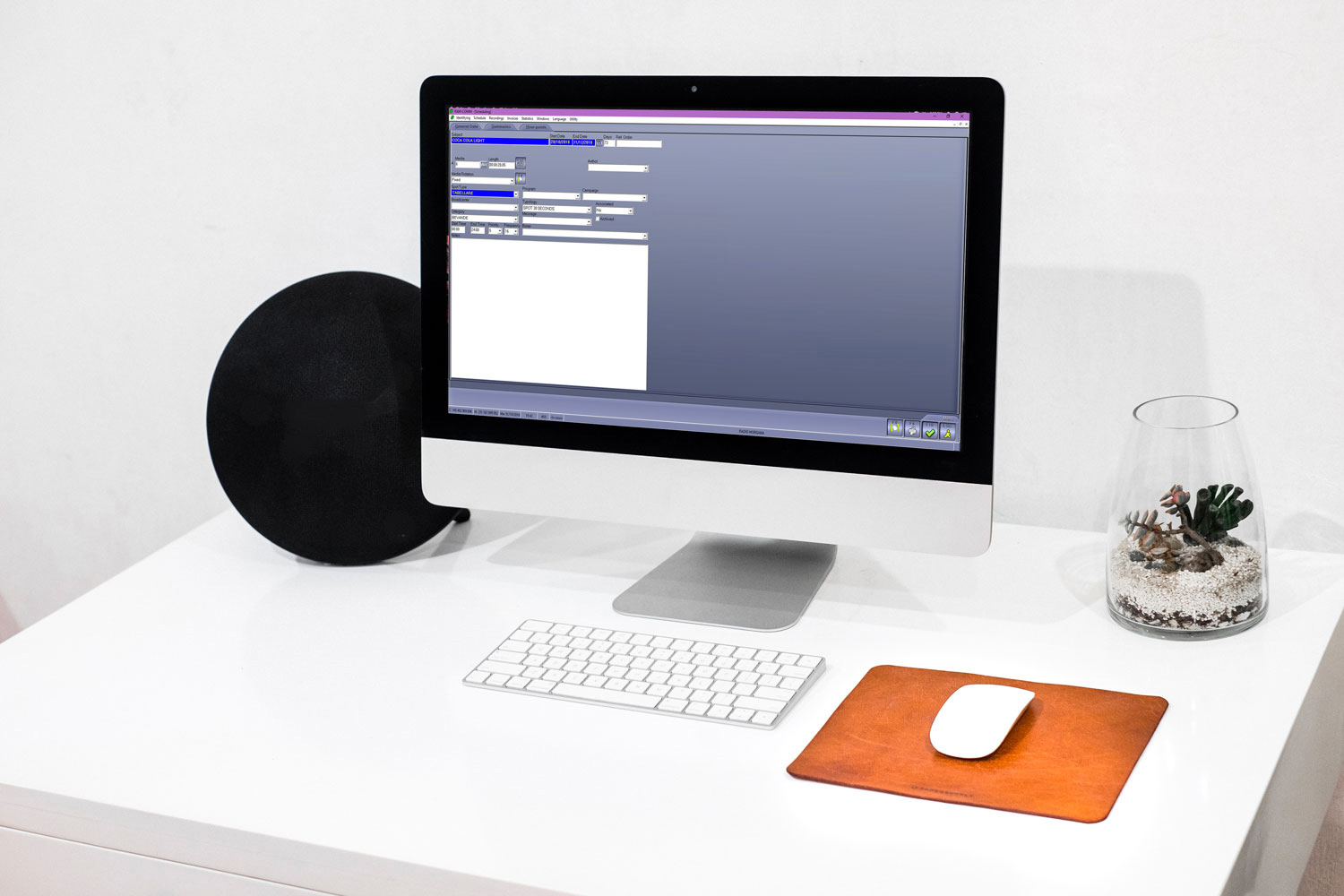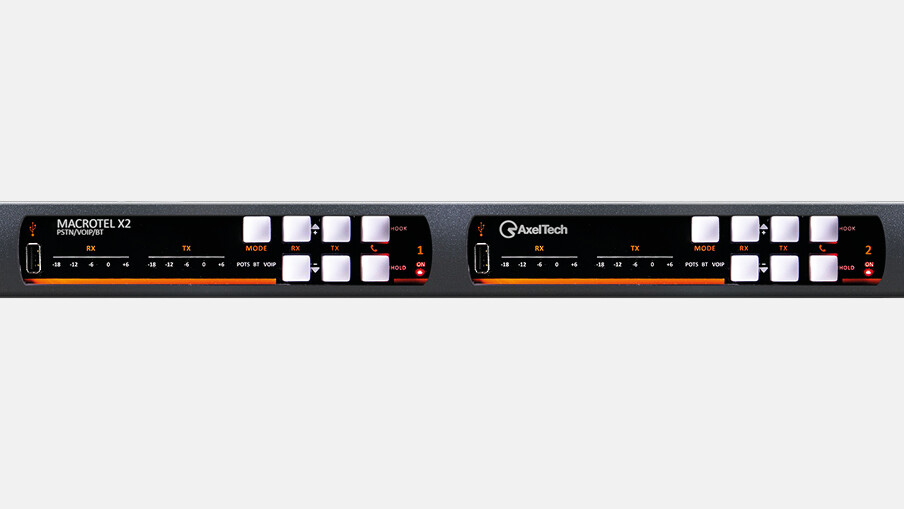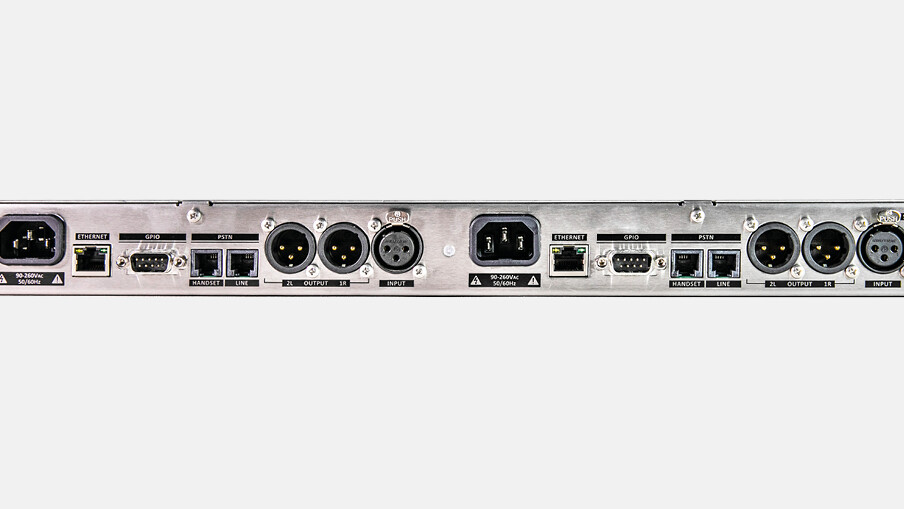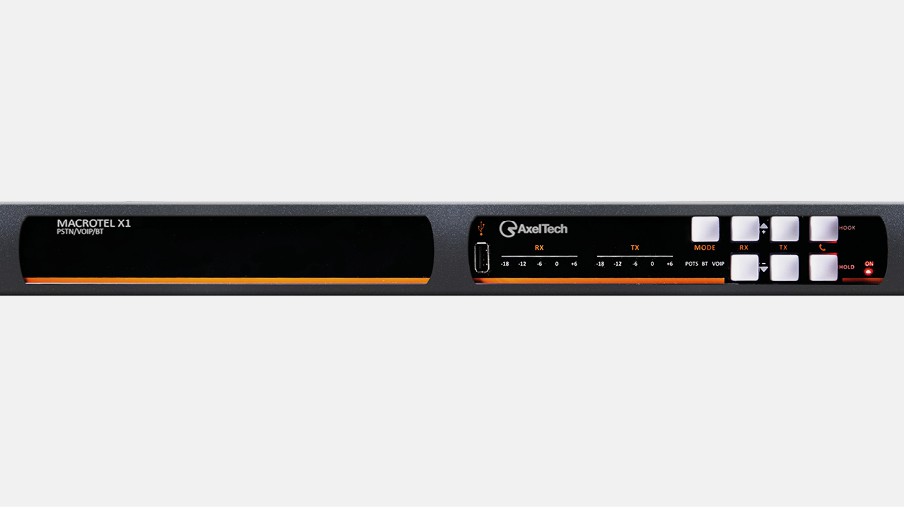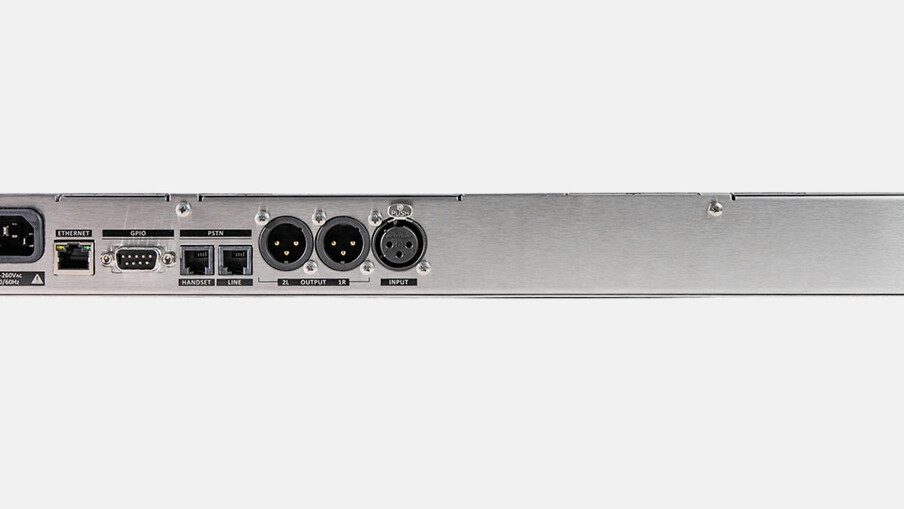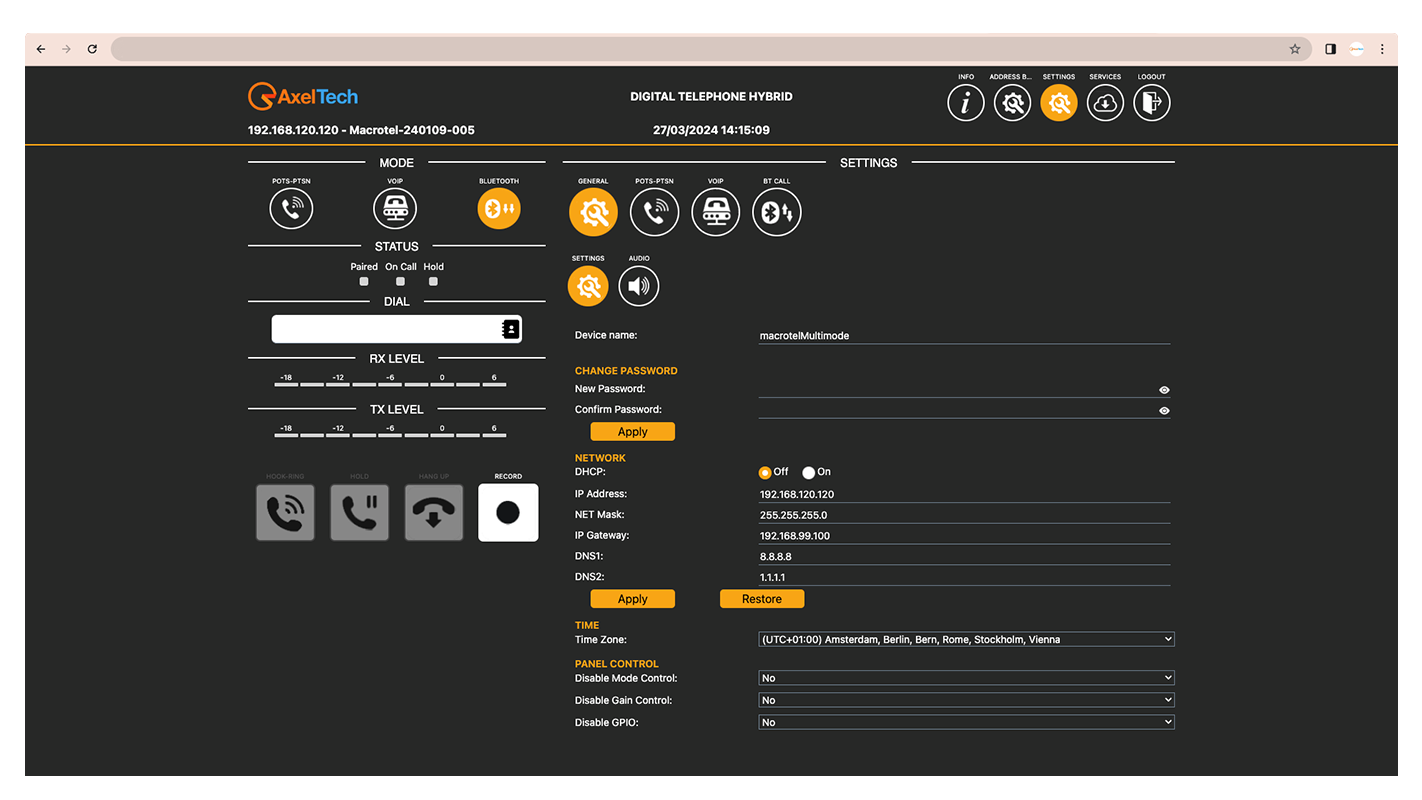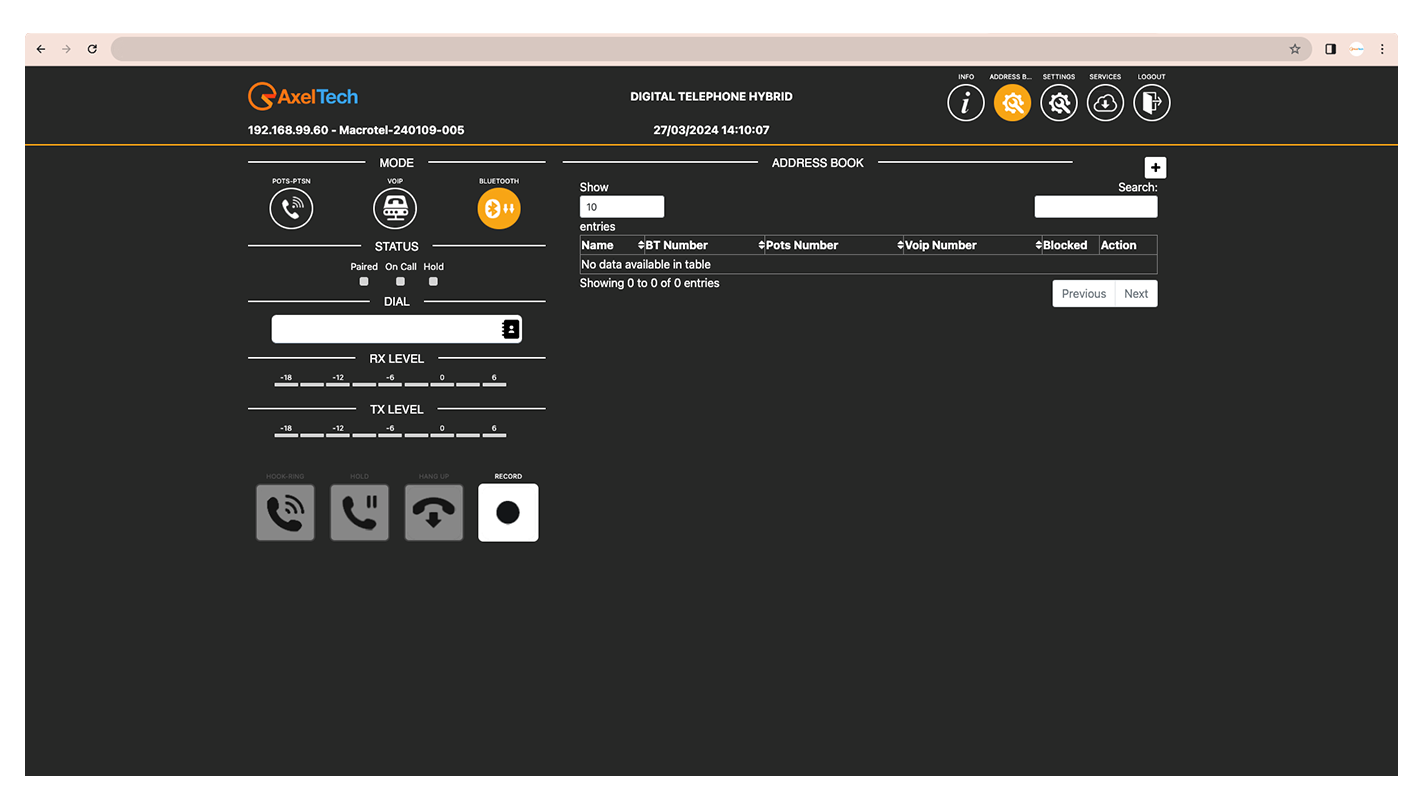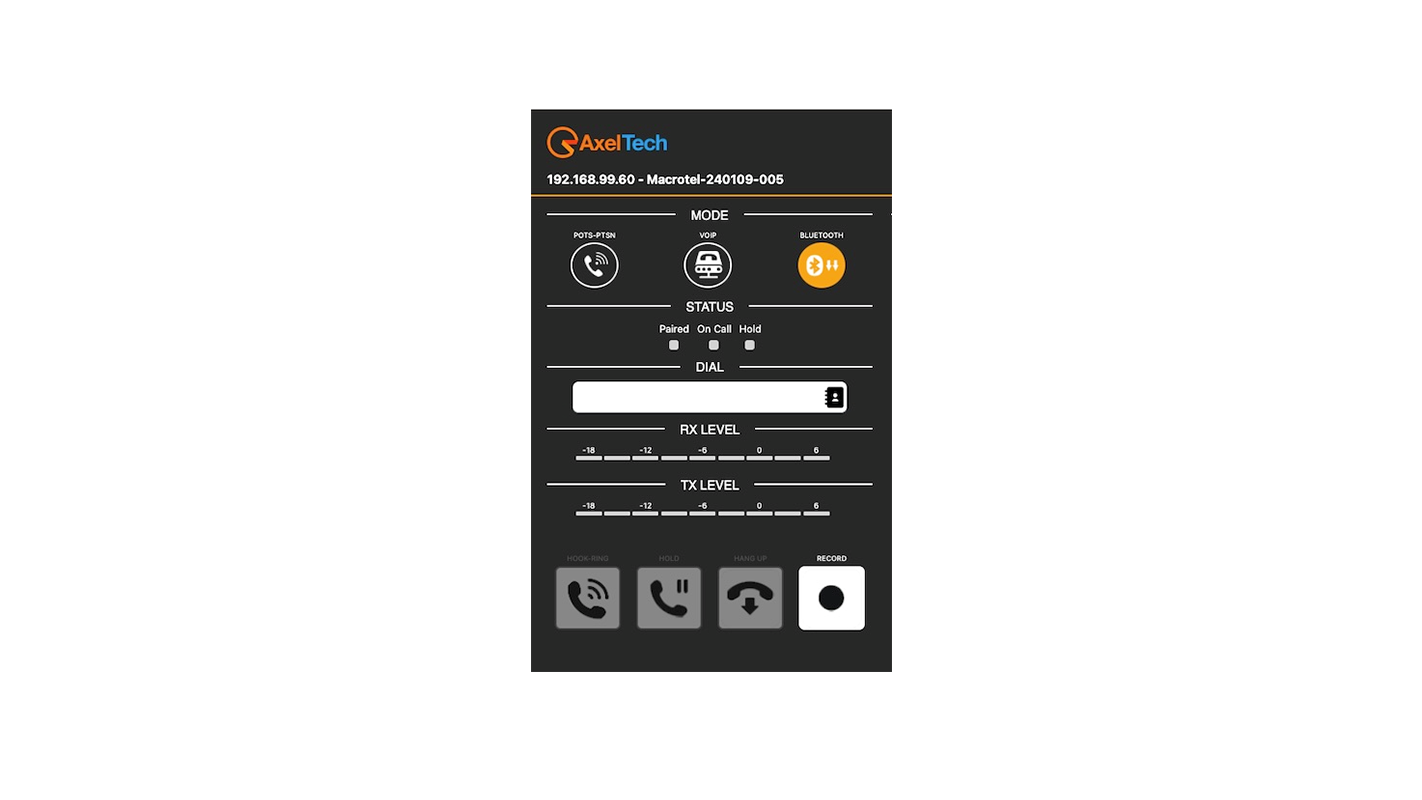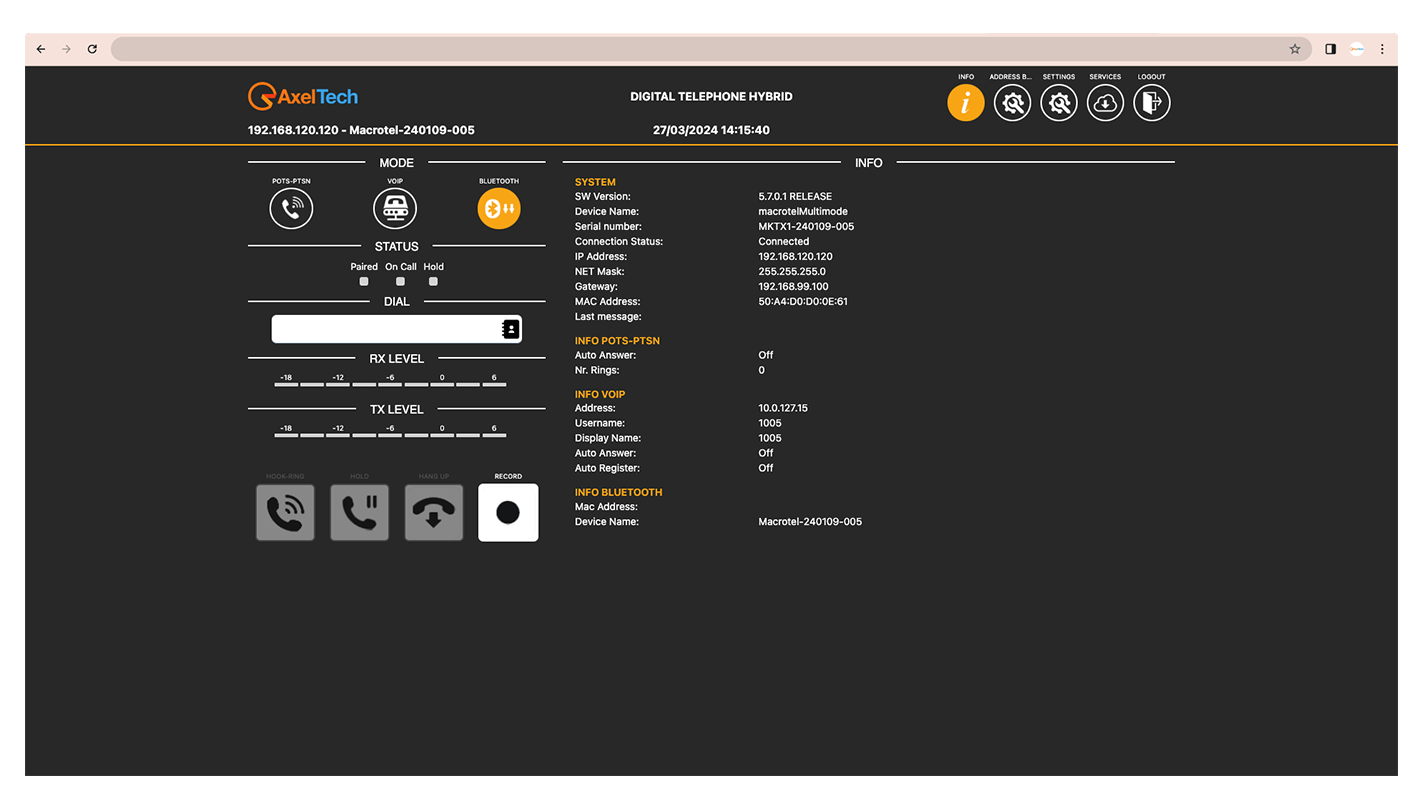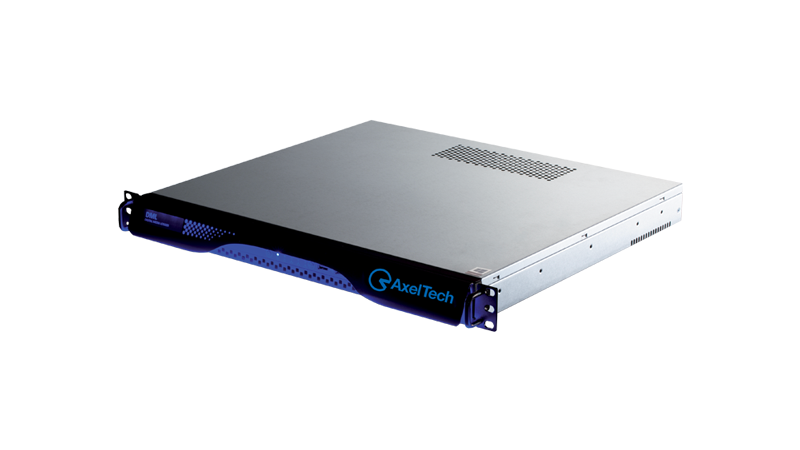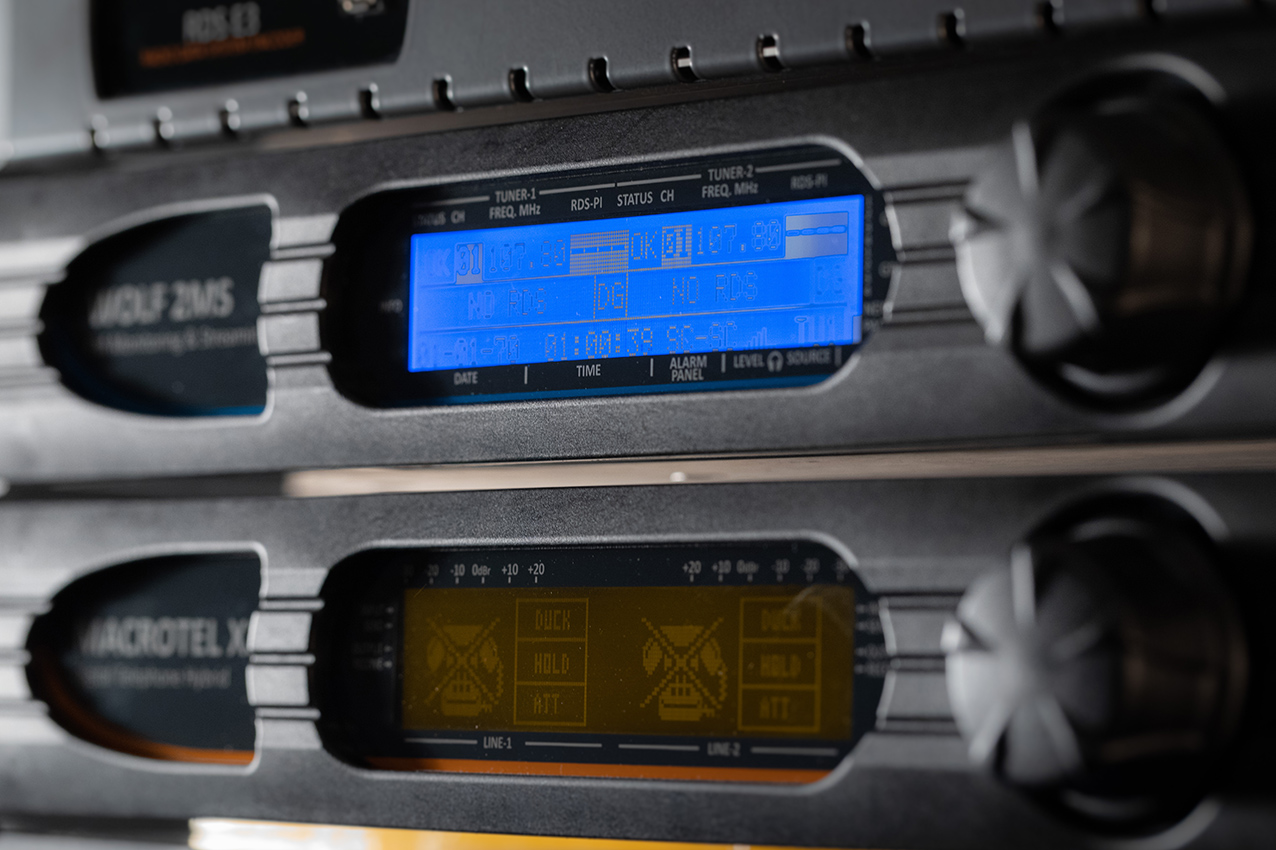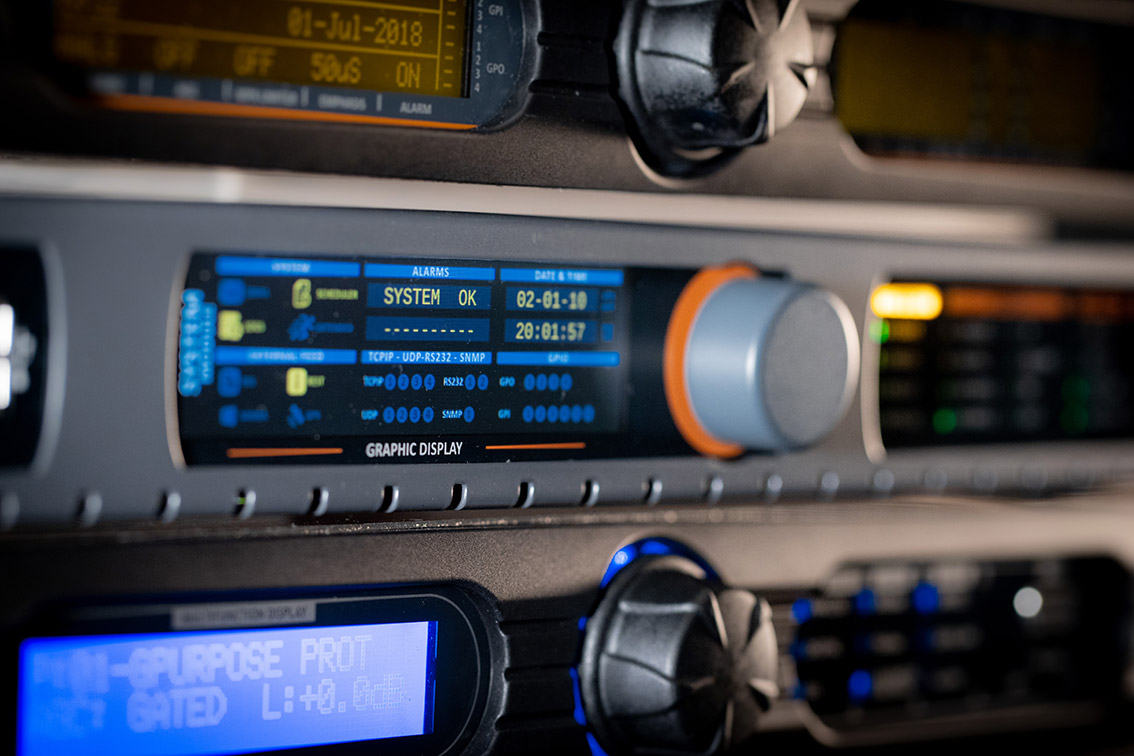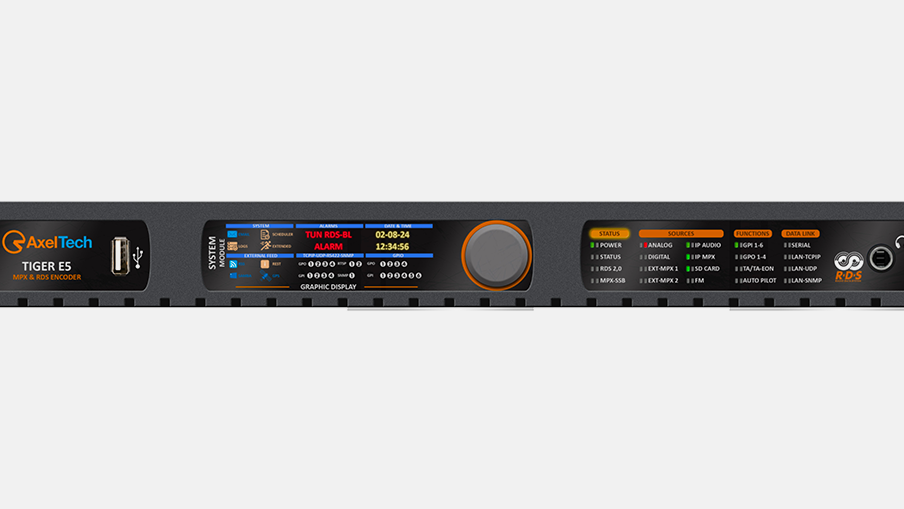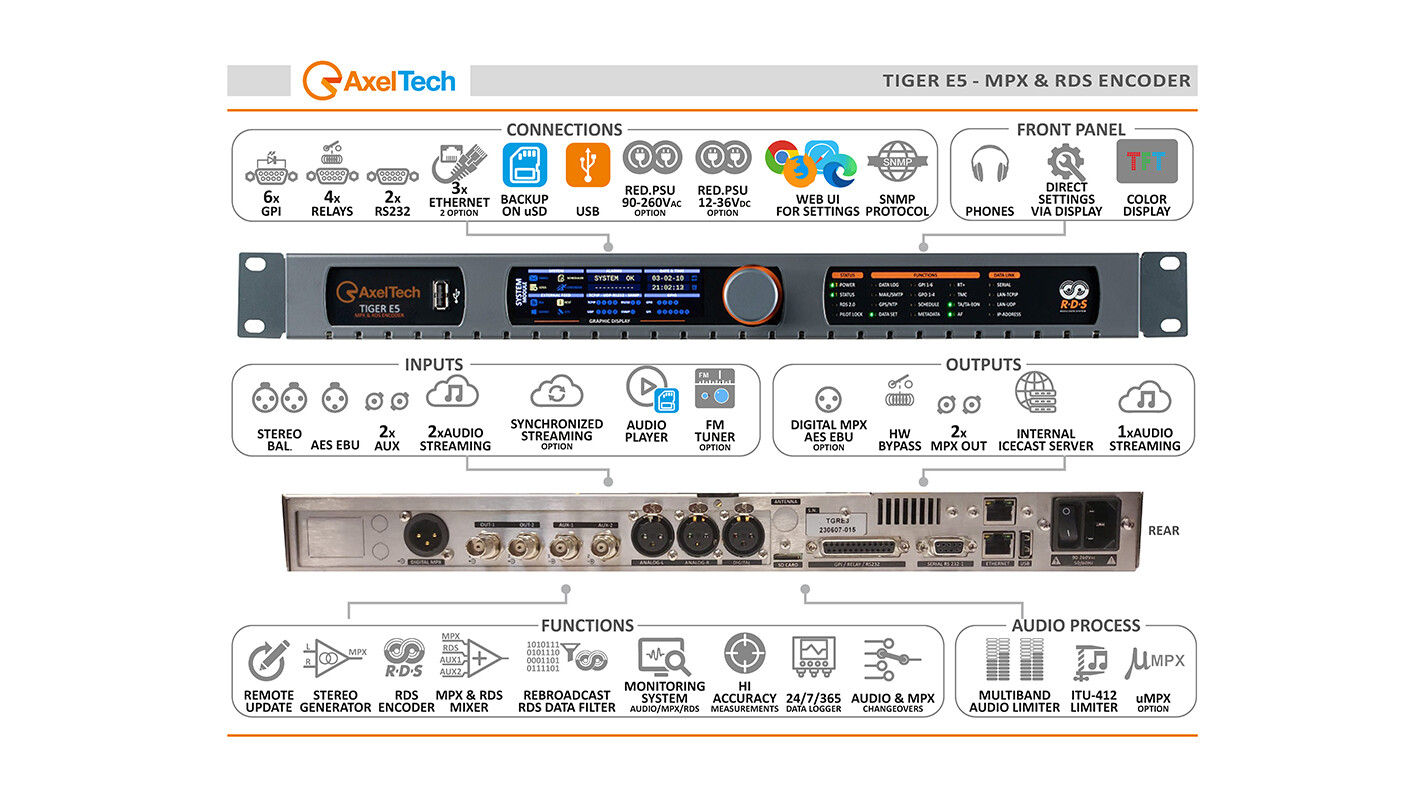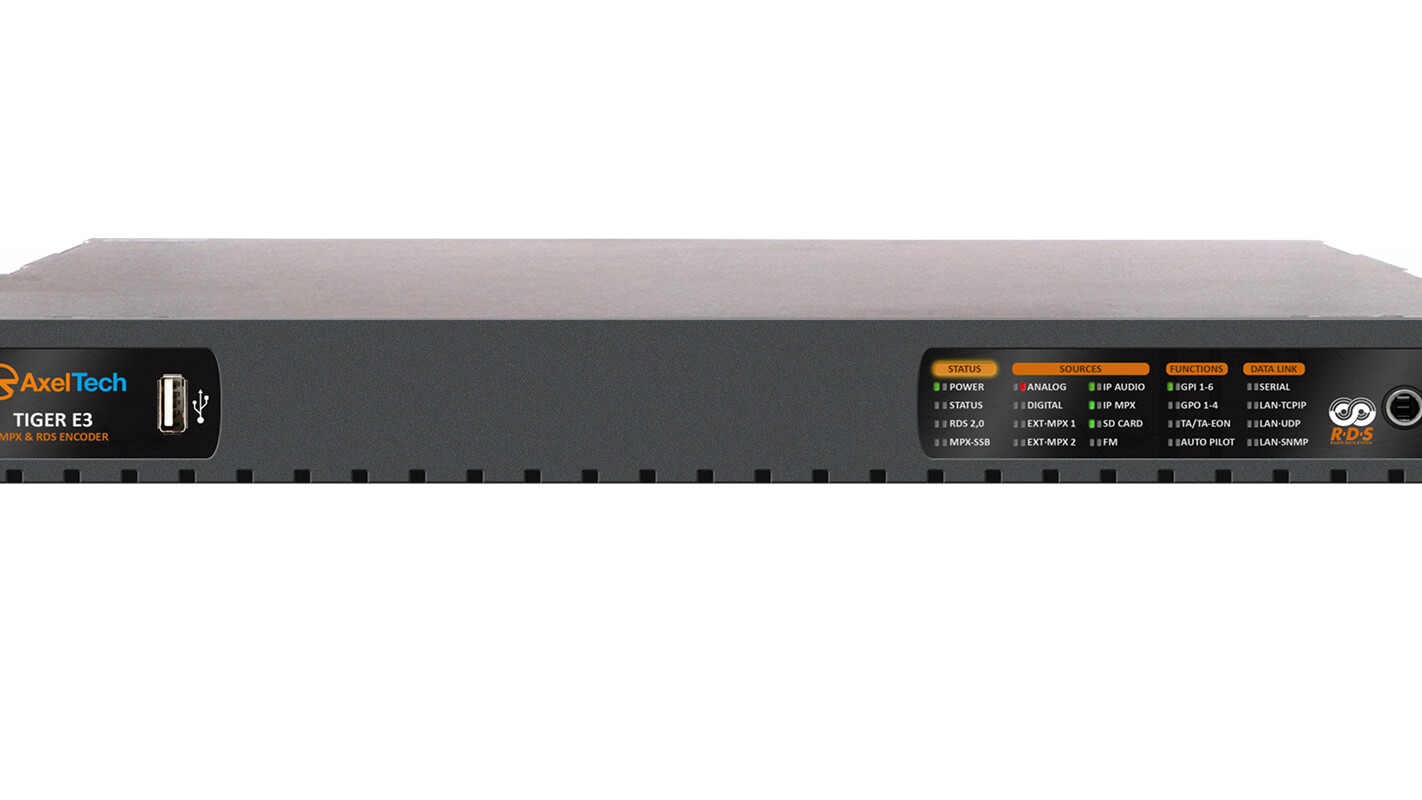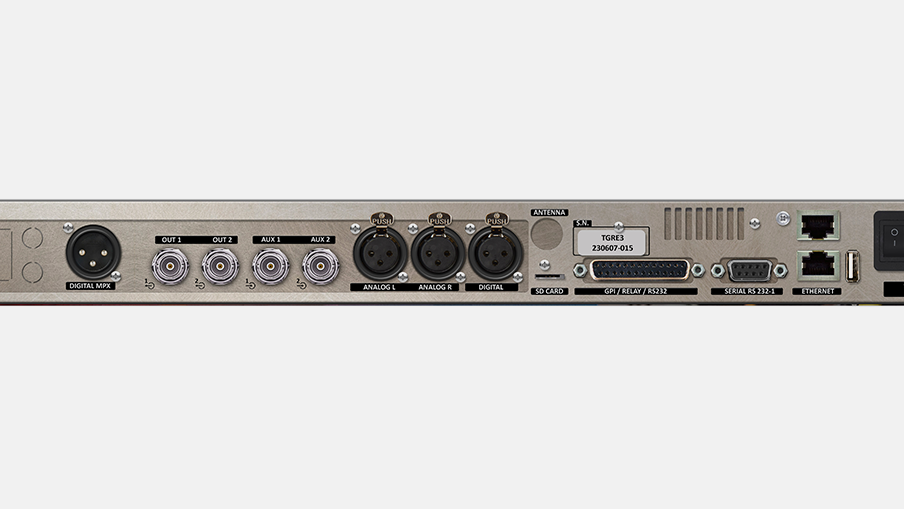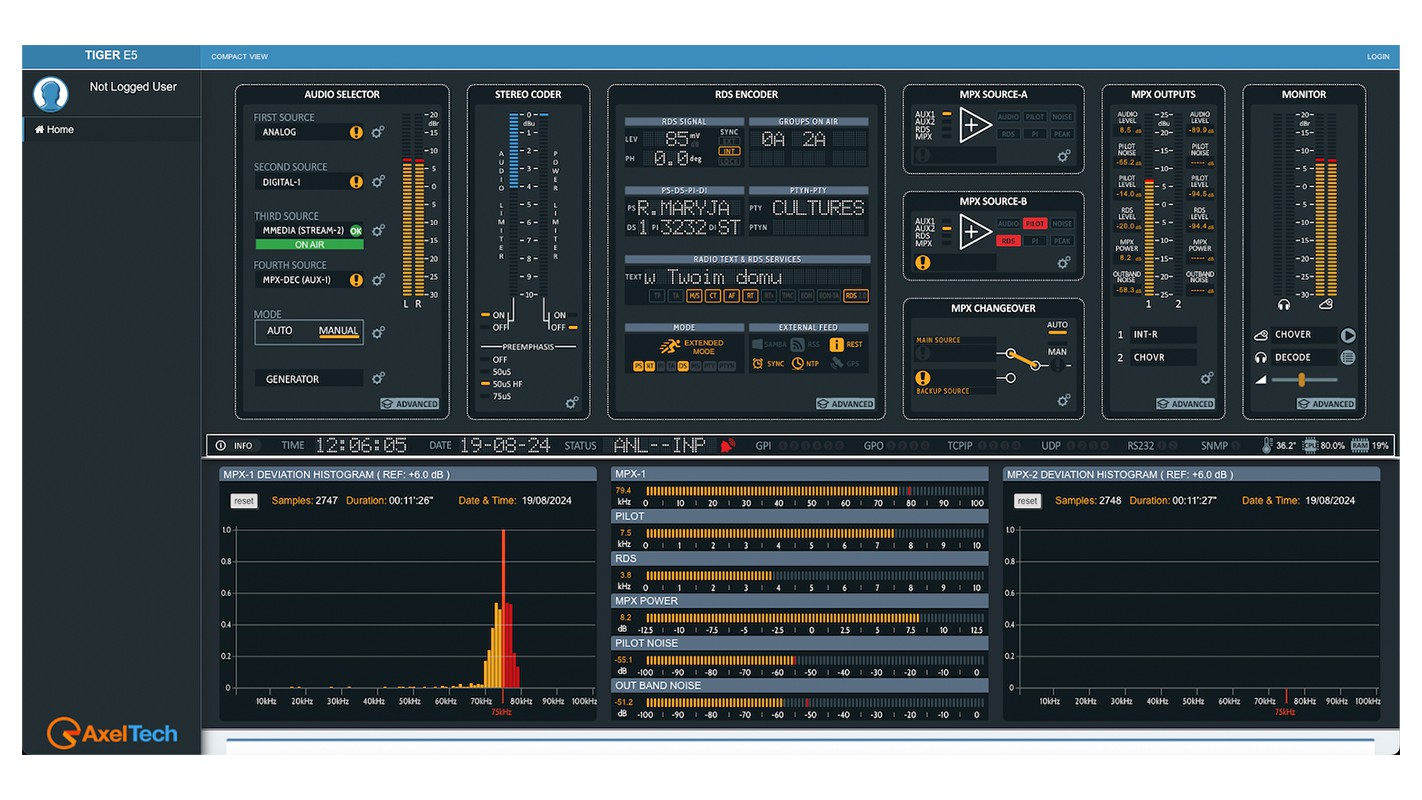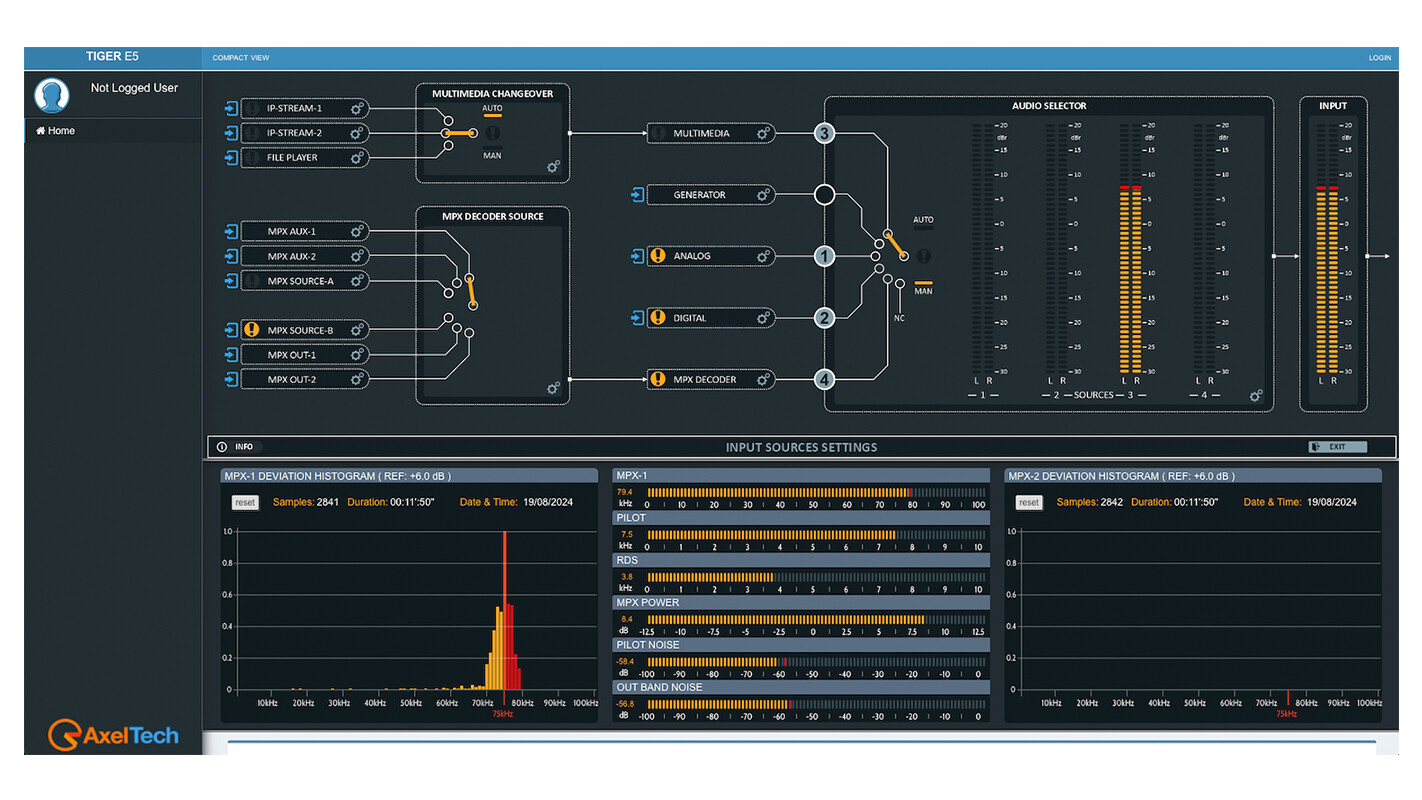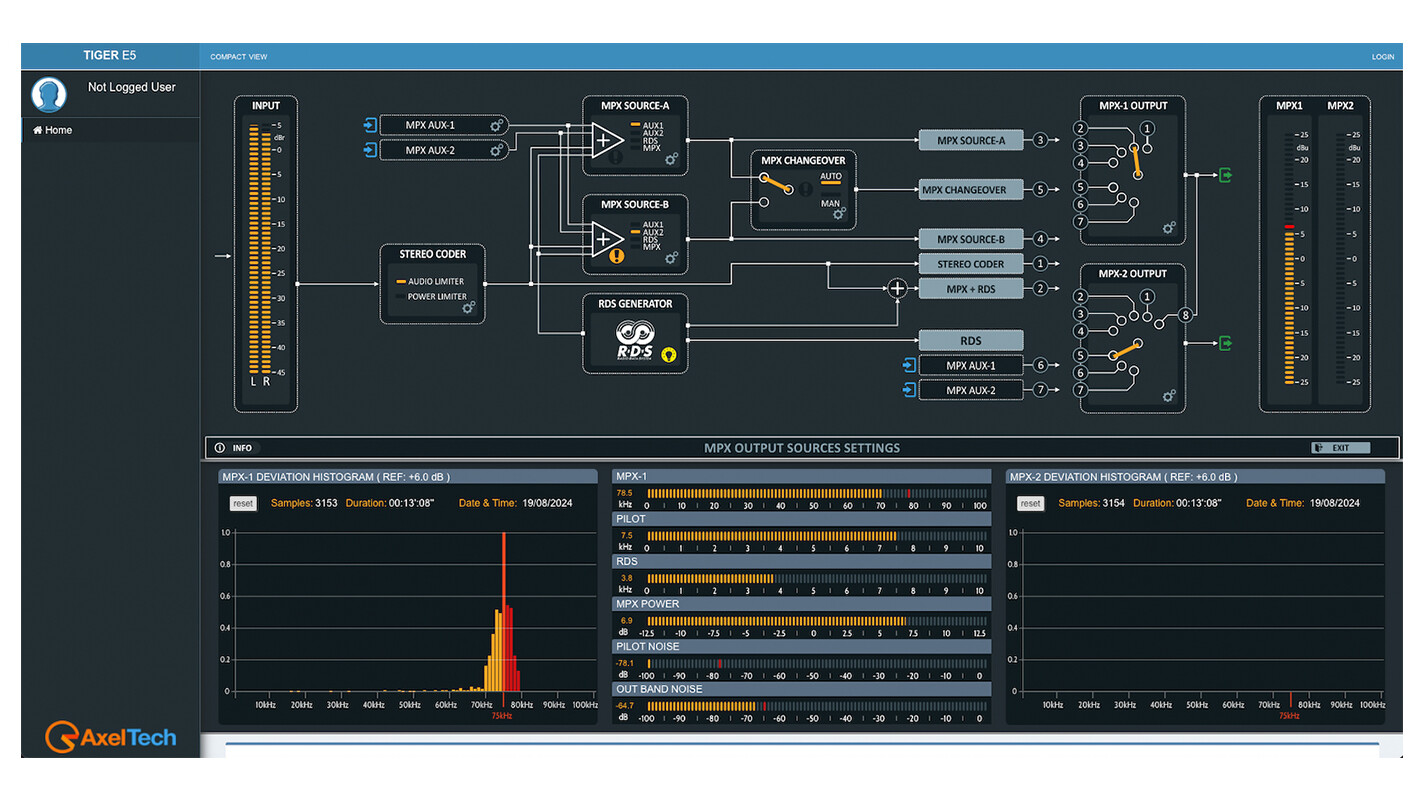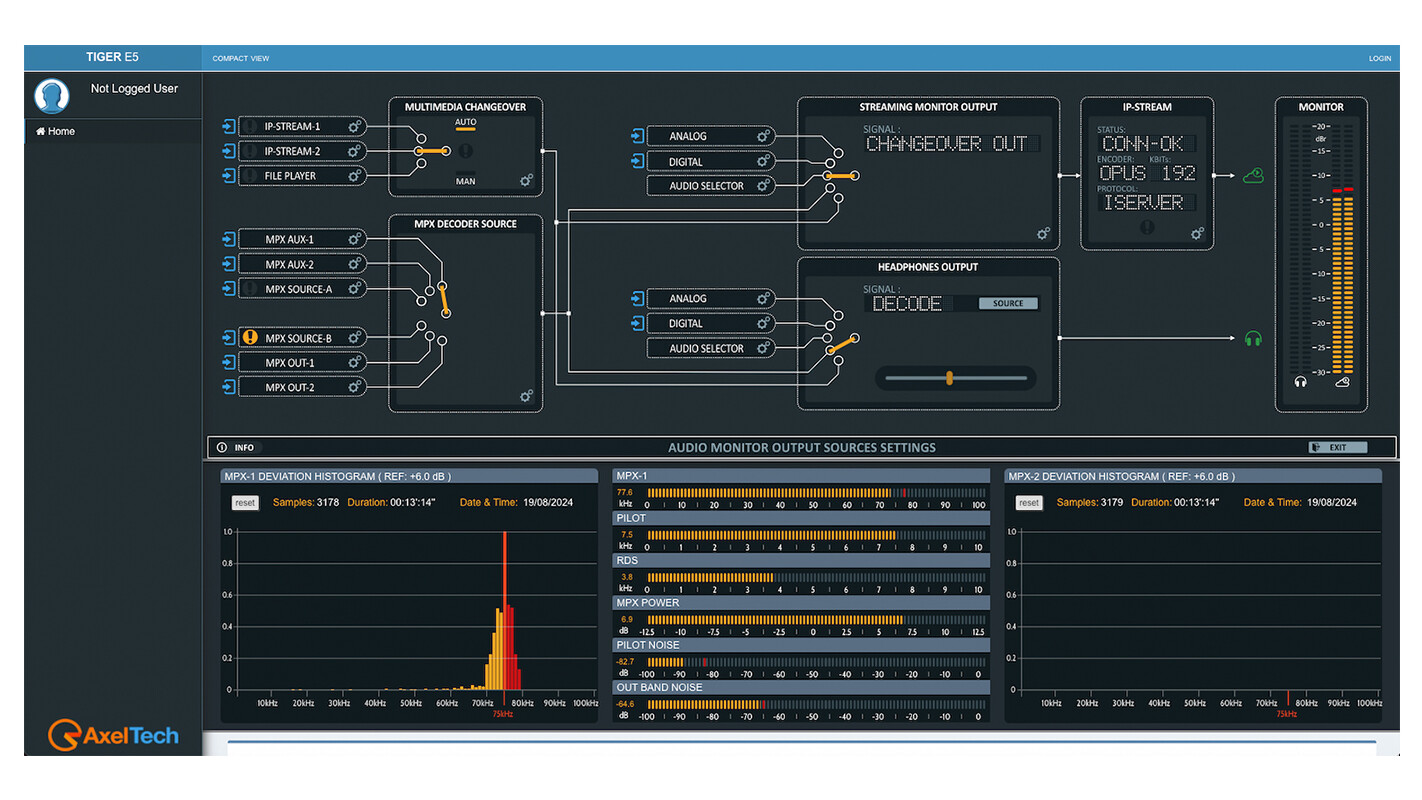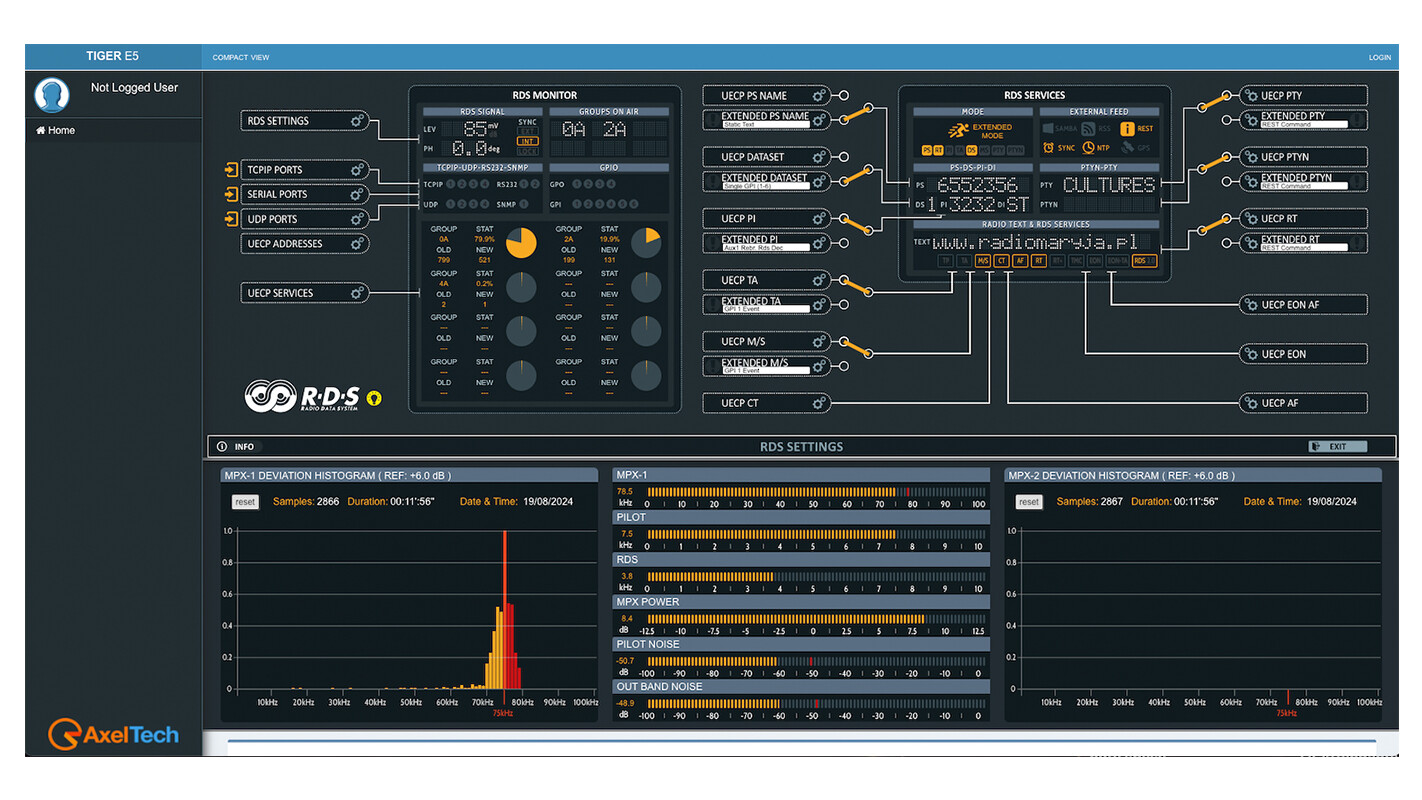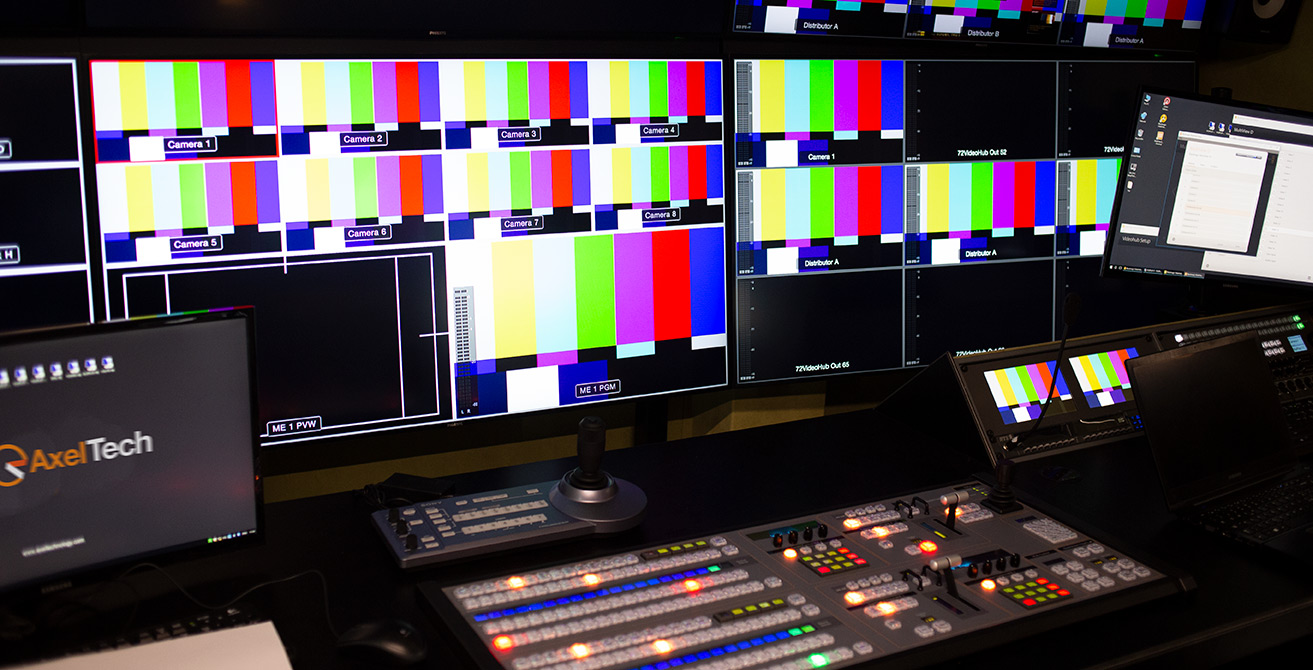Product Registration
Register Your Product
Registering your products is the best way to assure you will get the best support should you have questions on their installation or operation.
At this time, the form allows you to register only one product. After you submit the form, you will have the option of registering additional products.
RAM-COMM Radio
Premium
Traffic, Billing & Scheduling
The Sales Management Softwarefor Radio Stations
RAM-COMM RADIO is a 20+ years developed software supporting all business activities in the MARKETING & SALES department of a Radio Station. Its focus is Revenues!
The system is open to the contribution of other departments such as MANAGEMENT, ENGINEERING and PROGRAMMING. RAM-COMM is the #1 companion for all managers and professionals involved in the business flow of a Radio station.
The sales process basically just starts from a client’s order and then ends by collecting the payments for the provided services, however there are many activities to be involved for an excellent and complete operation.
RAM-COMM RADIO tracks them all:
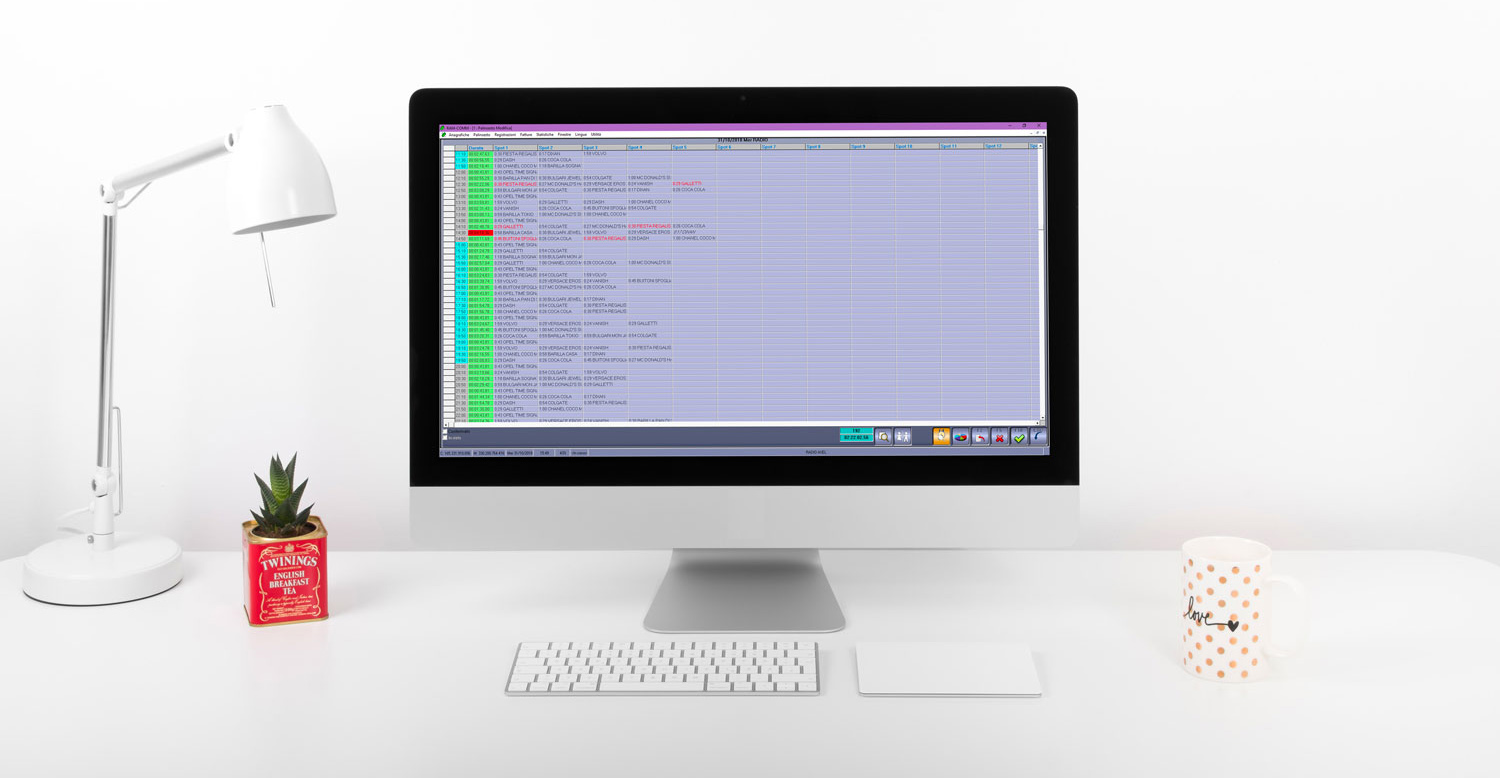
Technical Features
RAM-COMM RADIO is a software suitable to a single station or to Radio groups in all their distribution extensions (Radio, TV, Web, etc.); so multiple stations and splits of different advertising areas are fully supported.
RAM-COMM RADIO manages several users with customized administration of the rights associated to each user.
RAM-COMM RADIO offers a detailed and powerful setup of parameters, thus achieving the best customization of the Radio Station’s real functionality and specific business operation.
RAM-COMM RADIO offers an architecture design that manages:

Management Features
RAM-COMM RADIO is the essential tool for the company’s management to keep the business always under control. It provides the best tools to major necessities such as:
RAM-COMM RADIO also supports some crucial management activities:
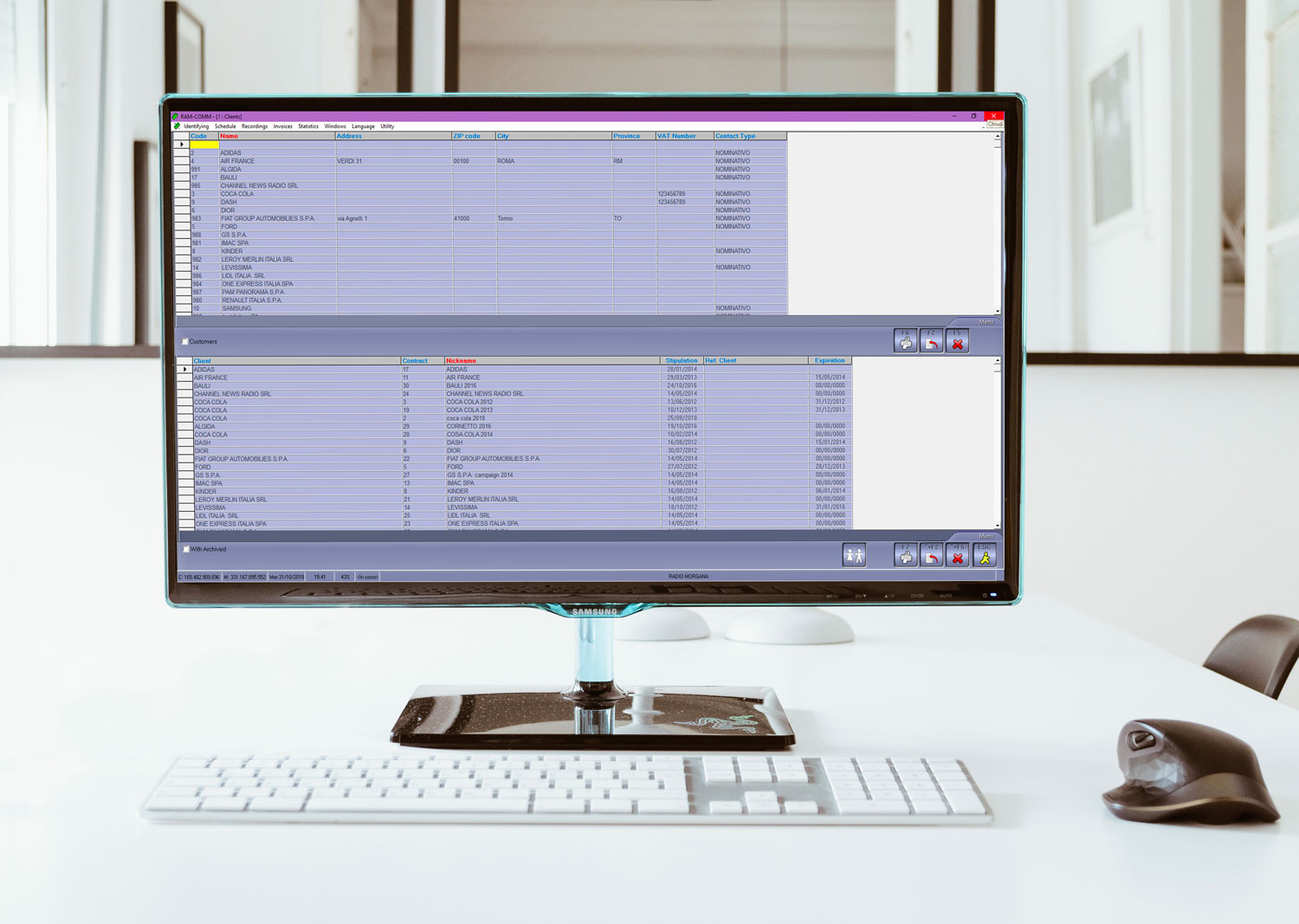
Traffic/Programming Features
RAM-COMM RADIO is highly recommended for scheduling purposes because it strongly reduces the time for the Traffic log creation. Save timing practices are available prior and after the schedule has been originated thanking to the traffic architecture and its immediate analysis tools.
The cluster creation is an amazing capability of RAM-COMM RADIO that gives the user the full control over elements of several formats that should be scheduled in the different and selected moments of an on-air hour. A different clock can be set for all hours as well just one for all hours of the day and of the week. Temporary shifts in the clusters can be easily achieved.
RAM-COMM RADIO is the best software to manage multi-station and multi-split environments. It has the highest flexibility to accomplish the most detailed orders.
RAM-COMM RADIO manages every kind of advertising format inside the station’s scheduling process:
Thanks to advanced automatic practices by inserting a few data and parameters you will obtain complete schedules with:
A possible control with manual operation to move items in the grid before or after the schedule process is easy and immediate thanking to a powerful Graphic User Interface.
Inserts of audio for the scheduled orders are matched by RAM-COMM RADIO with a Recording Studio feature to help administration in keeping suppliers and costs for the Production under control.

Sales Features
RAM-COMM RADIO keeps track of who is inserting an order or a contract thanking to the Author feature.
RAM-COMM RADIO provides commercial flexibility to the Sales Manager’s policies and decisions supporting his/her own on:
RAM-COMM RADIO also supports the Sales Manager’s analysis needs:
Ask for aquote now
Subscribe to our newsletter
Macrotel X1/X2 Multimode
Premium
Multimode Telephone Hybrid
Macrotel X1 Multimode and Macrotel X2 Multimode can manage one or two POTS (Plain Old Telephone Service) landline, VoIP, BT or GSM (with optional interface) telephone connections.
Audio enhancement features are custom designed to guarantee the best quality in phone calls, the internal framework based on DSP (Digital Signal Processor) works in real time taking care of the telephone signal process delivering the best possible audio performance. Macrotel X1/X2 Multimode it’s a Telephone Audio Processor able to shape the sound to optimize the yield of every single phone call.



Macrotel X1/X2 Multimode manages calls from POTS (Plain Old Telephone Service), VoIP, BT or GSM (optional) telephone connections and it embeds a web server and a simple and intuitive GUI accessible from any device and browser. For services synchronisation and logs Macrotel X1/X2 Multimode connects to a NTP server.
The main XLR input and output connectors can manage analogue or AES/EBU signals according to the device settings (AES/EBU input/output is optional) while a second XLR analogue output is also available. When in BT mode the two outputs act like a stereo balanced output.
Macrotel X1/X2 Multimode records telephone calls on a USB flash memory plugged in the USB front panel slot. Audio will be recorded in PCM format with a self-explaining filename based on date/time and can include the RX audio only or both RX and TX signals. It is also possible to send an RTP-PCM audio stream to an external PC to record the call, in this case the recording will include the RX audio only or both RX and TX signals.
Customers using any digital console of the Oxygen series can control Macrotel X1/X2 Multimode through the network, just adding its IP address. In this way there is no need to use a GPIO but you should only connect the Macrotel X1/X2 Multimode to the Oxygen Console through the Telco module.
A multiple GPIO port allows to manage the device from external equipment, like audio console or PC. System sends “Ring”, “Hold”, “Hook” and “REC” status and manages “Hook”, “Rec”, “Mode” and “Hold” functions. On the front panel an audio meters with 18 LEDs shows the RX and TX audio level of each channel. Additional LEDs show working Mode and Power on. Power supply can be used between 90 and 260 V AC – 47-63 Hz: this allows to use it worldwide.
- Multi-line digital telephone hybrid POTS/GSM/VOIP
- Automatic gain control (AGC);
- Digital echo canceller;
- Hold caller/attenuator;
- Expander and compressor;
- Audio limiter;
- Digital AGC processor with 3 bands fully parametric EQ;
- Analog and AES/EBU digital inputs and outputs (optional);
- 1 line and 2 lines models;
- POTS/PSTN;
- GSM Quad Band (optional);
- Integrated web server for remote control;
- Separate send and receive;
- LAN and USB ports;
- Auto-answer and disconnection;
- Balanced XLR I/O;
- Remote control software and dialer;
- Echo cancellation through a digital process on DSP (POTS);
- Advanced audio processing functions: AGC, parametric EQ, audio filters, compressor, expander and limiter;
- Internal Web Server allows device configuration;
- Automatic setup;
- 1 selectable XLR input: Analogue or AES/EBU (AES/EBU is optional);
- 1 selectable XLR output: Analogue or AES/EBU (AES/EBU is optional);
- 1 balanced XLR analogue output;
- Phone call recording in PCM format on USB support (RX only or RX+TX);
- Front panel led meters displaying RX/TX levels;
- Audio stream generation in RTP/PCM format (RX only or RX+TX);
- Front panel LED: Gain RX, Gain TX, Mode;
- “Hook” and “Hold line” lighted buttons;
- 4 GPI interfaces, 4 GPO interfaces;
- Integrated Caller Identifier (CID) – only for VOIP;
- Input and output call logs;
- G711-G722 VOIP audio codecs:
- Local telephone output (POTS).
GENERAL FUNCTIONS
Macrotel X1/X2 Multimode parameters can be configured through a web interface and its web user friendly GUI is available from any kind of device: PC, notebook, tablet, smartphone.
Macrotel X1/X2 Multimode supports TCP/IP standards such as HTTP for web GUI and UDP for streaming. Connection to external NTP server (Internal RTC with buffer) for time synch and ethernet/GPIO connection are available. Macrotel X1/X2 Multimode has stainless steel enclosure and a front panel with 22 levels and status LEDs. Power supply: 90-260V AC 47-63 Hz – 10 W (green approach).
POTS MODULE
Macrotel X1/X2 Multimode embeds standard RJ11 sockets for connecting to the telephone line and to an external telephone set. Internal DIAL system via DTMF for direct call is also available (so the external telephone set is not mandatory). It is possible to export logs phone numbers of incoming and outgoing calls and save them on a USB key (date, call time start, call time end). It is possible to set the automatic telephone line hooking after a settable number of rings and automatic telephone line release based on the “dropped line” tone (this feature can be disabled). Among the many customizable parameters Macrotel X1/X2 Multimode also has adjustable AGC, compressor/limiter and equalizer parameters and adjustable telephone band (with low or hi-cut).
BT MODULE
Macrotel X1/X2 Multimode has a fully certified BT version 3.0 audio module, compatible with BT version 2.1+EDR, 1.2 and 1.1. SIP version 2.0 (RFC 3261) is also on, together with adjustable AGC, compressor/limiter and equalizer parameters.
Embedded BT stack profiles: A2DP and HFP/HSP. Supports iAP profile discovery for iPhone® and iPod® BT accessories G.711u. Dual-channels differential audio input and output for highest quality audio. Certifications: FCC, IC, CE.
VoIP MODULE
The VoIP is available through a standard network RJ45 connector. Macrotel X1/X2 Multimode embeds SIP version 2.0 (RFC 3261). Authentication methods: SIP/IAX Dynamic Registration (Register) and SIP Static IP authentication. Supported audio codecs: G.711u (PCM u) | G.711a (PCM a) | G.722 | G.722.1 24/32. Automatic telephone line hooking (after a settable number of rings) and automatic telephone line release based on the “dropped line” tone (this feature can be disabled). Logs of phone numbers of incoming and outgoing calls (date, call time start, call time end) are available and can get exported, as all the other logs, on USB key. Adjustable AGC, compressor/limiter and equalizer parameters are on as well as for the others connections mode.
Please note that supported PBXs and phone service providers require interoperability with established VoIP providers. Such services are delivered via either a SIP-based IP PBX or through a cloud-based telephone service provider. These are complex services, therefore sometimes configuring AxelTech products to interact with them can be difficult or not possible.
AxelTech constantly updates its products to reach compatibility with these services, nevertheless incompatibilities are still possible and any change or update made by the service providers or by the PBXs themselves can cause problems with Macrotel X1/X2 Multimode in VoIP mode.
Here below you can find the list of the PBXs and VoIP service providers that have been used successfully by our customers with our products: these services are not fully compatible 100% of the time, as one update can interfere with the compatibility and of course we cannot guarantee to test them. We would suggest to customers who are considering using Macrotel X1/X2 Multimode with services other than those listed below, to contact our technical support team before purchasing this service.
We will allow the customer to return the AxelTech product and obtain a refund if the device is not compatible with the service he has selected. The following services are currently reported as compatible with AxelTech Products: Supported PBXs: Asterix Supported VoIP Providers: Olimon Tel.
DIGITAL
- Digital audio AES/EBU input/Output
| GENERAL | |
|---|---|
| Power supply: | 90-260 V AC / 47-63 Hz |
| Power consumption: | 10 W |
| Dimensions WxHxD: | 483 x 44,5 x 140 mm (1 rack unit 19”) |
| Weight: | < 2Kg |
| ANALOG AUDIO INPUT | |
|---|---|
| Connectors: | Balanced on XLR – EMI Suppression |
| Input impedance: | 50 KΩ |
| Adjustable via software: -9 dBu ÷ +15,0 dBu | |
| Level range: | –20,0 dBu ÷ + 20,0 dBu |
| Input level max.: | +20,0 dBu |
| CMRR input: | >60 dB (20 Hz ÷ 20 kHz) |
| DIGITAL AUDIO INPUT (OPTIONAL) | |
|---|---|
| Connectors: | Balanced on XLR – EMI Suppression |
| Input impedance: | 110 Ω |
| Format: | AES3/EBU & SPDIF |
| Sample rate: | 32, 44.1, 48, 64, 88.2, 96 KHz |
| Nominal Input Level (sensitivity): | From 0,0 dBFs to –24dBFs (0,1dB step) |
| Level range: | 0,0 dBFs ÷ -36dBFs |
| ANALOG AUDIO OUTPUT | |
|---|---|
| Connectors: | Balanced on XLR – EMI Suppression |
| Output impedance: | 47 Ω |
| Output level: | Adjustable via software: -9dBu ÷ +15,0 dBu |
| Level range: | –20,0dBu ÷ + 20,0dBu |
| Output level max.: | + 20,0dBu |
| CMRR output: | >60dB (20Hz ÷ 20kHz) |
| DIGITAL AUDIO OUTPUT (OPTIONAL) | |
|---|---|
| Connectors: | Balanced on XLR – EMI Suppression |
| Input impedance: | 110 Ω |
| Format: | AES3/EBU |
| Sample rate: | 32, 44.1, 48, 64, 88.2, 96 KHz |
| Nominal Input Level (sensitivity): | From 0,0 dBFs to –24dBFs |
| Level range: | 0,0 dBFs ÷ -36dBFs |
| POTS INTERFACE | |
|---|---|
| Connectors: | 2x RJ11 Line and Telephone set |
| Output impedance: | Selectable |
| Bandwidth telephone line | 170Hz - 4.6kHz |
| Echo canceller suppression: | > 40dB |
| Signal to Noise Ratio (S/N) | ≤ -60dBu (Ref.0dB @1KHz Analog Out) |
| Frequency Response | ± 3dB (TBR21) ± 2dB (600 Ω) |
| Audio distortion | ≤ 0.2% (Ref.0dB @1KHz Analog Out) |
| VOIP INTERFACE | |
|---|---|
| Protocol: | SIP Version 2.0 - RFC 3261 |
| Codec Audio Compatibility: | G.711u (PCM u), G.711a (PCM a), G.722, G.722.1 24/32 |
| Authentication Methods: | SIP/IAX Dynamic Registration (Register) SIP Static IP authentication |
| BT INTERFACE | |
|---|---|
| Compatibility: | Fully certified BT version 3.0 audio module, Fully compatible with BT version 2.1+EDR Compatible with 1.2 and 1.1 |
| Connection mode: | Embedded BT stack profiles: A2DP and HFP/HSP |
| IOS: | Supports iAP profile discovery for iPhone® and iPod® BT accessories G.711u (PCM u) |
| GENERAL | |
|---|---|
| GPIO Inputs/Outputs: | 4 GPI 4 GPO |
| Communication Port: | 1xLAN |
| Front Panel LEDs: | 18+4+2 |
| USB: | Type A |
| Operating Temperature: | 0°C ÷ 50°C |
| COMMUNICATION | |
|---|---|
| Configuration Software: | Web Server |
| Password Protection: | Yes |
| UDP, TCP, HTTP, SNTP. | Yes |
| Supported Network Protocols: | HTTP, UDP, TCP, NTP, |
RAM-COMM TV
Premium
Traffic, Billing & Scheduling
The Complete Traffic & Business Software for Tv Stations
RAM-COMM TV is a multi-station and multi-user software that manages all business processes of the Marketing & Sales department, from customer contact to invoicing and billing by Management/Administration.
RAM-COMM TV is able to manage several users, with full administration control of the different rights associated to each single user; the software is also suitable to small stations as well as large publishing groups; multiple channels and advertising areas, the so called “splits”, are active.
RAM-COMM TV offers special features to allow the best focus on customers’ contact information, on media Import/Export from agencies; same voice separation on spots and business and sales accurate reporting are on; the software also handles sales reps’ commissions and sales accounts, business contracts and invoicing/billing.
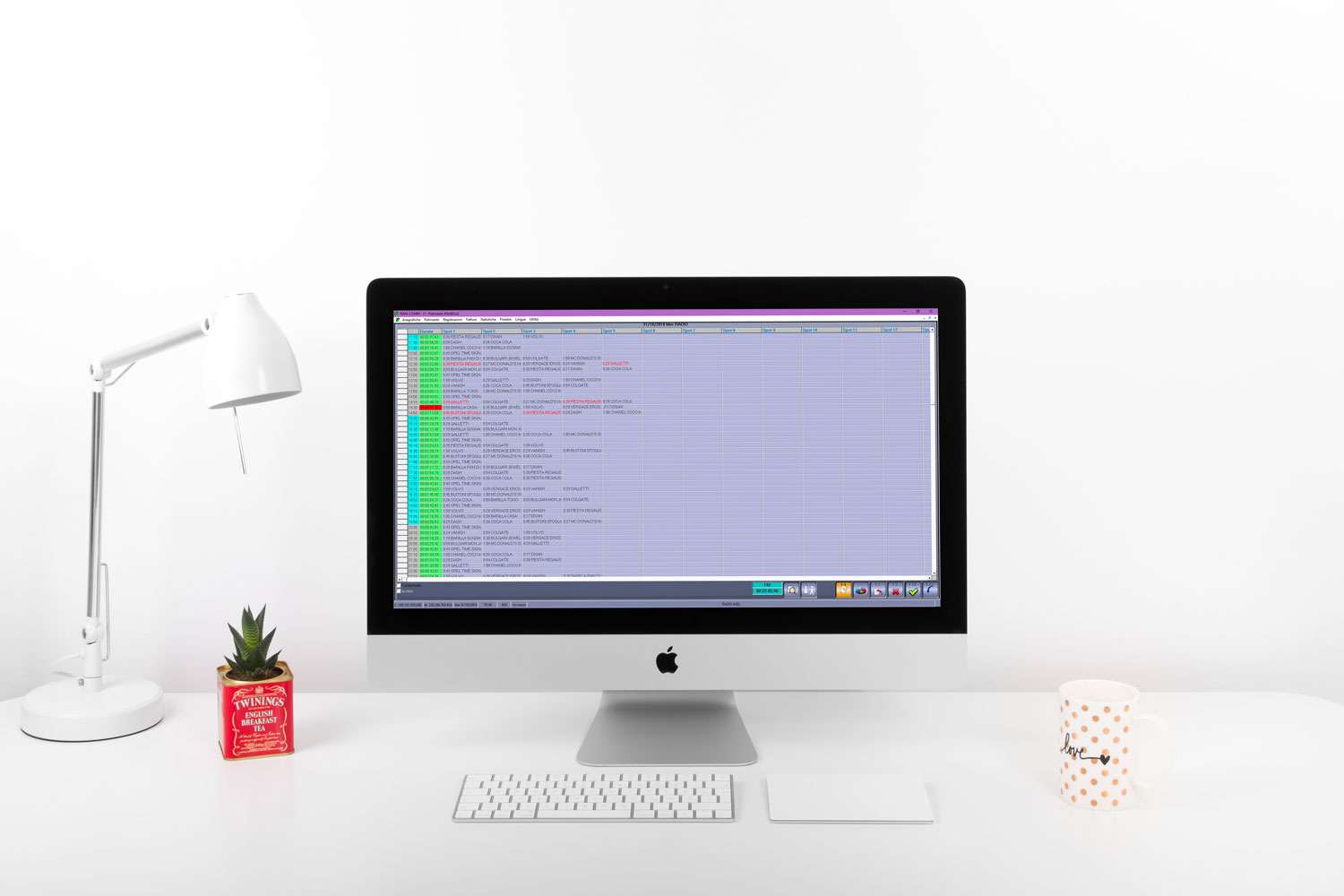
Main Features
Multi-user architecture with rights management
Complete customer and contract management
Advertising scheduling: duration, rotation, priority, category conflict management
Advertising splitting according to areas/territories
Commercial reports and statistics for customer and board
Advertising certification

RAM-COMM TV has a very effective built-in and multi-purpose scheduler developed thanking to AxelTech programming experience in order to create the best possible log of Radio for any sort of advertising on-air element or segment:
- Spots
- Billboards/Sponsorships
- Commercial Announcements
- Promos
- And more…

The software is strongly recommended in the scheduling process as it saves time for the advertising log creation.
Thanks to advanced automatic practices RAM-COMM RADIO provides a complete planning with crucial controls:
- Automatic fill of the hour selected points/clusters
- Automatic rotation
- Priority control
- Subject rotation
- Automatic managing of the “tails”
- Product conflicts
- Pre and post spot insertion
- Manual Edit

Another advanced feature of RAM-COMM RADIO is the automatic fill of the split-zone clusters; this is achieved using
- Premium spots
- Stand-by spots
- Promos
- Audio fillers selected by duration
RAM-COMM is the essential tool for the company’s management to keep the business always under control.
Due to the vast availability of its specific electronic and printed reports and statistics, RAM-COMM TV is the best tool to manage and to optimize the business of your company; it provides a clear, updated and objective outlook in order to allow the sales manager to take all the most effective commercial initiatives and policy decisions.
It provides the best tools to major reports such as:
- Number and typology of scheduled contracts
- Present and future outcomes
- Expiring contracts for the forthcoming period
- Business potential of the representatives
- Agent areas and management
- Contracts to be invoiced next month
- And many more..
Ask for aquote now
Subscribe to our newsletter
DML Video
Premium
Video Logger
Digital Media Logger
Media logging is the process of capturing audio and video, usually in low quality format, and preserving the recordings for a large number of days, usually 2 or 3 months. In most countries media logging is obligatory by law for all TV broadcasters , but it can also be used for advertisement certification, audio/video quality surveillance, competition monitoring and media rebroadcasting.
DML VideoMain Specs
Archive any logging period 30, 60, 90, 180, 365 days
Single channel and multiple channels configuration
Compatible with WDM Tuner cards, DVB-T, DVB-S/S2, DVB-C, ATSC, analog TV
Compatible with BMD Decklink and Intensity
Ip input in UDP, RTP, RTSP, RTMP, HTTP
Capture resolutions CIF, SD and HD
Input rescale and crop with aspect ratio correction
Audio delay for AV sync shifting
Continuous 7x24 recording without any frame loss between file segments
Formats AVI (DivX), ASF (Windows media), MPEG1, MPEG2, MP4 (H264 and AAC), FLV
Customizable video and audio bitrates and advanced parameters
Customizable segmentation per file duration (typically 60 min), file size or at midnight
Automatic delete of oldest files when disk space is low
Virtual source creation for use with 3rd party sw (encoders, etc)
Ip streaming in WMV and RTMP (FMLE)
CG overlay with antialiased text for name of channel, date and time
Logo overlay for watermarking
Volume adjustment with compressor and AGC
Alarm notification via E-mail and SMS for black video, freeze, no audio, archive length, etc.
Accurate statistics on capture process and datarates
Accurate GPS (receiver optional) Date and Time synchronization
Data security featuring RAID architecture or software mirror, content is preserved in case of disk failure
Remote system monitoring from any LAN or Internet connected Pc.
Easy content export/conversion with Mark-In and Out points. Flexible transcoding to most of video formats
Multiple language GUI
Main Specs


DML Video Recorder:
Non Stop A/V Logging
and IP Streaming

DML records A/V contents coming from the widest variety of sources (composite, Y/C, SDI, HDMI, Antenna, SAT, DVBT, DVBC, ATSC, IP, etc) and stores them on Hard Disk (recordings stay on line depending on hard disks capacity, usually: 30/60/90 days as required by laws in many countries).
DML system is totally maintenance free and oldest recordings are overwritten by the newest ones automatically. Video compression/quality vary according to the archive space and the logging period chosen. Recording quality may be as high as HD BROADCAST quality. Content is accessible from the DML as well from any networked computer, never stopping the recording.
System status is constantly monitored either locally, thanks to
DML-embedded tools, as well as from any networked computer running the DML Monitor free software.
Whenever rising, alarms may be notified via email or SMS.
DML Recorder supports a large variety of video formats, compressions and resolutions, from the efficient DIVX and MP4 in H264 and AAC, to the more traditional MPEG-1, MPEG-2. DML files are standard multimedia files, which can also be played on any ordinary multimedia player.
Simultaneous capture and Windows Media or RTMP Flash streaming allows viewing of encoded A/V signal from anywhere through Internet. Date and time display are superimposed onto video signal or embedded into the A/V data stream. Accurate date and time certification is guaranteed through synchronization to GPS satellites time reference with AxelTech’s Sat Time Synchronizer receiver.
DML Recorder status is constantly monitored by auto-diagnostic tools. In case of alarms, the operator is warned via email or SMS.
Monitored parameters: Disk activity / video presence / video freeze / audio presence / instant data-rate / average data-rate / A/V stream integrity. DML architecture is future-proof and conceived for the easiest integration of any new video format.
With the free DML Player software, content can be easily edited and downloaded on external media and converted to the most popular video formats.
DML Player:
content searching,
browsing and conversion

DML Player is a free software application for real time content browsing from any networked Pc. Exclusive simultaneous multi-channel playback allows accurate audio temporal comparison. The calendar window shows the available recordings. Just ‘click’ on desired date and time to start playout. Play speed is variable from 0.5x to 16x. Go To date / time function allows direct playback to specific recorded events. Capability to jump to specific date and time using generic automation Log files.
Fast export or conversion in native or popular formats to fit all distribution and storage needs.
Mark point positioning is frame-accurate using handy scroll & drag bars, along with keyboard shortcuts.
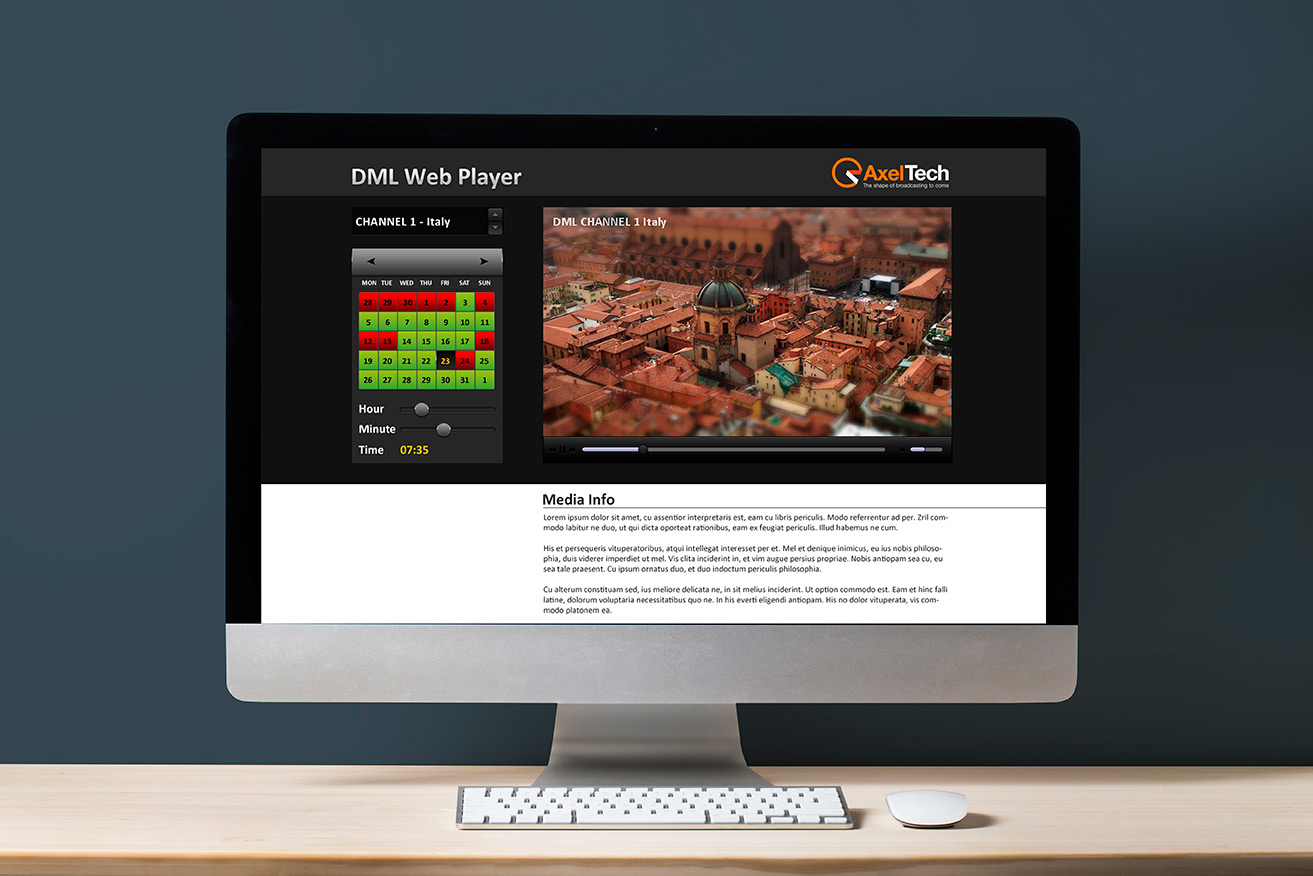
DML Monitor:
remote monitoring via web
DML Monitor is a free software tool which allows monitoring in real time through LAN and Internet of one or more DML units. System and recording supervision will be available from anywhere. DML Monitor displays current video frame for each recorder, together with status info, systems logs, streaming audio and the upcoming of alarms or parameters out of range.
DML Web Viewer:
content searching and browsing via web
DML Web Viewer is a free server application for real time viewing from any Internet browser and works on windows, linux, mac or any handheld device. The calendar widget shows the available recordings. Just ‘click’ on desired date and time to start listening. Configuring main router ports allows viewing from internet from any remote location.
Lot of options
DML Copy
DML Copy is an optional software which copies files from multiple DML recorder units to centralized storage systems. In multiple channel systems it is advised to deplay a central storage unit with RAID 5 or 6 redundancy rather then on the single capture units. DML Copy will provide a “slow” and controlled copy service to avoid saturating LAN bandwidth.

DML Supervisor
Supervisor is an optional software which monitors multiple unit status and connected devices, managing hierarchical alarm levels and notification via email, SMS, fax, etc. Suggested for multichannel environments.
XMAM
XMAM is an optional archiving and catalogue system which provides fast and simple integration with DML allowing perpetual archiving of selected media. XMAM is a Web-based, user focused interface that supports access and processing of digital assets like video, audio, images, documents and presentations. XMAM supports standard web browser navigation without additional client software needed.
Sat Time Synchronizer
STS is the optional antenna receiver and software which allows an extremely accurate synchronization of Pc clock to GPS satellite reference. Recomended for tamper-proof date / time certification.
Complete Multiple channel full Turnkey solutions
AxelTech can provide multiple channels turnkey systems with DML capture units, file servers with redundant storage, LAN infrastructure, KVM switches, completely precabled and configured in AxelTech’s laboratories. Monitoring and editing desks are customized according to customer needs allowing coroporate and government organizations to take advantage of a fail proof solution. Local installation, training, baby sitting and after sales support is provided directly by AxelTech.

Minimum system requirements
System requirements may vary on number of captured channels and video quality.
Intel i-7
8 GB RAM
Win 10
Separate disk partition for each channel
1 TB per 1 channel 90 days 1 Mb/s
Main Specs
Ask for aquote now
Subscribe to our newsletter
Wolf 1MS - 2MS
Wolf 1MS & Wolf 2MS
FM Radio Monitoring
Everything under control
Wolf 2MS and 1MS are state-of-the-art FM Radio Monitoring devices, designed to control the signal presence and quality over an FM Distribution Network.
Onboard twin tuners allow to accurately scan frequencies, they offer high performances in FM reception, MPX audio encoding and RDS data streaming. This cutting-edge equipment features three main operating modes: continuously reception, bandscan and smart bandscan.
With FM static mode the user can focus on a single channel, selected and monitored exclusively. Thanks to the scan mode up to 32 channels for each tuner can be scanned and supervised in a single analysis. FM static mode also receives up to 64 memories. Wolf 1MS and 2MS allow to manage accurately RF, MPX, RDS, Audio and RDS data dynamic services. In smart mode the channel scan time is adjusted automatically according to instantaneous measurements requirements.
Wolf 1MS and 2MS are the ideal Probes for a Network Management System.
All data and information captured during the FM Monitoring can be collected by a Control Room and used to analyse the FM Network performances in real-time or in the past.
Models
For simple configurations that do not require NMS software, Wolf can send via email a daily report of the 24 hours events. Wolf provides a database sheet to manage these information. The two built-in audio streamers are the essential feature of Wolf 2MS (Wolf 1 MS has 1 built in audio streamer). Audio channels can be streamed to a remote logging system that records both, audio and data, coming from the transmitter site. It is also possible to send audio stream to a remote player for audio-on-demand purposes. Users can listen to each single FM tuner and streamed audio anywhere, using all Internet browsers.
Two onboard network interfaces provide maximum flexibility in streaming and connectivity processes. From PCs, tablets and smartphones broadcasters can completely control Wolf and have full access to all data and alarms. When an alarm is trigged, NMS system sends notifications via SMS or email or takes an action to manage any possible issue.
External input sources are available: analog Left + Right and digital AES/EBU inputs. Users can connect audio to the controlled external input sources. These audio inputs are constantly monitored: silence detection, and audio presence. Tests, performed also by end users, have shown that Wolf circuits are extremely safe and completely free from any kind of radiofrequency interference.
Wolf 1MS
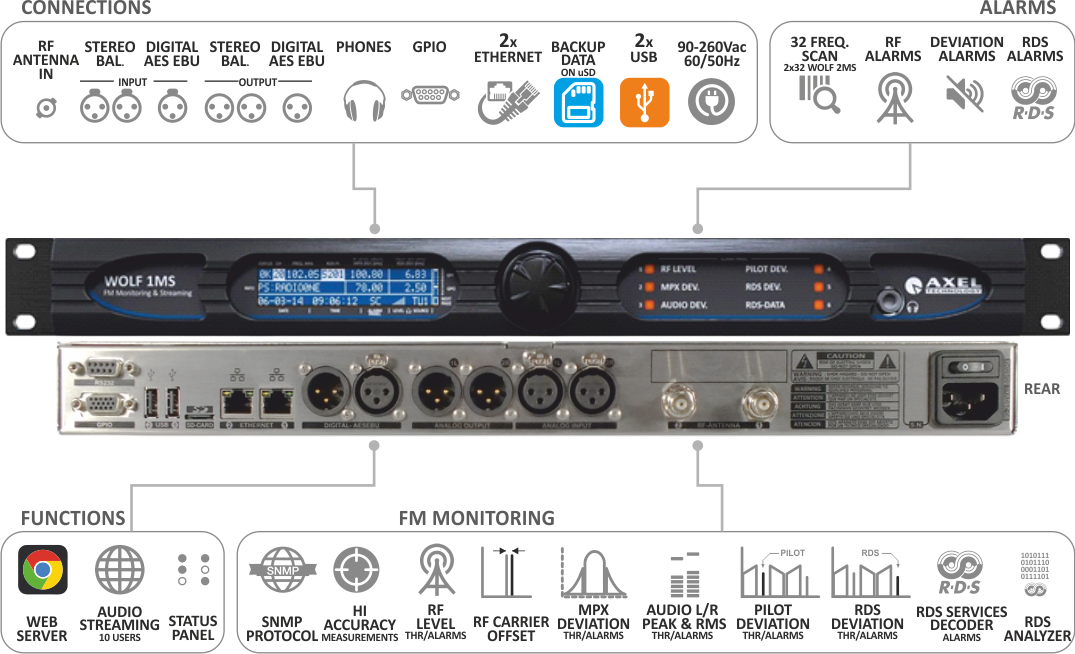
Wolf 2MS
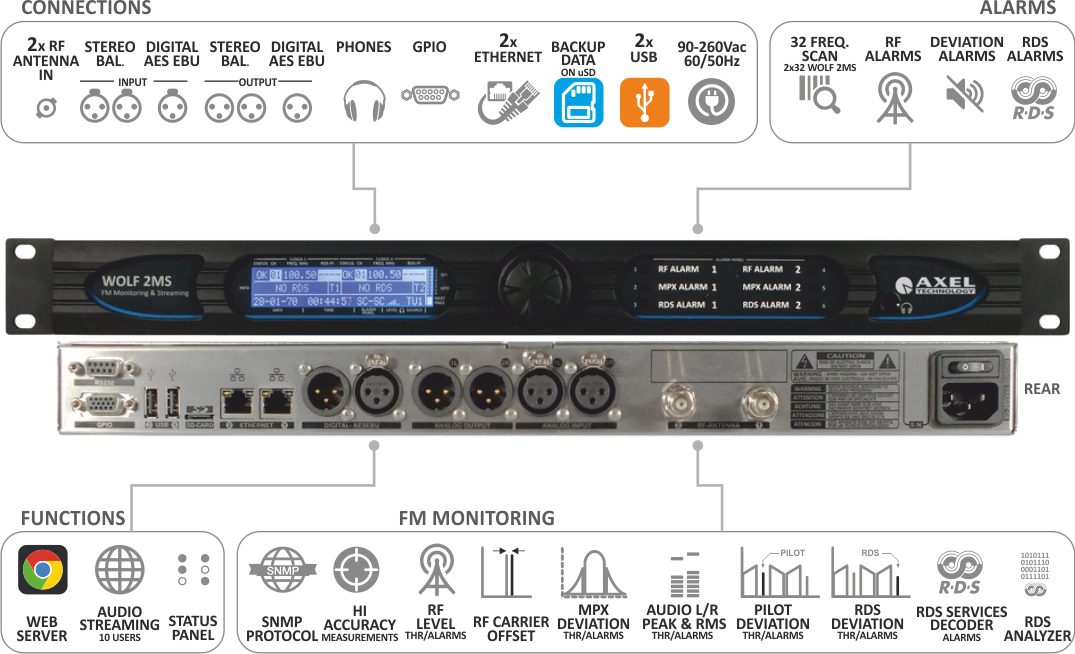
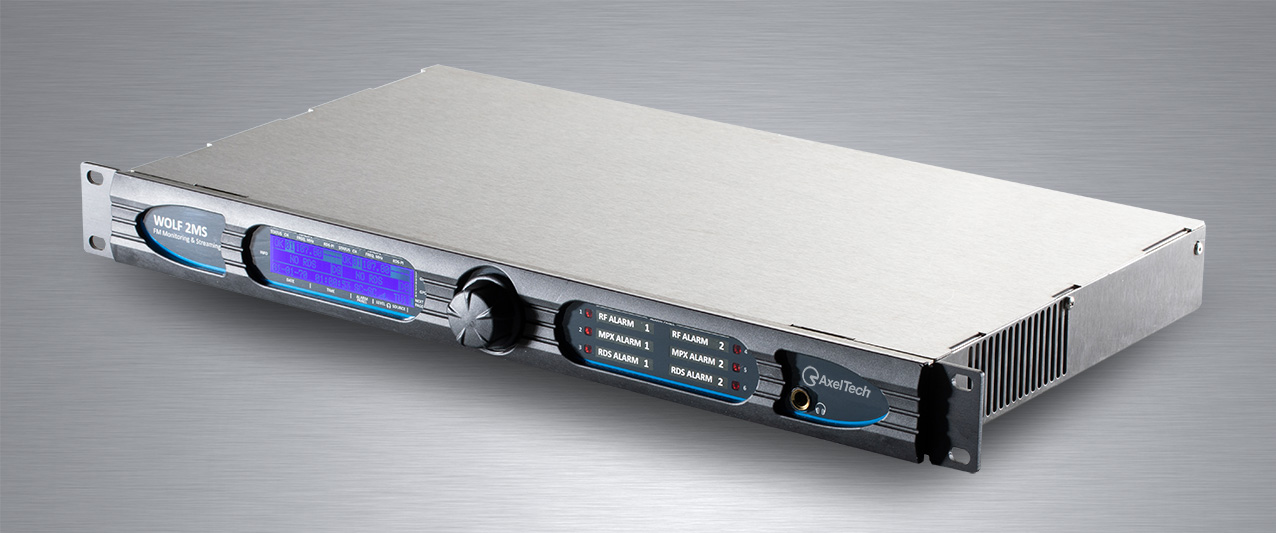
Highlights
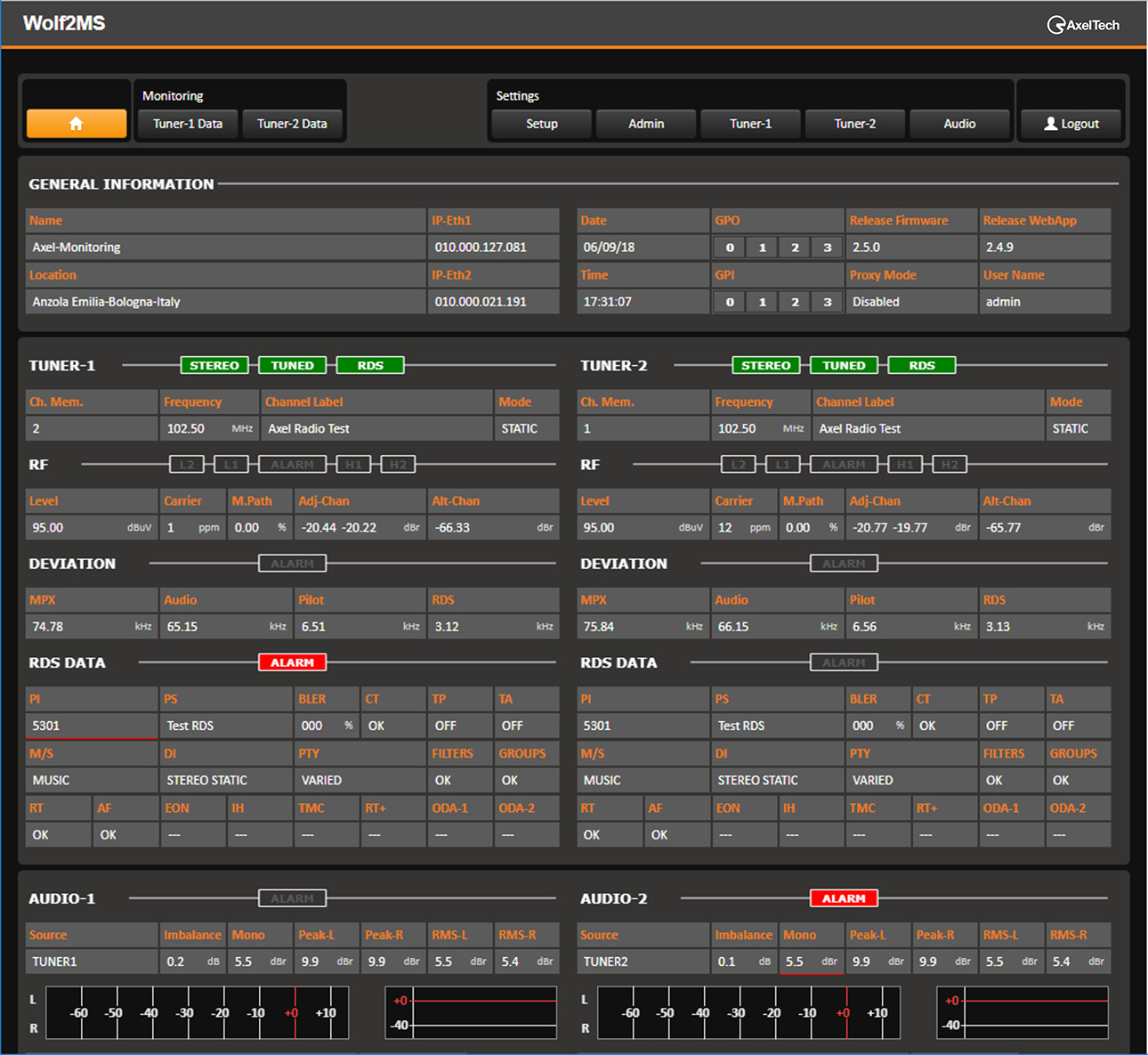
General
- Real time measurements for FM networks, fully digital
- Wolf 1 MS: single FM Tuner and single audio over-IP streaming for monitoring
- Wolf 2MS: double FM tuner and double audio over-IP streaming for monitoring
- More than 30 alarms for any frequency received (Wolf 2MS 64. Wolf 1 MS 32)
- Fully independent time, Thr, Hysteresis, for any frequency parameter
- Configurable bandscan for each FM tuner
- Embedded web server for worldwide consultation
- Analysis modulers: RF, MPX, audio and RDS
- RDS decoder with group sequence decoding for each tuner
- SNMP and HTTP web interface and FTP supported
- Double ethernet ports and double USB interfaces
- Front LCD display
- Front panel headphone output
- Analog auxiliary input and AES/EBU
- Main Supply 90--260Vac 50/60Hz. 25W
- Graphic display
- Form factor: 1RU 19” - Inox steel
- High immunity to strong RF fields, designed to be installed in high power TX sites
- Fully programmable by a simple and intuitive Web GUI interface
- Headphones output with level control

Monitoring Parameters
- RF parameters:
- RF level, Carrier offset, Multipath, Adjacent carriers level (+/- 100kHz), Alternative carriers level (+/- 200kHz)
- Deviation parameters
- MPX level, Audio level, Pilot level and RDS level
- Audio parameters
- Inbalance L/R, Mono, Peak left, Peak right, RMS left, RMS right, MPX power
- RDS parameters
- PI, PS, BLER, CT, TP, TA, M/S, DI, PIN & PTY (Day/Hour/Min/PTY), FILTERS, GROUPS, RT, AF, EON, IF, TMC (AID/Group/Data), RT+(AID/Group/Data), ODA-1(AID/Group/Data), ODA-2(AID/Group/Data), LA, EG, ILS, LSN, SLC0-SCL7
- 64 list of 25 frequencies always decoded
- 10 EON for each frequency received with PI, PS, PIN (date, hour, minute) PTY, TP, TA, LA EG, ILS, LSN, AF
- Received groups stats 0A-15A, 0B-15B
- RDS Stream with groups filters with download function
Communications & Management
- Ethernet/USB/RS232/GPIO connections
- SNMP V2c
- NTP Address for Time and Date synchronization
- 1 RS232 for RDS UECP data streaming
- 4 GPI and 4 Relay (DB 15p F HD)
- 2 USB A-Type
- HTTP, FTP, SNMP, SMTP, UDP, TCP support
- Alarms via: TRAP (SNMP), email(SMTP), GPO, HTTP
- uSD Card for clone function, for maintenance and easy replace of a faulty unit
- Import and export configurations function
- Logs 24/7 with export functions
- Right access management
- Easy configuration page setup with info connection diagrams
- Multi-user contemporary acces
Inputs & Outputs Audio
- Balanced analog input on XLR
- Balanced analog output on XLR
- Balanced digital AESEBU input on XLR
- Balanced digital AESEBU output on XLR
Alarms & Parameters
- Silence detector on analog input
- Silence detector on digital input
- 4 alarm on RF level with 4 Thr (RFL2, RFL1, RFH1, RFH2).
- Deviation level (Thr, Hysteresis, Validation Time and Hold Time, Mask, Label, Email and Trap enable)
- Pilot low level (Thr, Hysteresis, Validation Time and Hold Time, Mask, Label, Email and Trap enable)
- Pilot window (Thr Min, Thr Max, Hysteresis, Validation Time and Hold Time, Mask, Label, Email and Trap enable)
- RDS low level (Thr, Hysteresis, Validation Time and Hold Time, Mask, Label, Email and Trap enable)
- RDS window (Thr Min, Thr Max, Hysteresis, Validation Time and Hold Time, Mask, Label, Email and Trap enable)
- Audio deviation silence (Silence Thr, Validation Time and Hold Time, Mask, Label, Email and Trap enable)
- Audio left deviation silence (Silence Thr, Validation Time and Hold Time, Mask, Label, Email and Trap enable)
- Audio right deviation silence (Silence Thr, Validation Time and Hold Time, Mask, Label, Email and Trap enable)
- Audio mono level (Thr, Validation Time and Hold Time, Mask, Label, Email and Trap enable)
- Audio stereo in-balance level (Avg, Thr, Validation Time and Hold Time, Mask, Label, Email and Trap enable)
- RDS-PI (PI-1, PI-2, PI-3, Validation Time and Hold Time, Mask, Label, Email and Trap enable)
- RDS-PS (PS-1, PS-2, PS-3, PS-4, Wild Char, Validation Time and Hold Time, Mask, Label, Email and Trap enable)
- RDS-TP (Ref, Validation Time and Hold Time, Mask, Label, Email and Trap enable)
- RDS-TA (MaxOnTimeout, NoVarTimeout, Mask, Label, Email and Trap enable)
- RDS-CT (Timeout, Max Offset, Mask, Label, Email and Trap enable)
- RDS-RT (Timeout, Hold Time, Mask, Label, Email and Trap enable)
- RDS-AF (Validation Time, Hold Time, Mask, Label, Email and Trap enable)
- RDS-EON (Validation Time, Hold Time, Mask, Label, Email and Trap enable)
- RDS-IH (Data Timeout, Group Timeout, Hold Timeout, Mask, Label, Email and Trap enable)
- RDS-TMC (Reg. Timeout, Data Timeout, Hold Timeout, Mask, Label, Email and Trap enable)
- RDS-RT+ (Reg. Timeout, Data Timeout, Hold Timeout, Mask, Label, Email and Trap enable)
- RDS-ODA-1 (AID, Reg. Timeout, Data Timeout, Hold Timeout, Mask, Label, Email and Trap enable)
- RDS-ODA-2 (AID, Reg. Timeout, Data Timeout, Hold Timeout, Mask, Label, Email and Trap enable)
- RDS-BLER (Max, Hysteresis, Validation Time, Hold Time, Mask, Label, Email and Trap enable)
- RDS-GROUPS (Group mask, Timeout, Validation Time, Hold Time, Mask, Label, Email and Trap enable)
- RDS Filters (Block-1 Mask Ref., Block-2 Mask Ref., Block-3 Mask Ref., Block-4 Mask Ref., Timeout, Validation Time, Hold Time, Mask, Label, Email and Trap enable)
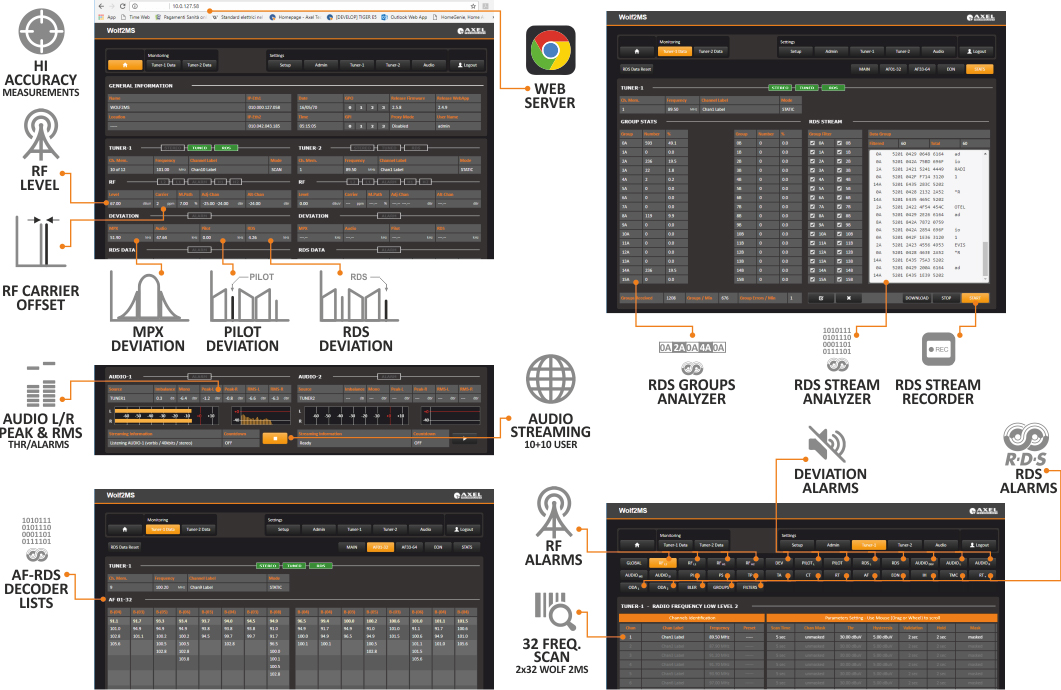
Block Diagram
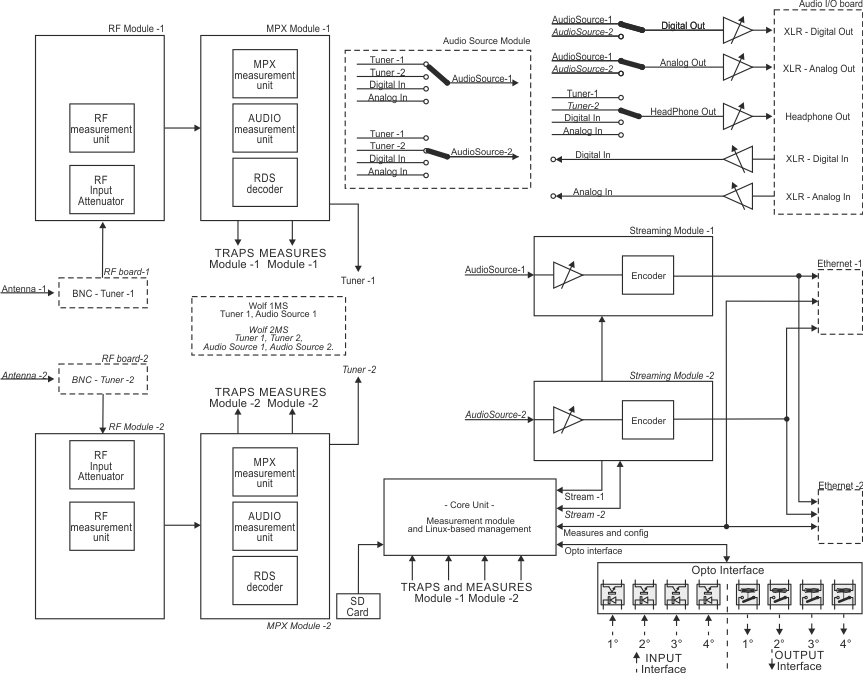

Wolf 1MS and Wolf 2MS are FM monitoring systems designed for FM Off Air signal monitoring purpose. Wolf 1MS is provided with one high quality FM tuner, while Wolf 2MS allows the broadcaster to receive up to two frequencies thanks to an internal double tuner. Tuners are independent and they can operate in three ways: Continuous reception, Bandscan and SmartScan.
Internal tuner ensures high performances in FM reception, RF and MPX audio analysis and RDS data stream output. The monitoring made on FM channels can be a basic RF analysis or an advanced RF, MPX and AUDIO measurement.
- Continuous reception: a single carrier is selected and monitored;
- Bandscan mode: 32 FM Channels can be scanned and monitored in Wolf 1MS and 64 FM Channels can be scanned and monitored in Wolf 2MS. The bandscan time is also user definable, in a range from 1 second up to 10 seconds for each channel;
- SmartScan mode allows a smart and variable scan time that is adjusted automatically to fit the instantaneous measurement requirements. Thanks to this feature it is possible to avoid false-positive rising errors.
Special Features
During continuous reception mode, each single tuner checks and completely decodes the multiplexed signal:
Mono level, Pilot level, Audio and RDS levels are measured and they are always under control. All datas, captured during FM Channel monitoring, can be sent to a Network Management System (such as AxelTech’s Ranger) or they can be shown in a common password protected web page. Communication between Wolf and Ranger NMS is SNMP v2C protocol. For all single parameters under monitoring, a threshold can be set. If one or more values go out of range, alarms are delivered.
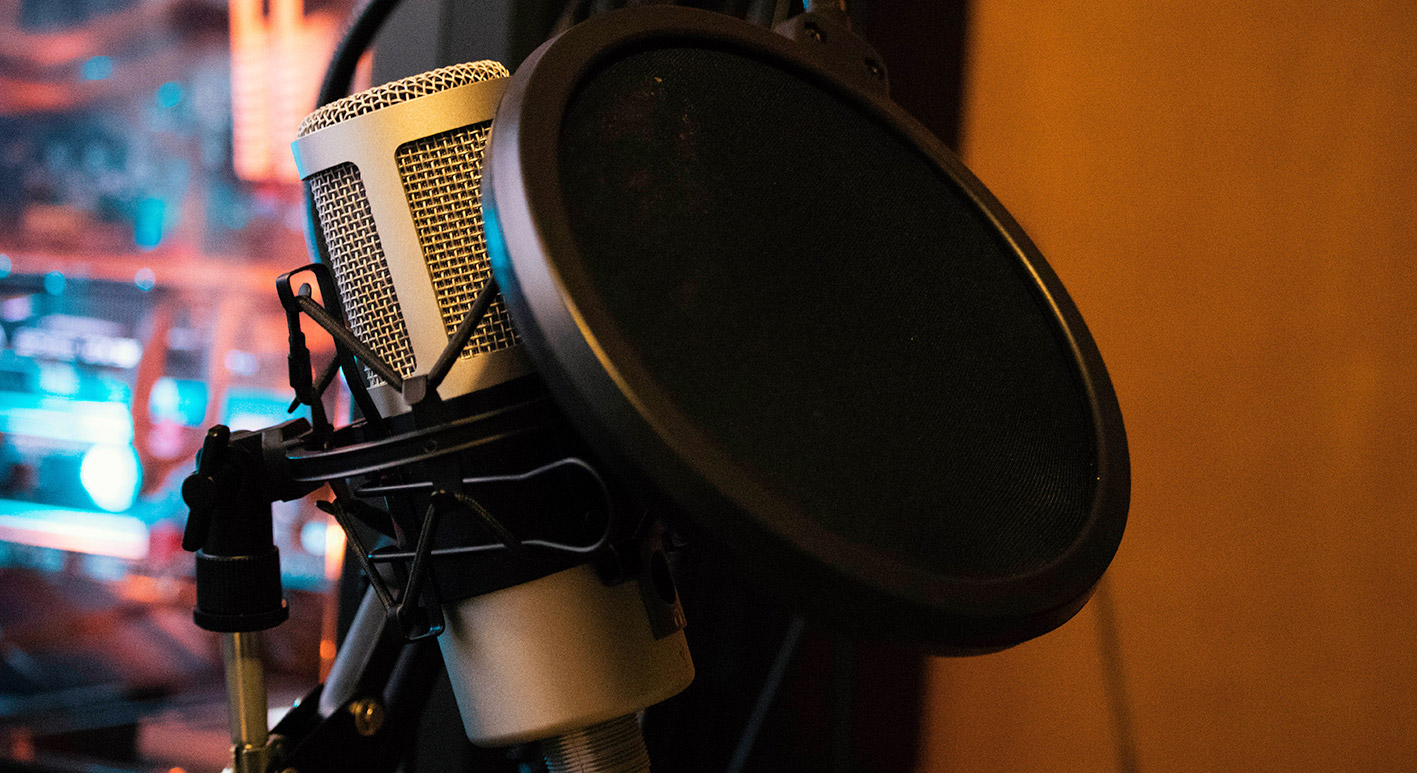
Once the RF signal is received, audio should be streamed from the transmitter site back to a remote logging system. The streamer input allows to do an internal selection between all inputs available: Tuners, External Analog In, External AES/EBU In.
Wolf 1MS and Wolf 2MS are completed with an “External Input” source: analog Left + Right input and Digital Left + Right in AES/EBU format. This audio input is continuously monitored: silence detection (Threshold/time and level), left and right presence, peak left, peak right. Rear-panel audio output always presents the audio decoded from Tuner-1 or Tuner-2 and this setting is user definable, while audio is available on analog or AES/EBU format.
Wolf 1MS and Wolf 2MS provide a large variety of connection: double Ethernet port, USB and front panel headphone output, 4x GPIn opto coupled and 4x GPOut over relays. Rs232 serial port for RDS-UECP bridging and rebroadcasting purposes, and rear panel placed SD card to store or recall the complete equipment configuration.
RF antenna inputs are over BNC connectors, a XLR balanced stereo analog input and output, AES/EBU input and output. OS and datas are loaded and stored over solid state memory as SD and flash RAM. Universal switching power supply, 1 rack unit space in fan-less configuration, allows to operate worldwide.
Measures
Field Type of measure Description U.M.
RF 4x RF Level lower threshold Measure, alarm via email/trap SNMP dBµV
2x Adjacent channel L1 threshold Measure, alarm via email/trap SNMP
Alternative channel - Worse Measure dBr
Carrier precision Measure ppm
Multi path Measure %
MPX Deviation max Measure, alarm via email/trap SNMP kHz/dBr
2x Pilot lower level - 2 threshold level Measure, alarm via email/trap SNMP
MPX power – ITU-R BS.412 Measure, alarm via email/trap SNMP
RDS Level RDS level lower threshold Measure, alarm via email/trap SNMP
RDS level higher threshold Measure, alarm via email/trap SNMP
Audio Peak left - Peak right threshold Measure, alarm via email/trap SNMP dBr
RMS left - RMS right threshold Measure, alarm via email/trap SNMP
Audio imbalance – L/R delta threshold Measure, alarm via email/trap SNMP
Mono silence – L+R threshold Measure, alarm via email/trap SNMP
Audio MPX deviation threshold Measure, alarm via email/trap SNMP kHz
Audio MPX Silence detection threshold Measure, alarm via email/trap SNMP
s
Audio left – Right silence det. threshold Measure, alarm via email/trap SNMP
RDS Data AF - Complete decoding + Visualization
PS – 4 PS matching reference
PI – 3 PI Code matching reference
CT – Time offset
DI – Decoder information
PTY – Program type
TP/TA – timeout TA
M/S – Music speech
BLER – Block error rate
TMC – AID – Group – Data
EON Enhance other channel
RT – RT+ data decoding
LA – EG – ILS – LSN-PIN
ODA TMC
ODA RT+
ODA - 1 ODA - 2
SLC0 - SLC1 - SLC2 - SLC3 - SLC4 - SLC5 - SLC6 - SLC7
RDS Data decoding group, visualization and storage. Alarm generation in case of error, can be shown in a common web page or delivered via email.
Interfacing with up to 4 NMS allows equipment to deliver traps using SNMP protocol.
Technical Specifications
PARAMETERS DESCRIPTION
Main Power 100 Vac - 240 Vac 50/60 Hz internal, universal power supply
Power consumption 25 W
Power connector IEC plug filter with internal fuse 2.0 AT
Headphones Stereo Jack 6.3 mm
Safety and EMC Compliant to CE laws
Working temperature 0° to 50° C (storage -5 to + 50 °C)
Housing dimensions 19 inch x 1u x 240 mm (depth)
Weight 3.5 kg
RF TUNERS
Tuner frequency 87.5 MHz ‐ 108.0 MHz
Tuner step 10 kHz
RF tuning stability +/- 500 Hz
RF input sensitivity 20 to 120 dBµV
RF input nominal level 80 to 100 dBµV
RF inputs main 2x BNC, with 50 Ohm unbalanced
Max frequency deviation 125 kHz
IF filter bandwidth 34 kHz to 138 kHz – Manual or automatic
Input RF level 30 dBµV – 120 dBµV with internal attenuator
Bandscan carrier number 32 channels
Bandscan time Static Mode, Scan 2s to 20s and Smart Mode*
Selectivity at ± 120 kHz > -3 dB
Selectivity at ± 200 kHz > -40 dB
Selectivity at ± 300 kHz >- 50 dB
Selectivity at ± 400 kHz >-65 dB
Image rejection @ 22.5 kHz 70 dB
Adjacent channel rejection 63 - 65 dB
Alternate channel rejection 65 - 72 dB
THD @ dev=75 kHz 0.05 – 0.1 %
Mono (S+N)/N 75 dB typ – 68 dB min (No A-Weighting 30 Hz – 15 kHz)
STEREO DECODERS
Stereo (S+N)/N
61 dB Stereo/61 dB mono @ 40 dBµV
65 dB Stereo @ 50 dBµV
80 dB Stereo @ 70 dBµV
Pilot 19kHz suppression 55 dB (Stereo modulation L = 1, R = 0,Deviation=67.5 kHz, Pilot deviation=6.75 kHz)
Stereo THD + N Measures @ 70 dBuV with 75 kHz deviation
100 Hz - 0.055 %
1 kHz - 0.061 %
5 kHz - 0.19 %
10 kHz - 0.46 %
Stereo separation 45 dB (Stereo modulation L = 1, R = 0,Deviation=67.5 kHz, Pilot deviation=6.75 kHz)
48 dB @ 400 Hz
48 dB @ 1 kHz
48 dB @ 5 kHz
38 dB @ 10 kHz
38 dB @ 14.7 kHz
RDS DECODER
RDS sensitivity 20 dBµV (dev f = 2 kHz, RDS BLER < 5%)
RDS synchronization time 80 ms (dev f = 2 kHz RF input = 60 dBµV)
RDS PI lock time 100 ms (dev f = 2 kHz RF input = 60 dBµV)
RDS data decoding and streaming RDS level indication and deviation (voltage, kHz and dBr)
RDS data decoding services PS, PI, M/S, DI, TP, TA, AF, AF List Presence A/B Method, Scrolling PS, AF EON, Radio Text, Radio Text Plus, CT, PTY, PIN, IH, TMC, EWS, TDC. ODA generic services. RDS error detection with three shold adjustable
RF MEASUREMENT MODULE Ranges – Resolution - Precision
RF Level 0 – 80 dBµV (resolution 1 dBµV, precision 2 dBµV)
82 – 120 dBµV (resolution 2 dBµV, precision 5 dBµV)
Deviation 0-125 kHz (resolution 1 kHz, precision 2 kHz)
Tuned carrier frequency offset 0-250 ppm (resolution 2 ppm, precision 5 ppm)
Multipath 0-100 %
Adjacent channel RF level 0 – 80 dBµV (resolution 1 dBµV, precision 2 dBµV) (+-200kHz)
MPX MEASUREMENT MODULE Ranges - Resolution - Precision
Pilot level 0-20 kHz (resolution 0.1 kHz, precision 0.2 kHz)
Rds level 0-20 kHz (resolution 0.1 kHz, precision 0.2 kHz)
Mpx power ITU-R-BS412 (Estimated) -20 dBr to + 12 dBr (resolution 0.1 dBr, precision 0.5 dBr)
Stereo Valid Stereo signal detector
AUDIO MEASUREMENT MODULE Ranges – Resolution – Precision
Left Quasi Peak Programmable attack time from 0 mS to 2 mS (Resolution 0.1 dB)
Right quasi peak Programmable attack time from 0 mS to 2 mS (resolution 0.1 dB)
Audio silence Threshold - 80 dB to 0 dB, Time: 1-120 Sec
Unbalanced stereo signal Threshold - 80 dB to 0 dB, Time: 1-120 Sec
AUDIO OUTPUT
Available output on XLR Tuner - 1 or Tuner - 2, definable via web page. Same audio on analog and AES/EBU
Audio frequency response 30 Hz - 15 kHz, ± 0,3 dB
Phones (Front panel) Stereo jack 6.3 mm, 150 Ohm, 0.8 W
ANALOG OUTPUT MODULE
D/A Conversion 24bit Sigma - Delta conversion - 32 kHz Sample rate
Connectors 2x XLR, male - Electronically balanced
Output level -12.0 dBu to +14.0 dBu (0.1 dBu Step) - Max (+20 dBu)
Impedance Source 47 Ω
Load impedance 600 Ω or greater
Distortion Less than 0.02% TDH + Noise (0.0dBu @ 1Khz)
Dynamic range 108 dB (110 dB A-weighted, 20Hz - 15kHz)
Sources Streamer1_Source , Streamer2_Source
DIGITAL OUTPUT MODULE
Connectors: XLR, Male - Electronically balanced
Format AES3/EBU
Sample rates 32 kHz
Resolution 24 bits
Operative nominal level: From 0.0 dBFs to - 24dBFs (0.1 dBu step)
Dynamic range: 125 dB (Typ), 122 dB (Min)
Distortion less than 0.01% TDH+NOISE (-20dBFs @ 1Khz)
Freq. response 20Hz -15kHz
Dynamic range 108 dB
Sources Streamer1_Source , Streamer2_Source
AUDIO INPUT
Encoder streaming input source User selectable between Tuner-1, Tuner-2, External Input Analog, External Input AES/EBU
DIGITAL INPUT MODULE
Connectors: XLR, female – Electronically balanced
Format AES3/EBU
Sample rates 32 kHz/44.1 kHz/48 kHz/96 kHz with src and jitter correction
Operative nominal level: From 0.0 dBFs to - 24dBFs (0.1 dBu step)
Dynamic range: 125 dB (Typ)
Distortion less than 0.01% TDH + Noise (-20dBFs@ 1Khz)
Input modes: Stereo, Mono (Left), Mono (Right), Mono (Left + Right)
ANALOG INPUT MODULE
A/D conversion 24bit Sigma - Delta conversion - 32kHz sample rate
Connectors: XLR, female - Electronically balanced
AD clipping point +20.0dBu
Operative nominal level: From - 12.0dBu to +12.0dBu (0.1dBu Step)
Line impedance 10 kΩ (Electronically balanced selectable) EMI - suppressed
Distortion: less than 0.02% TDH+NOISE (0.0dBu @ 1kHz)
AD dynamic range: 108 dB RMS (110 dB A - weighted, 20Hz - 15kHz)
Input modes: Stereo, Mono (Left), Mono (Right), Mono (Left + Right)
AUDIO & RDS STREAMING MODULES
Protocols UDP/RTP, TCP/IP, IceCast2
Encoders OGG - VORBIS
Interface Ethernet port 10/100 Mb/s
Bitrate User select 24 kbps to 192 kbps
Sample rates 32Ksamples/sec
RDS streaming Proprietary redundant protocol over UDP or RAW-TCP/IP
Administration User right management
Dimensions
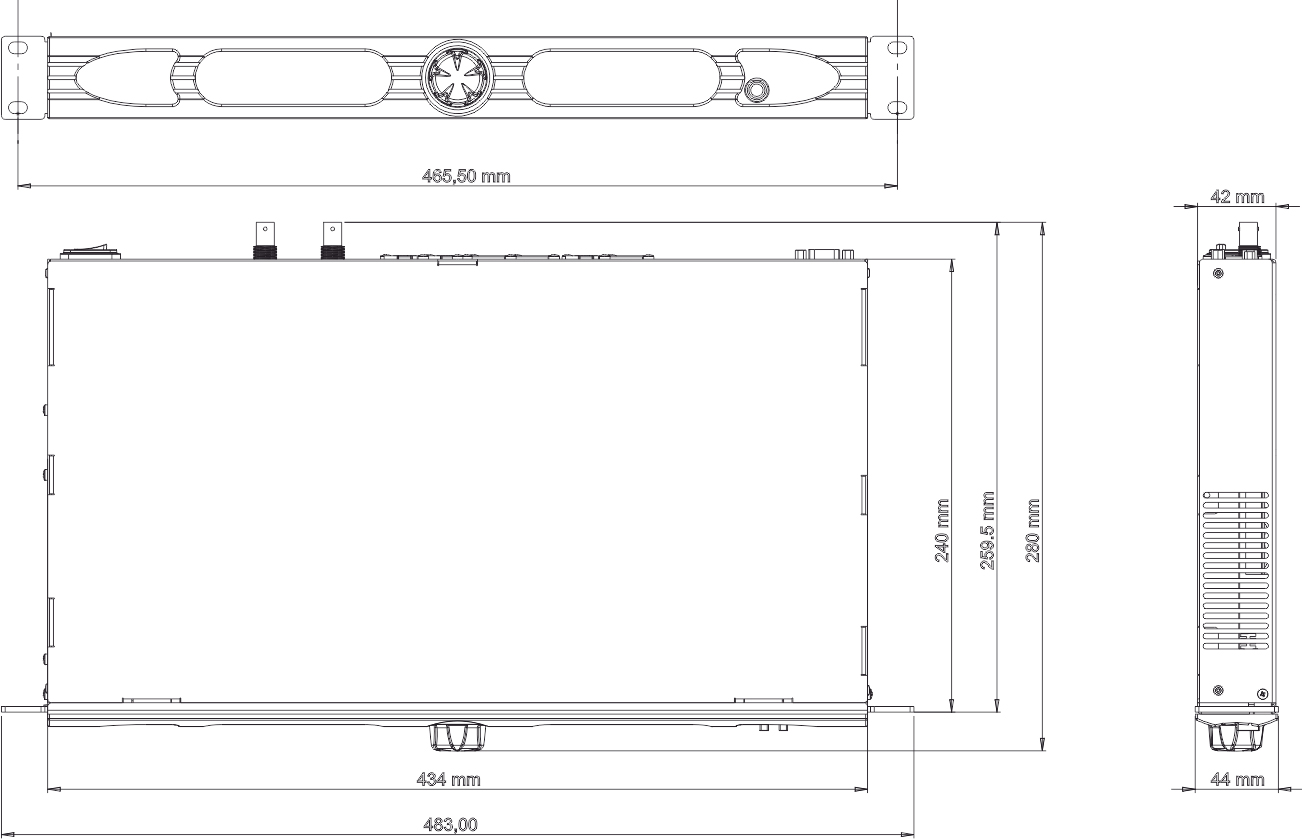
Ask for aquote now
Subscribe to our newsletter
RDS E3-E5
Premium
RDS Encoding and Monitoring
Product Overview
RDS E3 and RDS E5 are static/dynamic RDS Encoders supporting all the services and features requested by an advanced user. RDS E3 and RDS E5 support the most advanced RDS dynamic services, including TMC, ODA, IH, TDC, EWS, Radio Text and Radio Text plus.
In addition to standard CENELEC NRSC methods, RDS programming has been enriched with larger PS and RT sets (that are also available in dynamic mode).
RDS E3 and RDS E5 can interface with various Automation Systems and they offer an ASCII protocol for broadcast song/artist information. In case of alarms, they support SNMP alerting for NMS.

RDS E3 and RDS E5 satisfy the high-end broadcasters’ requirements: UECP system features 4 TCP ports, 4 UDP ports, 2 serial ports and 1 SNMP port.
RDS E3 and RDS E5 are RDS 2.0 Ready: they manage the 4 RDS subcarriers specified in the standard that is still under definition. A web interface has been created to control all these functions and it can be used by any browser with any device from the smartphone to the laptop.
RDS E3 and RDS E5 are SNMP v2c in order to satisfy the most demanding deployments. RDS E3 and RDS E5 have an high resolution colour display that allows the display and insertion of the main machine parameters.

- New features for Dynamic RDS
Models
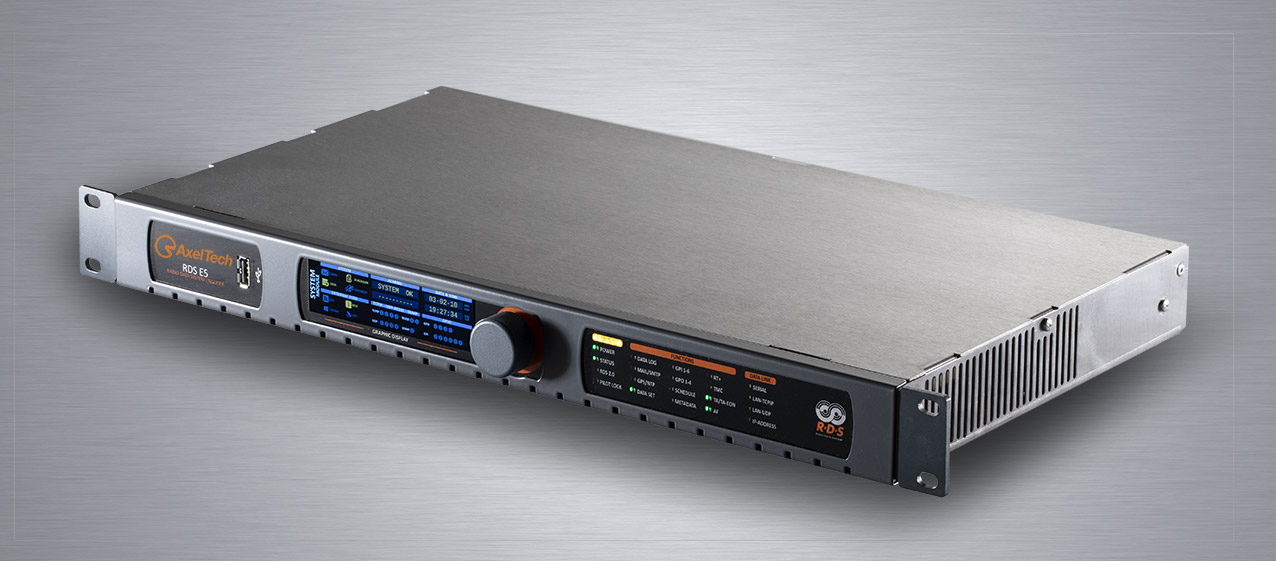
RDS E5
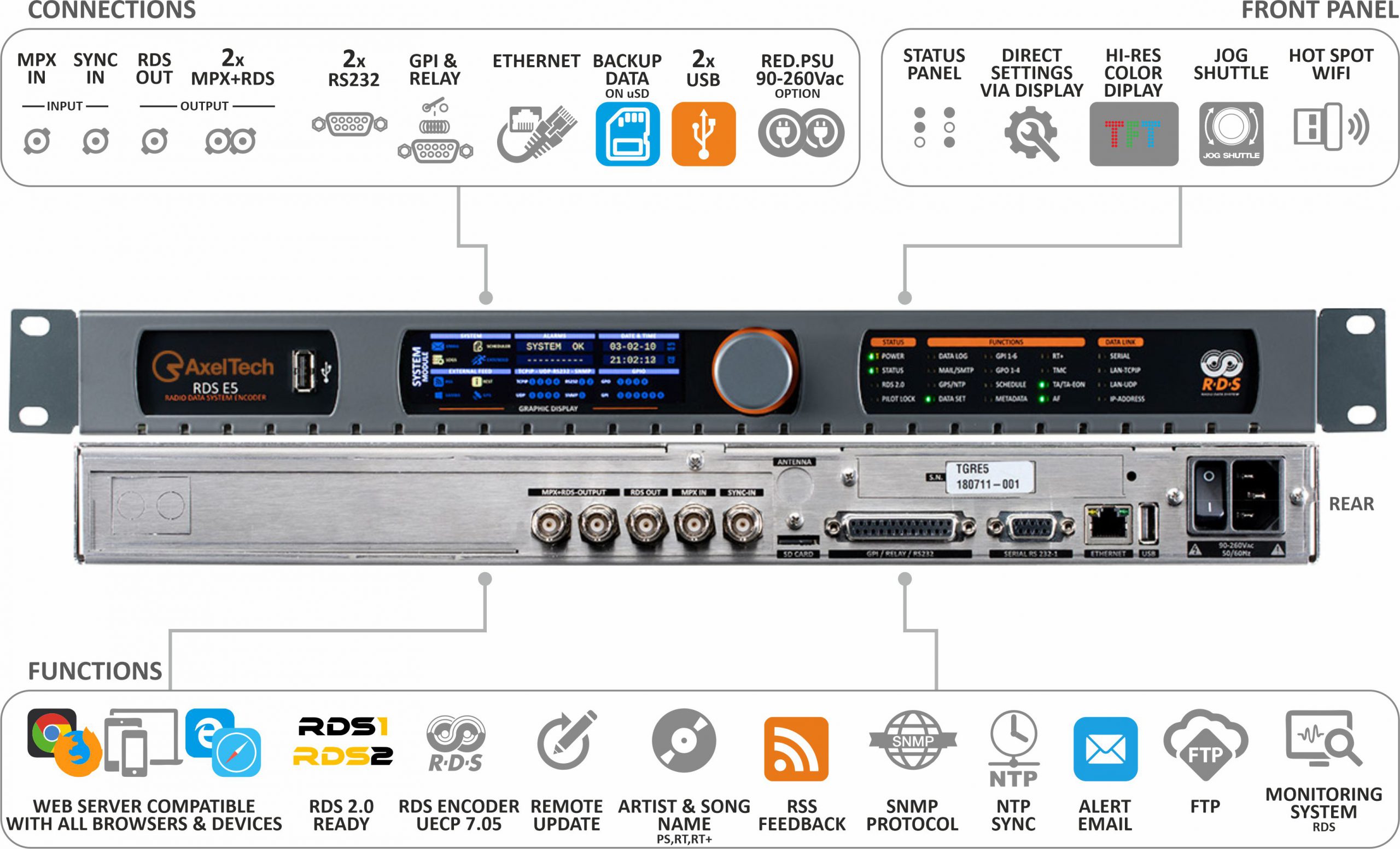
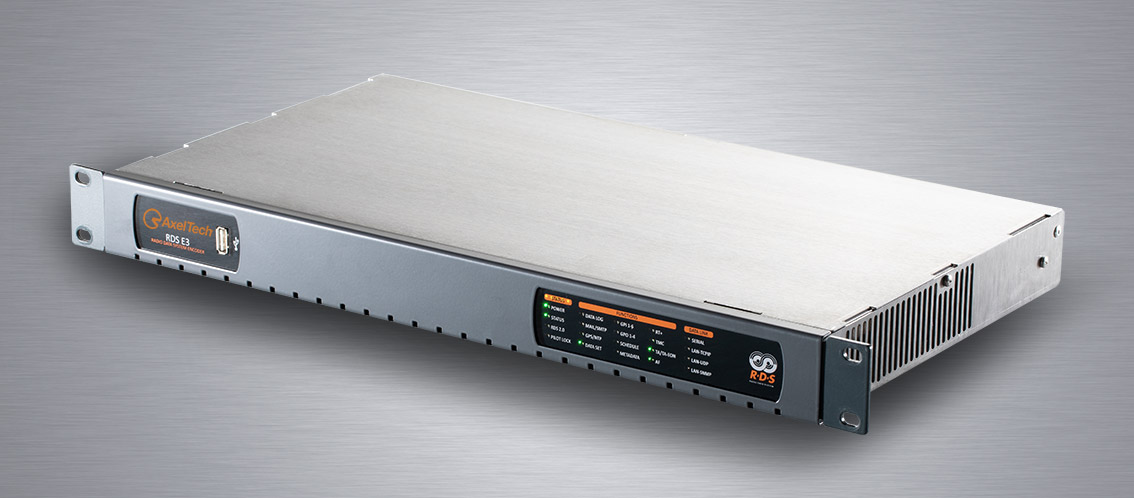
RDS E3
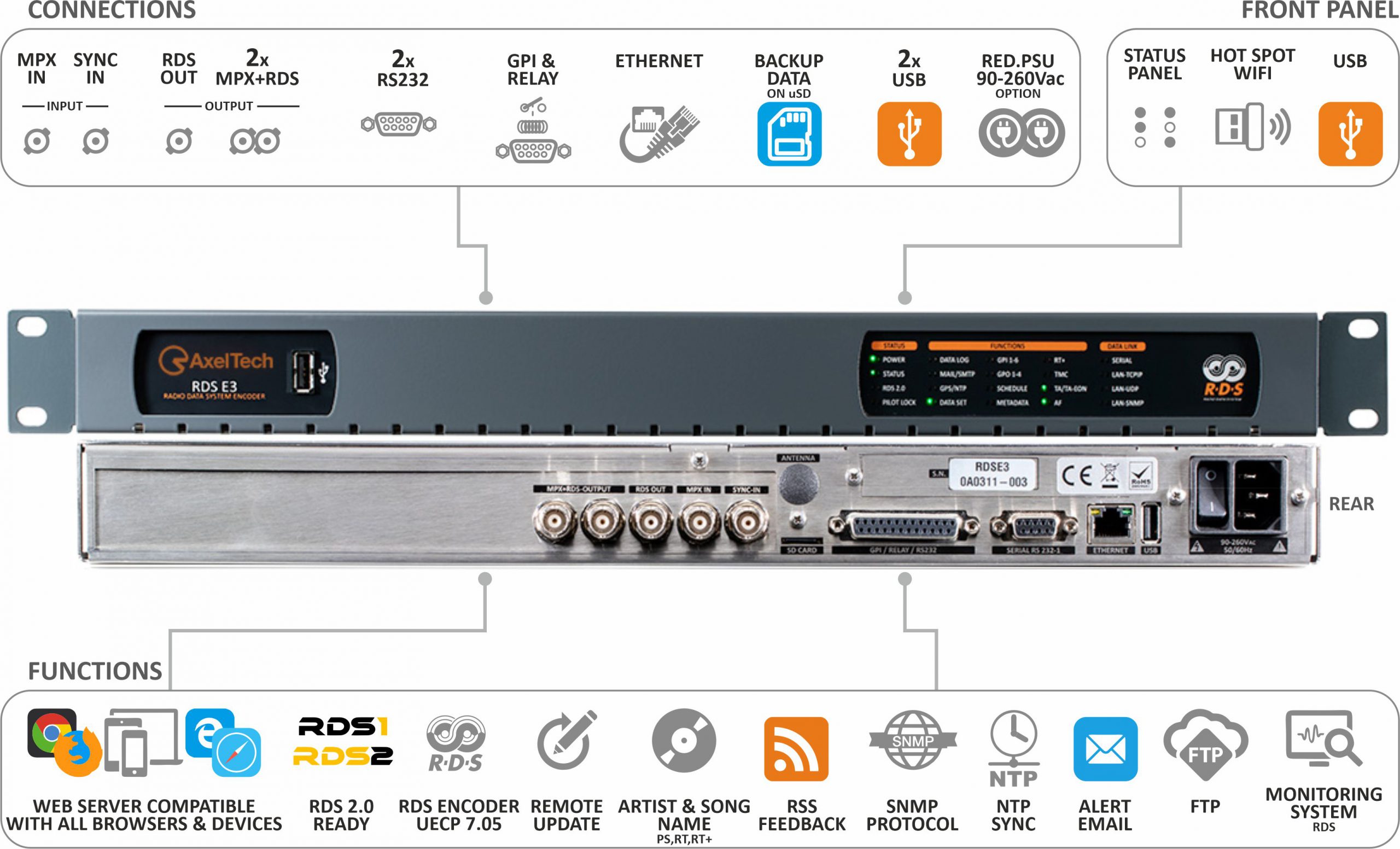
Highlights
General
- Main Supply 90--260Vac 50/60Hz. 15W;
- Green device - only 15W;
- Full Colour Graphic display 480x128 (only RDS RDS E5);
- Status led panel with 40 leds;
- Rack 1u 19” - Inox steel;
- Redundant PSU (available as an option);
- High immunity to strong RF fields, designed to be installed in high power TX sites;
- Fully Digital – No trimmer
Inputs & Outputs Sections
- Double MPX+RDS output with digital level setting;
- RDS output;
- Bypass HW on RDS+MPX Outputs (MPX to Out 1&2);
- 1 MPX input (wide band);
- 1 19kHz Sync imput to synchronize internal RDS.
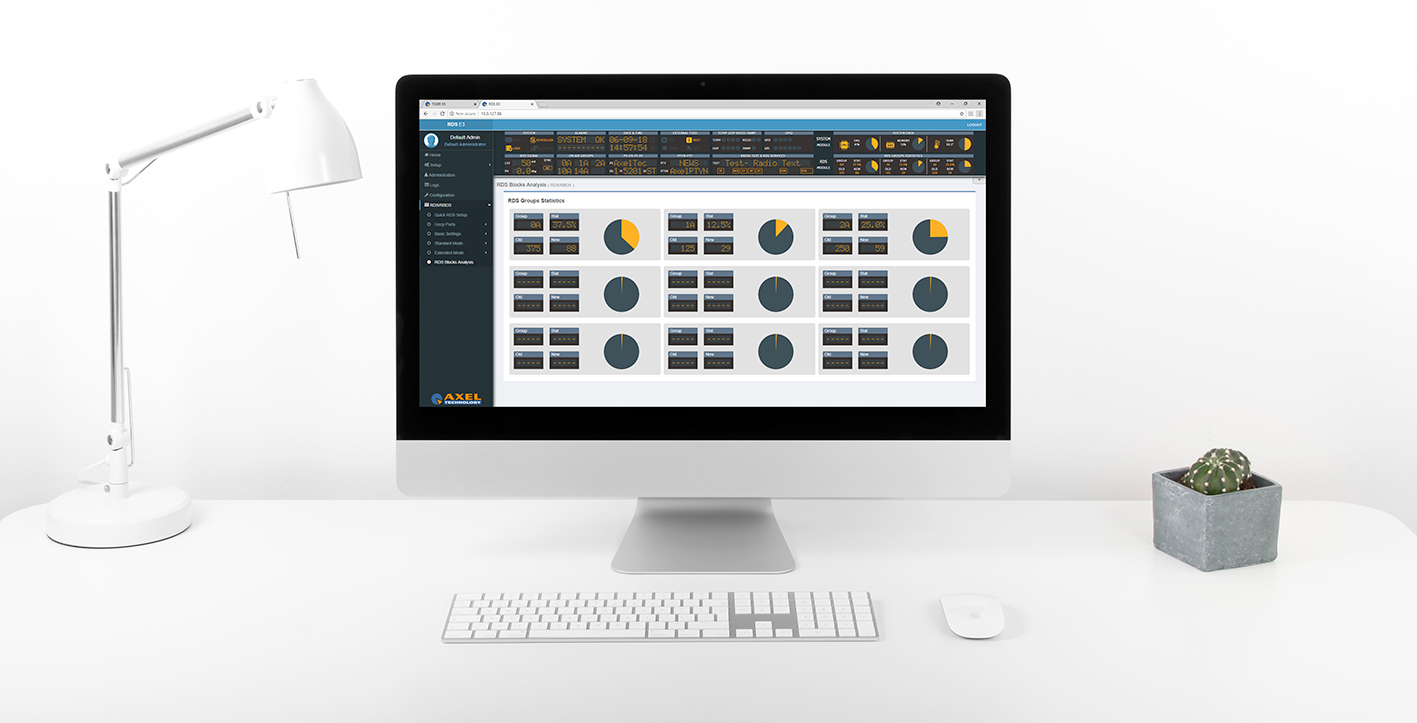
Encoder RDS Section
- RDS encoder fully compliant with UECP EBU SPB490 v7.05, CENELEC (Europa) and NRSC (America);
- Fully support for all RDS services, Static and Dynamic services;
- UEPC Ports (2 Serials, 4 TCPIP, 4 UDP);
- n.8 Data Set;
- n.10 EON + Main PS for each Data Set;
- Integrated RDS decoder;
- Tuner FM with RDS decoder (as an option);
- Dataset switch managed by UECP/SNMP/REST/HTTP/ASCII PARSER/TXT FILE/GPI;
- Easy to interface to any kind of automation system (UECP/SNMP/REST/HTTP/ASCII PARSER/TXT FILE);
- The RDS can autonomously get data from the Radio Automation System (PS/RT/RT+/TA/MS);
- Easy RDS page fast setup;
- RDS 2.0 Ready.
GUI & Monitoring
- Fully programmable by Web GUI interface, all the browsers are supported;
- Simple and intuitive GUI, supported by all devices (PC, notebook, tablet, smartphone, etc.);
- Easy and configurable graphical interface;
- Multi user web GUI;
- Map with device geolocation (RX sat or fixed coordinates are required);
- Web GUI with info bubbles;
- Monitoring FM Tuner (as an option);
- RDS Groups data analyser;
- GUI with led meter bars.
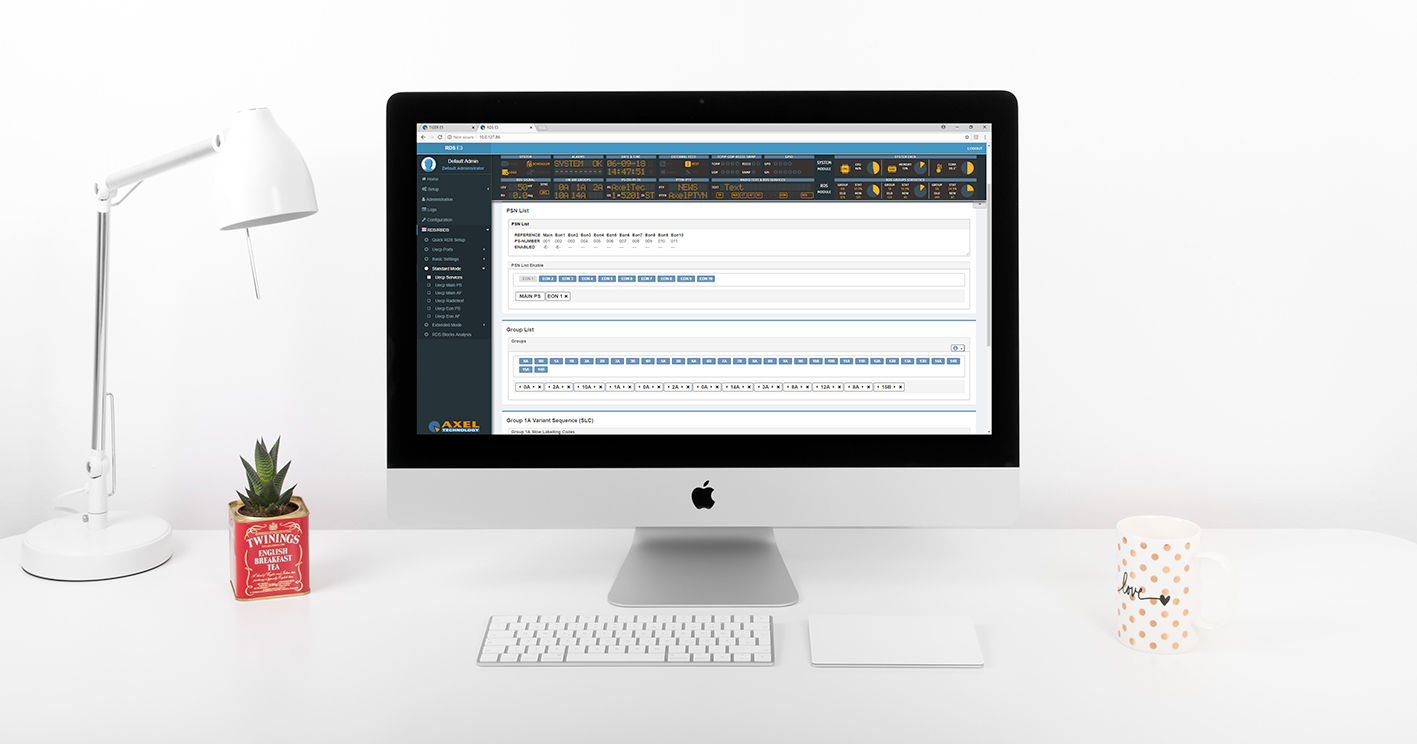
Communications & Management
- Ethernet/USB/RS232/GPIO connections;
- Easy WiFi Access - Hot spot WiFi USB to connect directly a wireless device to RDS E3 and RDS E5;
- SNMP V2c;
- Possibility to set up to 3 NTP Servers (V1, V2, V3, V4);
- Possibility to send email to 4 receivers and to set 3 different SMPT servers;
- IPV4 and IPV6 support (3 addresses IPV4 and 3 addresses IPV6);
- N°2 RS232 for UECP commands;
- 6 GPI and 4 Relay Out (all GPIO are fully programmable by the GUI);
- HTTP, FTP, SNMP, SMTP, UDP, TCP support;
- Alarms via : TRAP (SNMP), email (SMTP), GPO, HTTP;
- External GPS support (Time, Date and Geolocation);
- uSD Card for clone function, for maintenance and easy replace of a faulty unit;
- Import and export configurations function;
- PRESET, with load/save/import /export functions;
- Logs 24/7 with export function;
- 6 levels of right access managment;
- Easy configuration page setup with info connection diagrams;
- REST API available to manage the device;
- ASCII PARSER interface for easy command line settings;
- SAMBA SHARE function to connect and get data from an external PC;
- Multi-user contemporary access.
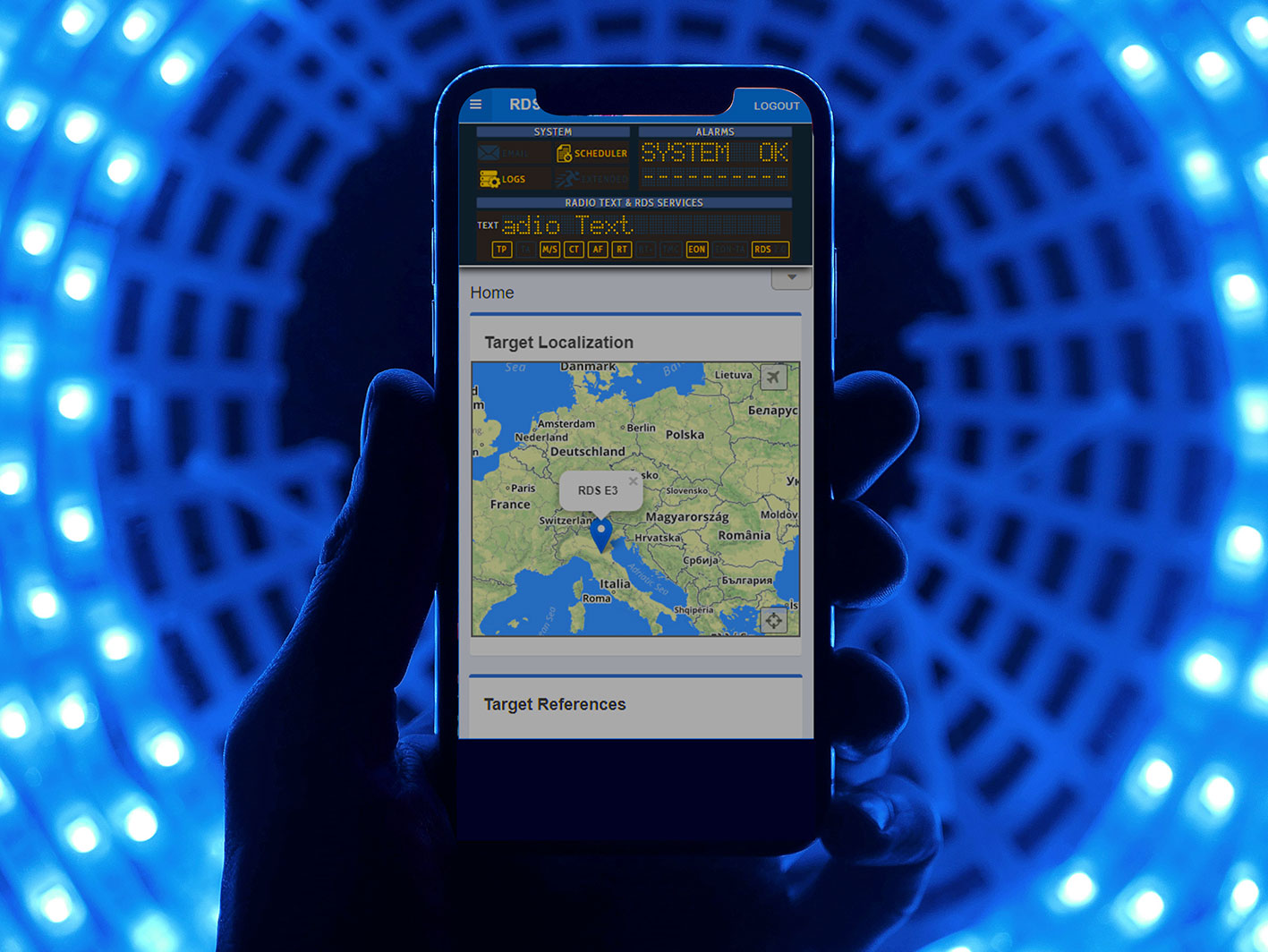
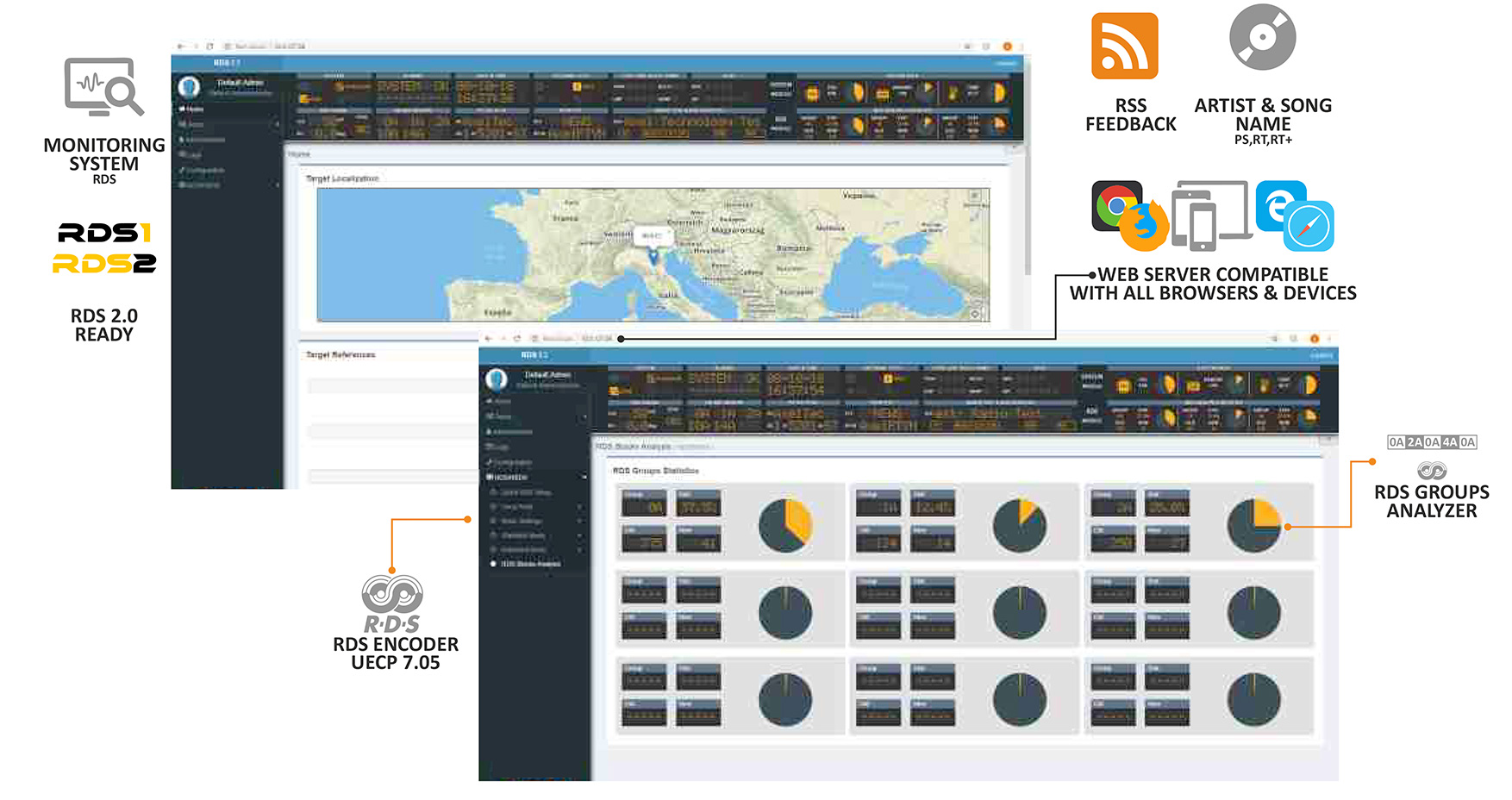
Special featuresBroadcast “All” Your Information
RDS E3 and RDS E5 are the result of the long-time AxelTech experience in RDS encoder development.
RDS E3 and RDS E5 can simultaneously receive UECP commands through 4 TCP ports, 4 UDP ports and 2 serial ports, enabling the most demanding network operator to connect all the dynamic sources to the RDS encoder.
In addition to the accurate use of the RDS through UECP commands, RDS E3 and RDS E5 enable the end user to benefit from more simple and flexible ways to send information to the encoder by offering: REST API commands, ASCII Parser and SAMBA connection to Radio Playouts.
RDS E3 and RDS E5 can automatically get information from the Radio Playouts thus eliminating the need of Middleware Software between the Playout and the RDS encoder.
Opened To The Future
RDS E3 and RDS E5 are RDS 2.0 Ready. Their DSP can generate the multicarrier signal needed for the new RDS standard. Once this standard is defined, with a simple software upgrade the end user will be able to have a RDS 2.0 compliant encoder without any replacement that would vanify the initial investement.
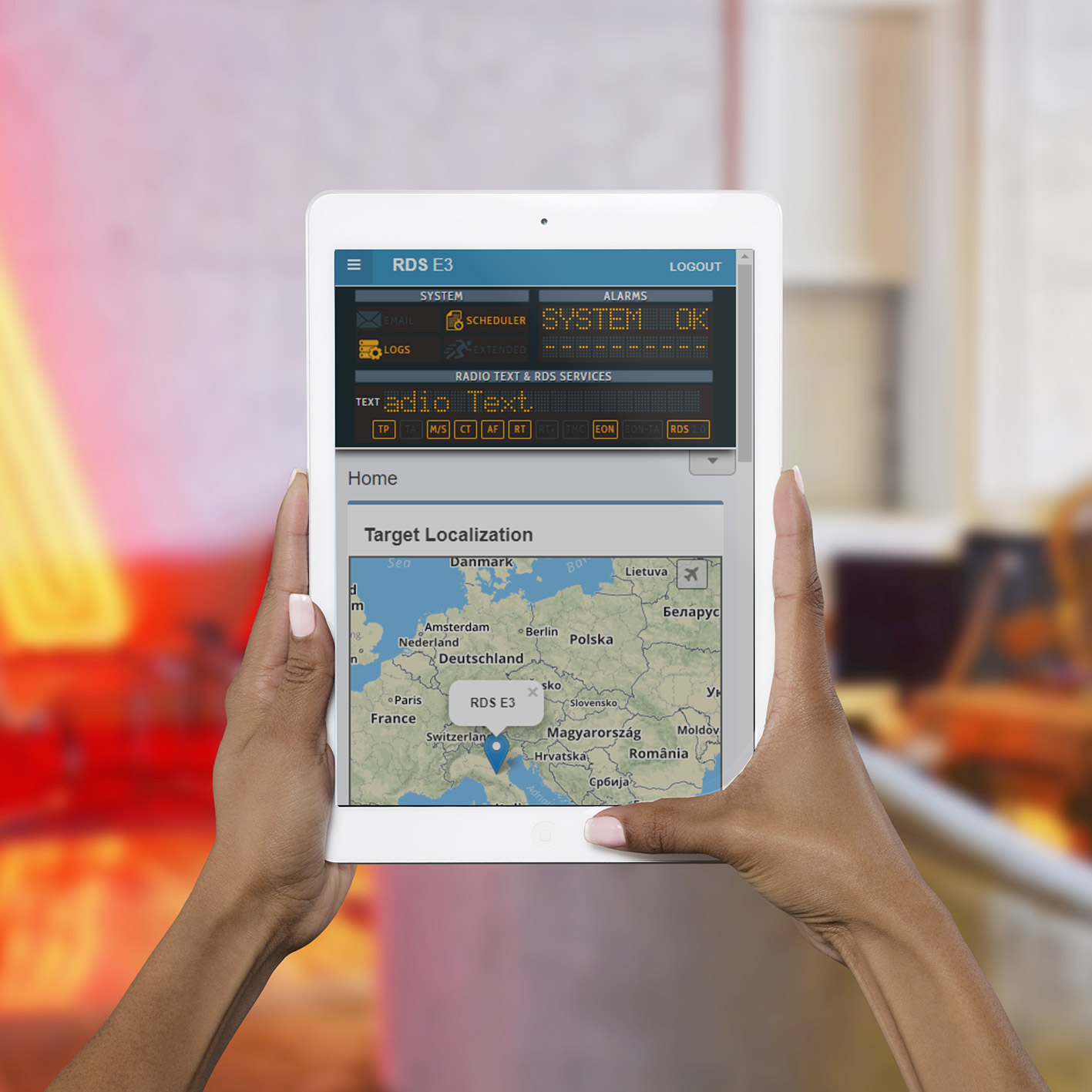
Easy Access
RDS E3 and RDS E5 are fully configurable via WEB interface. Their web server is compatible with all the available web browsers (Chrome, Firefox, Edge, Opera, Safari etc.).
RDS E3 and RDS E5 supports laptop, tablet and smartphones simplifying the browsing and setting of the device. They have a responsive-kind graphic interface that adapts the viewing mode according to the resolution and position (portrait/landscape) of the current viewing device.
The provided WiFi USB dongle creates a specific WiFi hotspot that enables the access to the device without the need of cabled or wireless net.
RDS E3 and RDS E5 have 3 IPV4 and 3 IPV6 addresses to ensure simultaneous connection to all the broadcasting and monitoring systems.
Easy Maintenance
Any first-time user can benefit from RDS E3 and RDS E5 simplified settings management.
QUICK RDS SETUP is the easier way to set the main RDS parameters.
IMPORT/EXPORT and PRESET MANAGER are available for RDS E3 and RDS E5’s advanced management.
These functions can be used for the whole device configuration or only for some selectable modules (SYSTEM, RDS, and TUNER).
RDS E3 and RDS E5 use a uSD card to create an automatic copy of all the device data when the user changes anything. If the device needs to be replaced or duplicated, the uSD card can be used to clone it.
Monitoring
RDS E3 and RDS E5 are provided with modern GUI (Graphical User Interface) that uses clear elements and useful information. The wide range of the available banners allows the user to monitor any function. The selected banners are always visible in any menu.
In the RDS section, a specific area is available for on-air RDS group analysis (static and dynamic) to evaluate services balancing.
Thanks to the FM Tuner (as an option), the FM signal can be received and decoded. With this feature it is possible to check MPX, RDS and Pilot deviations, BLER (Block Error Ratio) and RDS Decoder (PI, PS, RT, PTY, RT+,TP, TA, M/S, CT,AF,TMC, EON).
Technical Specifications
MPX Input – MPX
Connector Unbalanced on 2 BNC – EMI Suppressed
Input Impedance 50K
RDS+MPX Output - MPX
Outputs number 3 (2RDS out + 1 RDS)
Connector Unbalanced on 3 BNC – EMI Suppressed
Output Impedance 10 Ω
Load Impedance 600 Ω or greater
Maximum Load Capacitance 5nF
RDS Output Level 0 to 8191 mVpp (1 mVpp step)
S/N > 85dB
Carrier Suppression > 85dB
System
GPIO Inputs/Outputs 6 GPI / 4 GPO
Communication Port 2xRS232, 3xUSB, 1xLAN
Synchronization Ext(Pilot Mpx)/Int/ Auto
Synchronization Monitoring Yes
RDS Level adjustment Digitally controlled
Phase adjustment Yes, 0 ÷ 359.9°
Separate outputs for RDS+MPX and for RDS only Yes
Side Chain Mode, Loop through mode, Bypass feature Yes
RDS Subcarrier 100% Digitally Generated Shape
CENELEC – EN50067 compliant – Yes
Accurate Clock Time (CT) Sync with Internet Connection Yes
Remote TA actuation for Traffic Announcements Yes
GPS module for automatic synchronization of the built-in Real Time Clock (RTC) Optional (USB External)
In-field firmware update Yes
Front-panel Colour TFT Display No (RDS E3) Yes (RDS RDS E5)
Data may be entered on-site with Front-panel knob No (RDS E3) Yes (RDS RDS E5)
Front Panel Leds 40
Operating Temperature 0°C ÷ 50°C
RDS Features
Group supported All
Group Sequence Configurable
PS 8 DSN x MAIN+10 PSN
PI 8 DSN x MAIN+10 PSN
PIN & PTY RDS/RBDS
AF Method A up to 1024 (64 lists)
AF Method B up to 1024 (64 lists)
RT Yes, 32 messages
RT rate adjustment Group Sequence
RT+ for songs and content tagging Yes
TP Yes
TA Control Command, Software, GPI
PTYN Yes
EON 10 PSN
CT Yes
TMC, EWS, IH, TDC Yes
Free Format Groups (FFG) Yes
Open Data Application (ODA) Yes
PS Scrolling Yes
Scrolling by characters, by word, auto centre, long words’ truncation Yes (Characters – from 1 up to 8)
Communication
Connection with Automation Software Yes
Network Connectivity 4 TCP ports / 4 UDP / 1 SNMP
Configuration Software Web Server, FTP
Password Protection Yes
ASCII Protocol Configuration Messages
REST Command Yes
Embedded SNMP agent for active management tasks Yes
Supported Network Protocols HTTP, SMTP, UDP, TCP, NTP, FTP
UECP Protocol EBU SPB490 Ver.7.05
PI Calculator Yes
RDS 2.0 Ready Yes
PSU
Power Supply 90-260 Vac / 47-63 Hz 15W
Dimensions
Dimensions (W; H; D) 485 x 44 x 240 mm
Weight < 3Kg
Ask for aquote now
Subscribe to our newsletter
TIGER E3/E5
Premium
MPX Stereo Generator & RDS Encoder
The Tiger E3/E5 is a highly versatile device that serves multiple functions within the broadcasting and audio monitoring domain. Primarily, it is equipped to function as a high-performance MPX stereo generator capable of ensuring optimal stereo signal quality for radio broadcasting. In addition to this, it also serves as a reliable FM site control system, providing seamless management and control over FM broadcasting sites.
Furthermore, the Tiger E3/E5 incorporates cutting-edge technology to operate as a monitoring IP-audio codec, allowing for efficient and high-quality audio monitoring over IP networks. This feature is essential for maintaining consistent and high-fidelity audio transmission in various broadcasting scenarios.
In addition to its core functions, the Tiger E3/E5 integrates other advanced features that enhance its capabilities further. These include an audio changeover, an audio limiter, a stereo generator, an RDS encoder for embedding digital information into FM radio signals, an MPX changeover for smooth signal transition, and an integrated FM monitoring system with a built-in tuner for comprehensive monitoring and control.
Overall, the Tiger E3/E5 stands as a comprehensive and versatile solution, offering a wide array of functionalities to support efficient and high-quality broadcasting and audio monitoring operations.
Now Tiger E5 also embeds the brand new TigerSync Streamer feature, a cutting-edge technology that offers a way to distribute audio to FM transmitters through a simple Internet connection using IceCast, a reliable and flexible protocol.
Tiger E3/E5 can now be equipped with Thimeo MicroMPX codec for studio-to-transmitter link (STL) as an option.
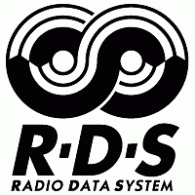

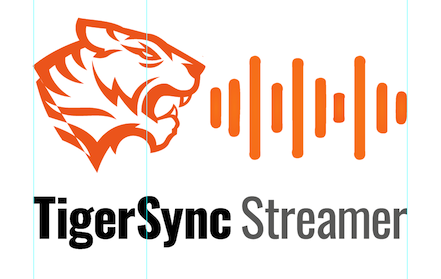

Connect Any Kind of Sources
Tiger E3/E5 manages any audio sources such as Analog & Digital audio, IP audio, Backup-Player, and MPX, thanks to the 4-channel audio changeover and 2-channel MPX Changeover. A delay can be assigned to any source and allows the time alignment of two or more sources. It is possible to use the internal audio player as a backup if all the external sources fail. The internal limiter continuously monitors the source audio levels, allowing the level to manage and avoid any overshoot generated by the satellite or IP-Audio MPEG decompression. MPX inputs are decoded (L&R) and available to be used as sources for the Audio Changeover or MPX Changeover. Digital MPX AES192 is available optionally (1 Out). MPX Changeover features a UECP filter that allows the regeneration or filtering of any RDS service (PS, RT, RT+IH, TMC, TA/TP), thus giving the user the chance to maintain, replace, or filter any RDS parameter starting from the incoming RDS signal. With the optional Tuner, it becomes a Changeover / FM Monitoring System with an integrated Tuner. Tiger E5 can manage and decode MPX and RDS signals, receive IP Audio streaming signals, and receive and analyze Analog and Digital audio signals. Thanks to the 4 channels Audio changeover and MPX Changeover it can handle every kind of received signal in a transmitting site.
Easy Access
Tiger E3/E5 is fully configurable via the WEB interface. Its web server is compatible with all the available web browsers (Chrome, Firefox, Edge, Opera, Safari, etc…). Tiger E3/E5 supports laptops, tablets, and smartphones simplifying the browsing and setting of the device with its responsive-kind graphic interface that adapts the viewing mode according to the resolution and position (portrait/landscape) of the current viewing device. The provided WiFi USB dongle creates a specific WiFi hotspot that enables access to the device without the need for cable or wireless net. Tiger E3/E5 features 3 IPV4 and 3 IPV6 addresses to ensure concurrent connection for all the broadcasting and monitoring systems.
Easy Maintenance
Any first-time user can take advantage of Tiger E3/E5 simplified settings management. Easy Configuration Function quickly and easily enables the user to set the working mode, while Quick RDS Setup brings the most simple way to set the main RDS parameters. Import/Export and Preset Manager are available for more advanced management of Tiger E3/E5. These functions apply to the whole device configuration or only to some selectable modules (System, RDS, MPX, Audio, Multimedia, and Tuner). Tiger E3/E5 uses a uSD card to create an automatic copy of all the device data whenever the user changes anything. If the device needs to be replaced or duplicated, the uSD card can be used to clone it.
Monitoring
Tiger E3/E5 features an endearing GUI (Graphical User Interface) that makes use of clear elements, rich in information. With a simple selection of the available banners, it is possible to keep under control any function. The selected banners are always visible in any menu. Tiger E3/E5 displays in both graphical and numerical format all the input and output levels as well as the internally generated signals. The visualization can be numerical, bar graph, or time-related.
In the RDS section, a specific area is available for on-air RDS group analysis (static and dynamic) to evaluate service balancing. In the MPX section, spectrum analyzers display the MPX+RDS input and output signals. TIGER E3/E5 provides two independent listening paths for every internal audio source. Local: use the headphone socket on the front panel and the display to select the source. Remote: using the internal IP audio encoder that enables the remote audio receiving with different listening quality choices. The MPX decoder lets the user listen to the decoded L&R audio for any of the MPX sources, input, output, or internal.
NEW: TigerSync Streamer
The TigerSync Streamer solution by AxelTech offers a way to distribute audio to FM transmitters via web technologies using IceCast, a reliable and flexible protocol.
IceCast can handle thousands of connections and allows up to 15,000 users to listen without interruptions when the audio is uploaded to a cloud server. This protocol is unsuitable for traditional broadcasting as it is not synchronous and can result in a 1 to 5-second difference for users listening to the same radio broadcast. For instance, when the FM Tuner is equipped with automatic frequency control (RDS-AF) while driving, the seamless transition between the transmitters is imperative for ensuring an uninterrupted listening experience for the user.
AxelTech’s R&D efforts have been focused on ensuring that this technology is compatible with broadcasting needs. With the TigerSync Streamer option, a Tiger E5 Encoder serves as the network’s hub, handling the encoding process and transmitting the signal to an IceCast server. This can be the Tiger‘s internal IceCast server, with a limited number of reception points (up to 15) due to the Tiger‘s resource constraints, or an IceCast server set up on a Linux cloud server.
With TigerSync Streamer we have implemented a sophisticated method for synchronizing audio using inaudible timestamp codes. These codes are transmitted through the Opus codec at rates ranging between 32Kbits/sec to 510 Kbits/sec (or MP3 192kbits-320kbits/sec) and then distributed via an IceCast Server. On the receiving end, the Tiger devices capture the IceCast stream and timestamp data, ensuring precise synchronization for audio playback. As a result of this synchronization approach, there is a consistent delay lasting anywhere from 1.0 to 10 seconds, with the optimal latency falling within the range of 2 to 3 seconds. This fixed audio latency remains uniform across all decoding Tiger units in comparison to the encoding units, resulting in a reception delay. However, TigerSync Streamer guarantees that all decoders maintain synchronization with an impressive accuracy of a few milliseconds.
In the initial stages of the project, the target synchronization between decoded audio over the network was set at 30 ms. However, the achieved result surpassed expectations, with the delay being below 5 ms. While the system was not designed as an isofrequency, it effectively ensures the alignment of all transmitters and facilitates imperceptible transmitter changes.
TigerSync Streamer, designed to provide a backup feed to transmitters, has exceeded expectations by proving itself in the field as a technology capable of powering the distribution network through a solid, precise, and low-cost infrastructure.
NEW: Micro MPX
Tiger E3/E5 can now be equipped with Thimeo MicroMPX codec for studio-to-transmitter link (STL) as an option.
MicroMPX transports full FM composite MPX signal, including pilot and RDS, at 320kbit/s with perfect peak control over private and public networks.
The new option includes a dedicated internal hardware module with a separate LAN connector and internal audio input/output in digital format for perfect audio quality.
The MicroMPX lovers can now take advantage of all the additional options allowed by AxelTech Tiger E3/E5, like four channel changeover, backup SD card audio player, RDS post-processing, MPX, and RDS decoding for monitoring, and many more, which can satisfy any need at the transmitting site.
General
- Main Supply 90–260Vac 50/60Hz. 15W;
- Green device – only 15W;
- Full Color Graphic display 480×128 (only Tiger E5);
- Status LED panel with 40 LEDs;
- Rack 1u 19” – Inox steel;
- Redundant PSU (available as an option);
- Redundant PSU 12-36VDC (available as an option);
- High immunity to strong RF fields, designed to be installed in high-power TX sites;
- Fully Digital – No trimmer.
Inputs & Stereo Generator Section
- Analog input on XLR;
- Digital AESEBU input on XLR;
- Double streaming IP input (MP3, OPUS, PCM, VORBIS…);
- Double MPX output with independent source and level;
- Optional Digital MPX AES192 (1 Out);
- Bypass HW on MPX Outputs (Aux-1 to Out 1&2);
- 2 AUX input (MPX/RDS/SCA) wide band – digitally controlled;
- MPX Changeover between external or internal MPX sources;
- 2 Wide Band mixer to mix internal (Stereo generator and RDS) or external (MPX, RDS, or SCA) signals;
- Configurable delay on MPX signals;
- AGC on each single source;
- Limiter, Clipper MPX;
- ITU BS412 control;
- ITU Loudness measurement;
- Outband noise and Pilot Noise Measurement;
- RDS, Pilot, Main Audio, and Sub Audio Measurement;
- Integrated Hi-Quality MPX Decoder.
Process
- 4 channels Audio Changeover Changeover Audio with source priority / restore logic;
- Backup audio player on SD card;
- Configurable delay on Audio sources;
- Configurable UECP Filter on incoming RDS Signal (AUX-1) for rebroadcasting use;
- Capability to digitally erase RDS signal on incoming MPX+RDS Signal;
- Upgrade FW directly on the field managed by the web GUI interface;
- Audio limiter integrated (Band controlled, Psychoacoustic, Look-ahead, ITU BS412);
- Fast DSP Starting time <5 sec (OS < 30 sec).
Encoder RDS Section
- RDS encoder fully compliant with UECP EBU SPB490 v7.05, CENELEC (Europe) and NRSC (America);
- Fully support all the RDS services, Static, and Dynamic services;
- UEPC Ports (2 Serials, 4 TCPIP, 4 UDP);
- n.8 Data Set;
- n.10 EON + Main PS for each Data Set;
- Integrated RDS decoder;
- Tuner FM with RDS decoder (as an option);
- Dataset switch managed by UECP/SNMP/REST/HTTP/ASCII PARSER/TXT FILE/GPI;
- Easy to interface with any Radio Automation (UECP/SNMP/REST/HTTP/ASCII PARSER/TXT FILE);
- Capability to connect with any Radio Automation to get data for RDS (PS/RT/RT+/TA/MS);
- Easy RDS page fast setup.
GUI & Monitoring
- Fully programmable by Web GUI interface, all the browsers are supported;
- Simple and intuitive GUI, supported by all devices (PC, notebook, tablet, smartphone, etc. ..);
- Easy and configurable graphical interface;
- Multi-user web GUI;
- Map with device geolocation (RX sat or fixed coordinates are required);
- Web GUI with info bubbles;
- Monitoring FM Tuner (as an option);
- MPX spectrum signal Analyzer on outputs, Aux inputs, and internal signals;
- Dynamical graphics to see the value in the time;
- RDS Groups data analyzer;
- GUI with LED meter bars;
- IP audio streaming encoding for remote audio monitoring, with independent source selection and level;
- Headphones output with independent source selections and level.
Monitoring Tuner (optional)
- RF Level measurement;
- Carrier Offset;
- MPX, RDS, and Pilot deviations;
- BLER (Block Error Ratio);
- RDS Decoder (PI, PS, RT, PTY, RT+, TP, TA, M/S, CT, AF, TMC, EON).
Communications & Management
- Ethernet/USB/RS232/GPIO connections;
- 2nd Ethernet (as an option);
- Easy WiFi Access – Hot spot WiFi USB to connect directly a wireless device to the Tiger;
- SNMP V2c;
- Set up to 3 NTP Servers (V1, V2, V3, V4);
- Possibility to send email to 4 receivers and set 3 different SMPT Server;
- IPV4 and IPV6 support (3 addresses IPV4 and 3 addresses IPV6);
- N°2 RS232 for UECP commands;
- 6 GPI and 4 Relay Out (all GPIO are fully programmable by the GUI);
- HTTP, FTP, SNMP, SMTP, UDP, TCP support;
- Alarms via: TRAP (SNMP), email(SMTP), GPO, HTTP;
- External GPS support (Time, Date, and Geolocation);
- uSD Card for clone function for maintenance, and easy replacement of a faulty unit;
- Import and export configuration functions;
- PRESET, with load/save/import /export functions;
- Logs 24/7 with export function;
- 6 levels of right access management;
- Easy configuration page setup with info connection diagrams;
- REST API to manage the device;
- ASCII PARSER interface for easy command line settings;
- SAMBA SHARE function to connect and get data from an external PC;
- Multi-user contemporary access.
NEW: TigerSync Streamer
The TigerSync Streamer solution by AxelTech offers a way to distribute audio to FM transmitters via web technologies using IceCast, a reliable and flexible protocol.
IceCast can handle thousands of connections and allows up to 15,000 users to listen without interruptions when the audio is uploaded to a cloud server. This protocol is unsuitable for traditional broadcasting as it is not synchronous and can result in a 1 to 5-second difference for users listening to the same radio broadcast. For instance, when the FM Tuner is equipped with automatic frequency control (RDS-AF) while driving, the seamless transition between the transmitters is imperative for ensuring an uninterrupted listening experience for the user.
AxelTech’s R&D efforts have been focused on ensuring that this technology is compatible with broadcasting needs. With the TigerSync Streamer option, a Tiger E5 Encoder serves as the network’s hub, handling the encoding process and transmitting the signal to an IceCast server. This can be the Tiger‘s internal IceCast server, with a limited number of reception points (up to 15) due to the Tiger‘s resource constraints, or an IceCast server set up on a Linux cloud server.
With TigerSync Streamer we have implemented a sophisticated method for synchronizing audio using inaudible timestamp codes. These codes are transmitted through the Opus codec at rates ranging between 32Kbits/sec to 510 Kbits/sec (or MP3 192kbits-320kbits/sec) and then distributed via an IceCast Server. On the receiving end, the Tiger devices capture the IceCast stream and timestamp data, ensuring precise synchronization for audio playback. As a result of this synchronization approach, there is a consistent delay lasting anywhere from 1.0 to 10 seconds, with the optimal latency falling within the range of 2 to 3 seconds. This fixed audio latency remains uniform across all decoding Tiger units in comparison to the encoding units, resulting in a reception delay. However, TigerSync Streamer guarantees that all decoders maintain synchronization with an impressive accuracy of a few milliseconds.
In the initial stages of the project, the target synchronization between decoded audio over the network was set at 30 ms. However, the achieved result surpassed expectations, with the delay being below 5 ms. While the system was not designed as an isofrequency, it effectively ensures the alignment of all transmitters and facilitates imperceptible transmitter changes.
TigerSync Streamer, designed to provide a backup feed to transmitters, has exceeded expectations by proving itself in the field as a technology capable of powering the distribution network through a solid, precise, and low-cost infrastructure.
New: Tiger-Digital MPX Output
Option (hardware) for Digital AES EBU MPX 192KHz output.
Output available on XLR.
New: Micro MPX Encoder/Decoder Option
Option to generate/receive a uMPX stream (hardware and software).
The Tiger E3/E5 handles this stream as an auxiliary input to which it can add/remove/mix other MPX/RDS signals.
The option includes the adding of an Ethernet port to receive/transmit uMPX streaming.
Tiger-Tuner
Option to receive an FM signal (hardware).
The Tuner measures the following parameters (RF, Multipath, Carrier Offset, MPX, Pilot, RDS, BLER) and decodes the following RDS services (PI, PS, PTY, RT, TA, TP, MS, Presence of: CT, AF, RT, RT+, TMC, EON). The alarms configuration can be controled by a dedicated page.
The tuner can also be used as a rebroadcast source or as feedback for station OFF-AIR monitoring.
Second Ethernet Port
Option (hardware) for adding the second ethernet port.
Redundant PSU 90-260 Vac
Redundant Power Supply.
Redundant DC PSU 12-36VDC
Redundant Power Supply.
| Analog Left & Right Input | |
|---|---|
| Connector | Balanced on 2 XLR – EMI Suppressed |
| Input Impedance | 10Kohm |
| Nominal Input Level (Sensitivity) | Software Adjustable from -12dBu to + 13,0 dBu (0,1dB step) |
| Nominal Input Level | -21,0dBu ÷ +24,0dBu |
| Max Input Level (clipping point) | Selectable +15,0dBu or +24,0dBu |
| A/D conversion | CS4272, 24 bit / 48 Khz |
| Input CMRR | >60dB (20Hz-20kHz) |
| Digital Input | |||||
|---|---|---|---|---|---|
| Connector | Balanced on 1 XLR – EMI Suppressed | ||||
| Input Impedance | 110Ω | ||||
| Standard | AES3 | ||||
| Audio Sample Rate | 32/44.1/48/96/192KHz | ||||
| Adjustable Nominal Input Level (Sensitivity) | From -25,0dBFS to -0,2dBFS (0,1dB step) | ||||
| Nominal Input Level | -36dBFS ÷ 0,0dBFS | ||||
| Dynamic Range (Converter Values) | 124dB (32KHz) – 126dB (44,1KHz) 126dB(48KHz) – 122dB (96KHz) | ||||
| Resolution | 24 bit |
| MPX Input – MPX - AUX1/AUX2 | |
|---|---|
| Connector | Unbalanced on 2 BNC – EMI Suppressed |
| Input Impedance | 50K |
| Adjustable Nominal Input Level (Sensitivity) | Software Adjustable -9dBm to +15,0dBm |
| Range of Level | -21,0dBu ÷ +24,0dBu |
| Max Input Level (clipping point) | Selectable +5,0dBu or +18,0dBu |
| A/D Conversion | Texas PCM4202 |
| MPX Output - MPX - MPX1/MPX2 | |
|---|---|
| Connector | Unbalanced on 2 BNC – EMI Suppressed |
| Output Impedance | 10 Ω |
| Load Impedance | 600 Ω or greater |
| Maximum Load Capacitance | 5nF |
| D/A Conversion | Texas PCM 1796 |
| Composite Output Level | -0,0dBm to +15,0 dBm (0,1 dBm step) |
| S/N | ≥ 85dB |
| THD | ≤ 0.01% |
| Separation | ≥ 70dB |
[table “” not found /]
[table “” not found /]
| Backup Player | |
|---|---|
| Support | On Micro SD CARD (max 64GB) |
| Supported formats | MP3, WAV |
| Supported Sample Rates | 32,44.1,48,64,96 KHz |
| MPX & RDS Signal | |
|---|---|
| Pilot Frequency | 19 KHz +/- 1Hz |
| Pilot Injection | Adj from -25,0dB a -15,5dB (0,1 dB step); 6 to 18% of total deviation |
| Pilot Stability | ±10 ppm (-10 to +55°C) |
| Pilot Distortion | 0,05% (typical) |
| Pilot Distortion + Noise | 0,068% (on 100KHz band) |
| Composite out THD | 0,01% (typical on the whole band) |
| Stereo Separation | >70 dB (typical on the whole band) |
| Linear Crosstalk Main to Sub / Sub to Main | >70 dB (minimum) |
| Digital filtering / band | 30 Hz to 15 kHz (-0,1dB), 17 kHz (-70 dB), 19 kHz (-100 dB) |
| 57 kHz (RDS/RBDS) Protection | Better than 51 dB |
| Pre-emphasis | Off, 50uS, 75uS (+/-0,1dB) |
| Freq Response | ±0,3 dB (30Hz-15kHz) |
| Operation | Mono / Stereo |
| MPX/RDS Output | Adj from -10,0 dB to 15,0 dB (0,1 dB step) |
| Signal/Noise Ratio | ≥ 85 dB (on 100 kHz band) |
| Carrier Suppression | > 85 dB |
| Digital Output MPX - Option | |
|---|---|
| Connectors: | Balanced on 1 XLR – EMI Suppression |
| Input impedance: | 110 Ω |
| Format: | AES192 |
| Sample rate: | 192 KHz |
| Output level adjustment: | From 0,0 dBFs to –30,0 dBFs (0,1 dB steps) |
[table “” not found /]
| System | |
|---|---|
| GPIO Inputs/Outputs | 6 GPI / 4 GPO |
| Communication Port | 2xRS232, 3xUSB, 1xLAN |
| Synchronization | Ext(Pilot Mpx)/Int/ Auto |
| Synchronization Monitoring | Yes |
| RDS Level adjustment | Digitally controlled |
| Phase adjustment | Yes, 0 ÷ 359.9° |
| Separate outputs for RDS+MPX and for RDS only | Yes |
| Command to activate the RDS SCA | Yes |
| Side Chain Mode, Loop through mode, Bypass feature | Yes |
| RDS Subcarrier | 100% Digitally Generated Shape |
| CENELEC – EN50067 compliant – | Yes |
| Accurate Clock Time (CT) Sync with Internet Connection | Yes |
| Remote TA actuation for Traffic Announcements | Yes |
| GPS module for automatic synchronization of the built-in Real Time Clock (RTC) | Optional (USB External) |
| RDS decoder for rebroadcasting RDS Data | Yes |
| Firmware can be upgraded on the field | Yes |
| Front-panel Colour TFT Display | No (Tiger E3) Yes (Tiger E5) |
| Data may be entered on-site with Front-panel knob | No (Tiger E3) Yes (Tiger E5) |
| Front Panel Leds | 40 |
| Operating Temperature | 0°C ÷ 50°C |
| RDS Features | |
|---|---|
| Group supported | All |
| Group Sequence | Configurable |
| PS | 8 DSN x MAIN+10 PSN |
| PI | 8 DSN x MAIN+10 PSN |
| PIN & PTY | RDS/RBDS |
| AF Method A | up to 1024 (64 lists) |
| AF Method B | up to 1024 (64 lists) |
| RT | Yes, 32 messages |
| RT rate adjustment | Group Sequence |
| RT+ for songs and content tagging | Yes |
| TP | Yes |
| TA Control | Command, Software, GPI |
| PTYN | Yes |
| EON | 10 PSN |
| CT | Yes |
| TMC, EWS, IH, TDC | Yes |
| Free Format Groups (FFG) | Yes |
| Open Data Application (ODA) | Yes |
| PS Scrolling | Yes |
| Scrolling by characters, by word, auto centre, truncate long words | Yes (Characters – from 1 up to 8) |
| Communication | |
|---|---|
| Connection with Automation Software | Yes |
| Network Connectivity | 4 TCP ports / 4 UDP / 1 SNMP |
| Configuration Software | Web Server, FTP |
| Password Protection | Yes |
| ASCII Protocol | Configuration Messages |
| REST Command | Yes |
| Alert notifications on user-defined events via SNMP traps or E-mails | Yes |
| Embedded SNMP agent permitting active management tasks | Yes |
| Supported Network Protocols | HTTP, SMTP, UDP, TCP, NTP, FTP |
| UECP Protocol | EBU SPB490 Ver.7.05 |
| PI Calculator | Yes |
| RDS 2.0 Ready | Yes |
| PSU | |
|---|---|
| Power Supply | 90-260 Vac / 47-63 Hz 15W |
| Dimensions | |
|---|---|
| Dimensions (W; H; D) | 485 x 44 x 240 mm |
| Weight | < 3Kg |
Falcon XT
Radio has the power
FALCON XT is the top class digital audio processor that also features Stereo Generator and RDS Encoder. It’s the full optional and most prestigious equipment, designed for those broadcasters that really want to get the best performances.
FALCON XT ensures top quality performances and exclusive audio. It features powerful DPSs, 5-band architecture, dual band AGCs, 3-band equalizer, stereo enhancer, speech detector and 4 limiters. The comprehensive and accurate control of each audio parameter allows to shape perfectly the audio to broadcast unique and exceptional branded sound.
The LAN port and the built-in Web Server allow to control the processor and tune audio from anywhere. The built-in digital Stereo Generator ensures an extremely precise MPX Signal. The RDS Encoder (optional) is in compliance with UECP SPB490, provides 2 Data Set with a wide range of static services, including Radio Text.
FALCON XT features full connectivity with analog and digital I/O (over XLR connectors) and 2 independent MPX outputs, USB, GPI and serial ports. The hardware bypass circuit is always included to guarantee audio presence and audio programs continuity.
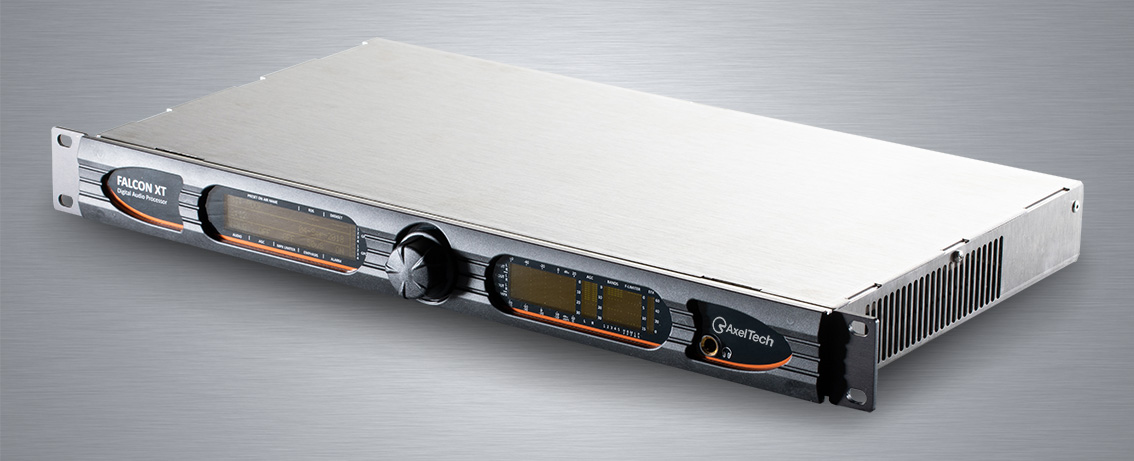




Highlights
General
- Main Supply 90--260Vac 50/60Hz. 15W
- Green device - only 25W
- Dual Graphic display
- 1RU standard 19” - Inox steel
- High immunity to strong RF fields, designed for high power TX sites
- Fully Digital
Inputs Outputs
- Analog input on XLR,
- Analog Input Settings : Sensitivity, Input Mode, Phase Rotator and High Pass Filter
- Analog Output on XLR
- Analog Output Settings: Level, Preemphasis, Source and Impedance.
- Bypass HW on Analog Outputs (Analog Input to Analog Output)
- Digital AESEBU input on XLR
- Digital AESEBU Input Settings: Sensitivity, Input Mode, Phase Rotator and High Pass Filter
- Digital AESEBU Output on XLR
- Digital AESEBU Output Settings: Level, Preemphasis, Source, Rate, Resolution
- Bypass HW on Digital AESEBU Outputs (Digital Input to Digital Output)
- Automatic audio input changeover
- Double MPX output with independent and level setting.
- Bypass HW on MPX Outputs (Aux-1 to Out 1&2)
- 2 AUX input (MPX/RDS/SCA) wide band
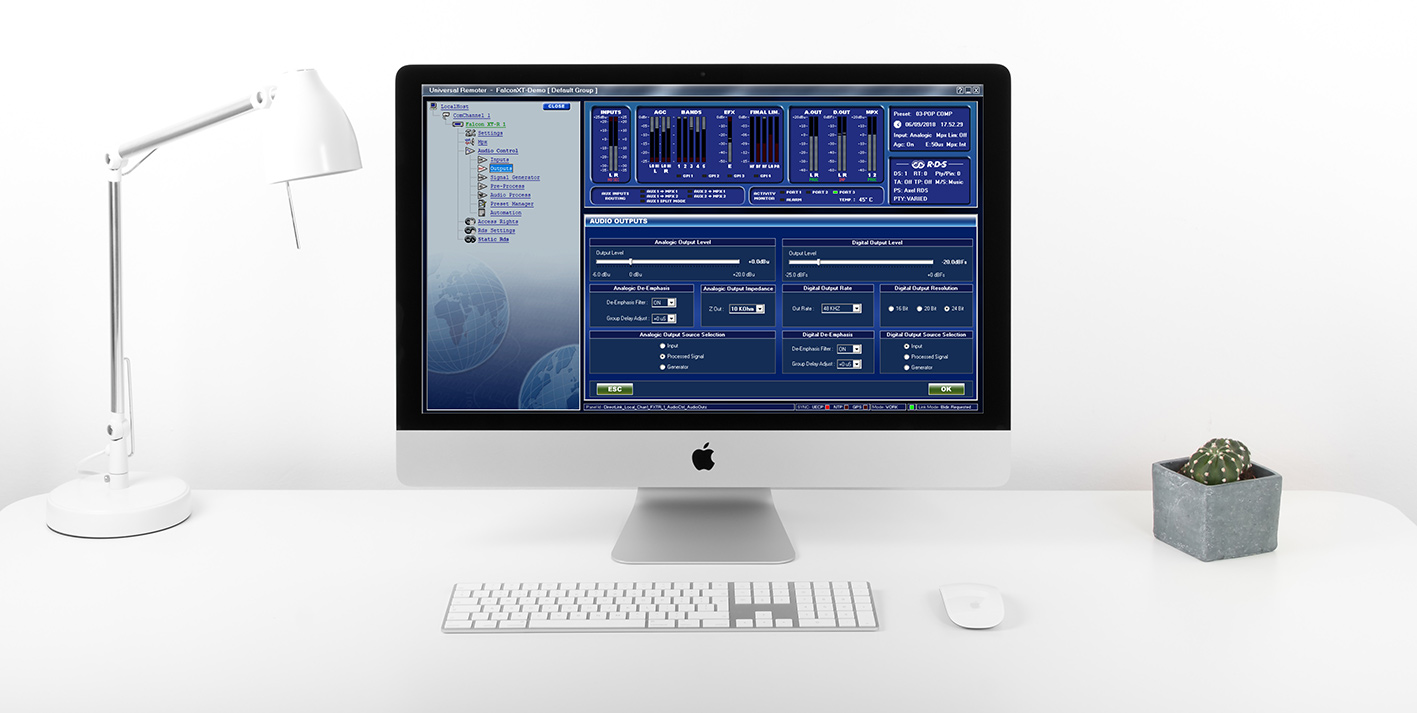
Process & Stereo Generator Section
- 5-Band digital audio processor
- Multiband agc
- Mpx power control - ITU-R BS.412
- Fast DSP Starting time <5 sec (OS < 30 sec)
- Brilliance control
- Expander control
- Overdrive control
- Super bass harmonizer control
- Speech detector
- 3-Band EQ control
- Stereo enhancer function
- Limiter lookahead
- Clipper MPX
- Pilot level and Phase control
- ITU BS412 control
Encoder RDS Section
- Digital RDS encoder
- RDS encoder compliant with UECP EBU SPB490 v7.05, CENELEC (Europa) and NRSC
- (America).
- RDS Level and Phase control
- 2 dataset with 1 Main PS + 10 EON
- Dataset switch managed by UECP/SNMP/ASCII PARSER/GPI.
- Service Groups settings
- UEPC Ports (2 Serials + LAN).
- Access Rights management for each communication port
- RDS Services : PI, AF, PS, RT, CT, M/S, DI, TP, TA, PIN, PTY, SLC0-7, LA, EG, ILS, LSN
- AF: 64 AF lists (max 25 Frequencies)
- RT: 16 strings (max 64 chr)
- RDS Scheduler max 64 events
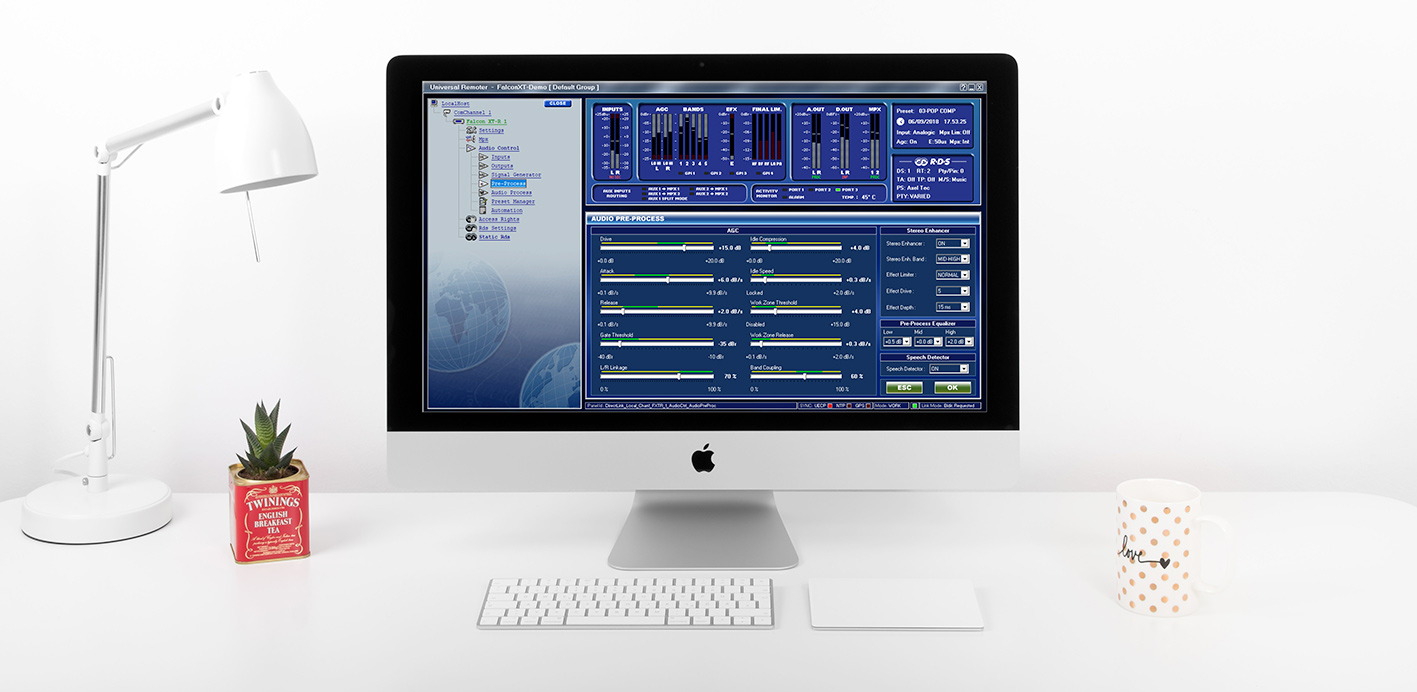
GUI & Monitoring
- Fully programmable by Windows GUI interface.
- Simple and intuitive Web GUI.
- RDS Monitor with Data Set, RT number, PTY, TA, TP, M/S, PS on air
- GUI with led meter bars
- Headphones output with level control
Communications & Management
- Ethernet/USB/RS232/GPIO connections
- UECP - Individual Address Manager
- SNMP V1
- NTP Address for Time and Date synchronization
- SNMP Manager Address
- N°2 RS232 for UECP commands
- 4 GPI and 4 GPO (DB 15p F HD)
- HTTP, SNMP, TCP support
- External GPS support for Time and Date Synchronization (by Sat Time Synchronizer)
- Import and export configuration functions
- PRESET, with load/save/import/export functions
- Easy configuration page setup
- ASCII PARSER interface for easy command line settings
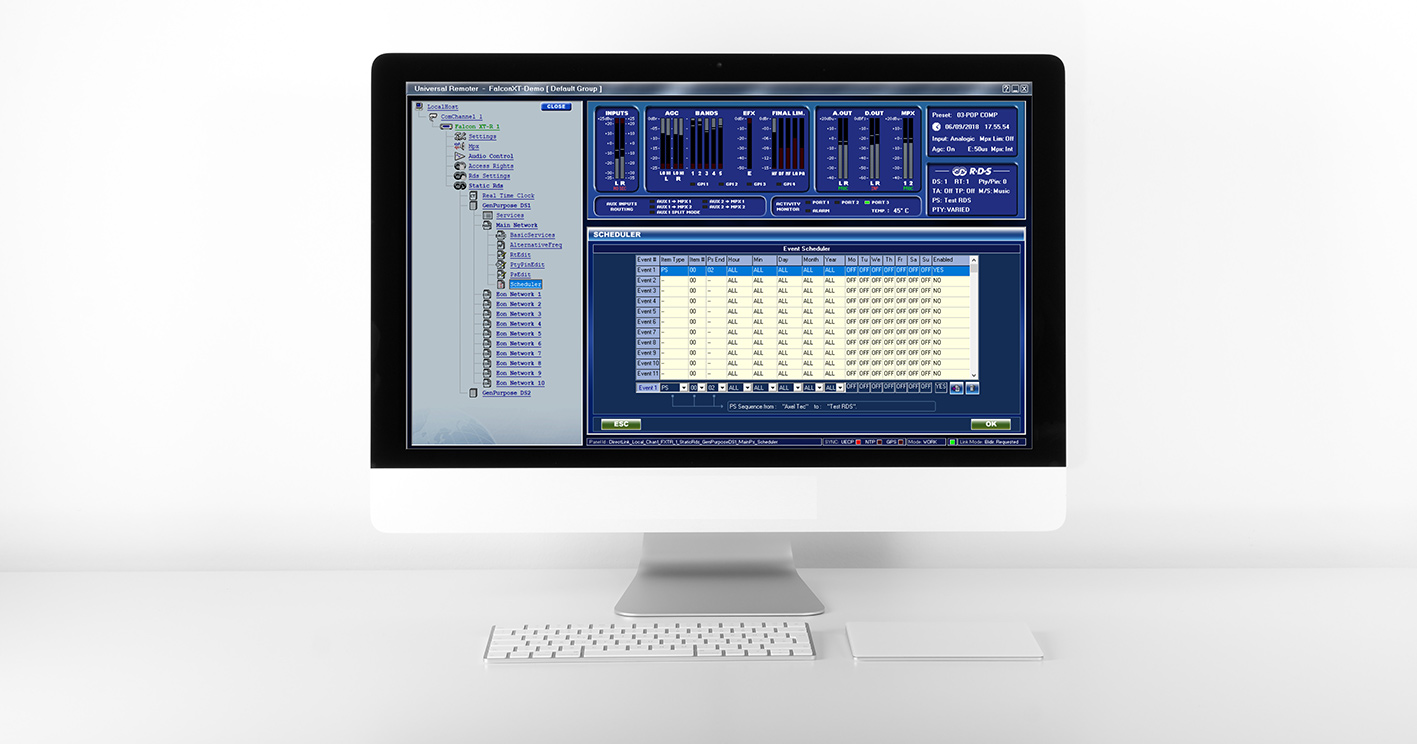
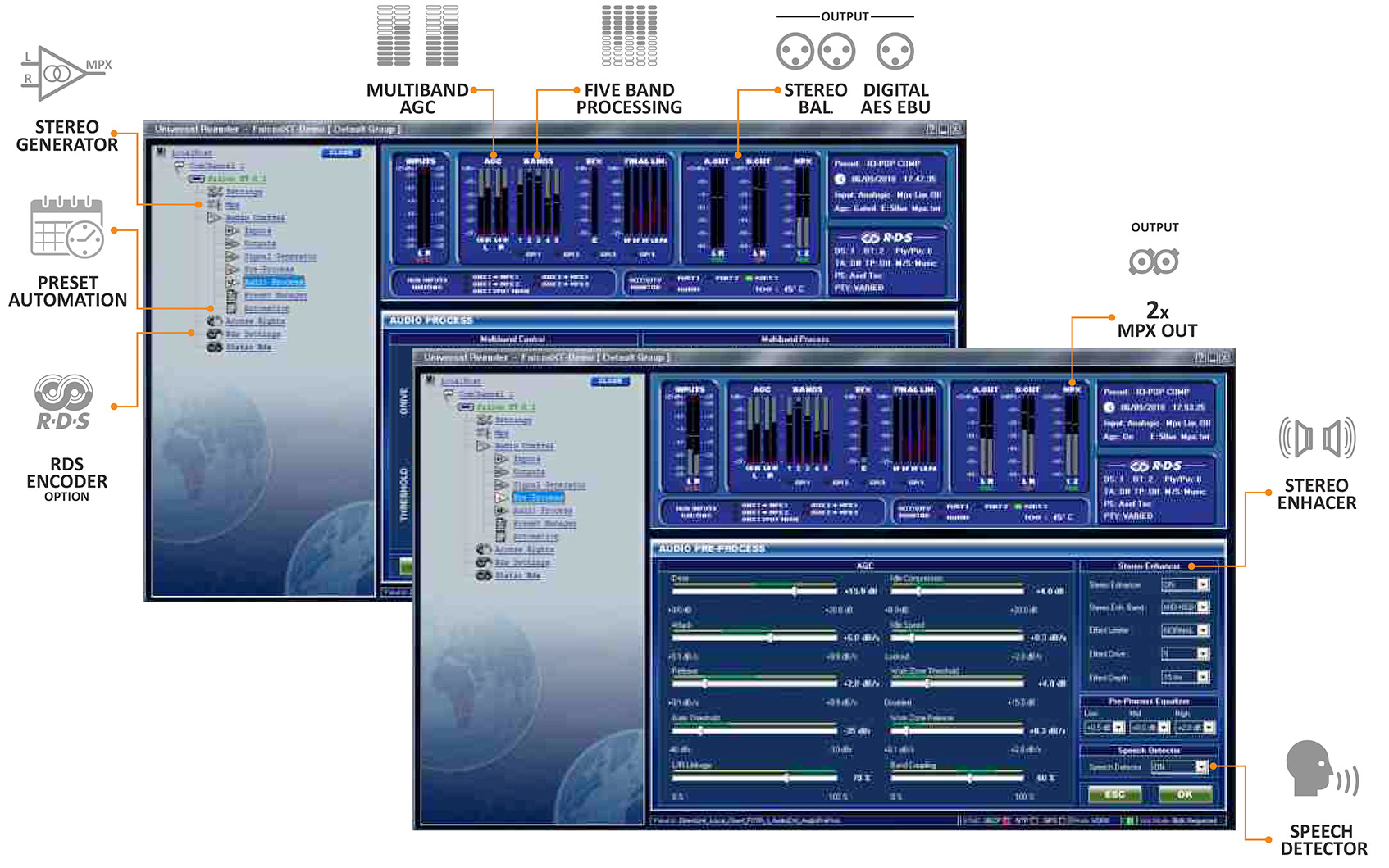
Special Features
Falcon XT is the top class digital audio processor that also features Stereo Generator and RDS Encoder.
It is the full optional and most prestigious equipment designed for those broadcasters that really want to get the best performances.
Falcon XT ensures top quality performances and exclusive audio.
It features powerful DPSs, 5-band architecture, the dual band AGCs, 3-band equalizer, stereo enhancer, speech detector and 4 limiters.
The comprehensive and accurate control of each audio parameter allows to shape perfectly the audio to broadcast unique and exceptional branded sound. The LAN port and the built-in Web Server allow to control the processor and tune the audio from anywhere. The built-in digital Stereo Generator ensures an extremely precise MPX Signal.
The RDS Encoder (optional) is in compliance with UECP SPB490, provides 2 Data Set with a wide range of static services, including Radio Text.

The hardware bypass circuit is always included to ensure audio presence and audio programs continuity. Falcon XT meets the most demanding broadcasters with extremely sophisticated audio features and high standards level: 5-band control compression, dual-band power AGC, three-band EQ and Brightness control.
The Stereo Enhancer parameterized command provides to radio station sound, spacing effect and large stereo horizon opening.
With phases control of mono audio signals, the voice sounds more natural, the Expander control allows to minimize background or unwanted noise, while the Overdrive and the Super Bass improve the sound on low and very low frequencies, creating an impressive effect of loudness.
Furthermore, the SuperBass Harmonizer controls the distortion of bass sound/low frequency, creating a unique sound effect, increasing the energy transmitted by the low frequency. Listening experience becomes beyond compare.
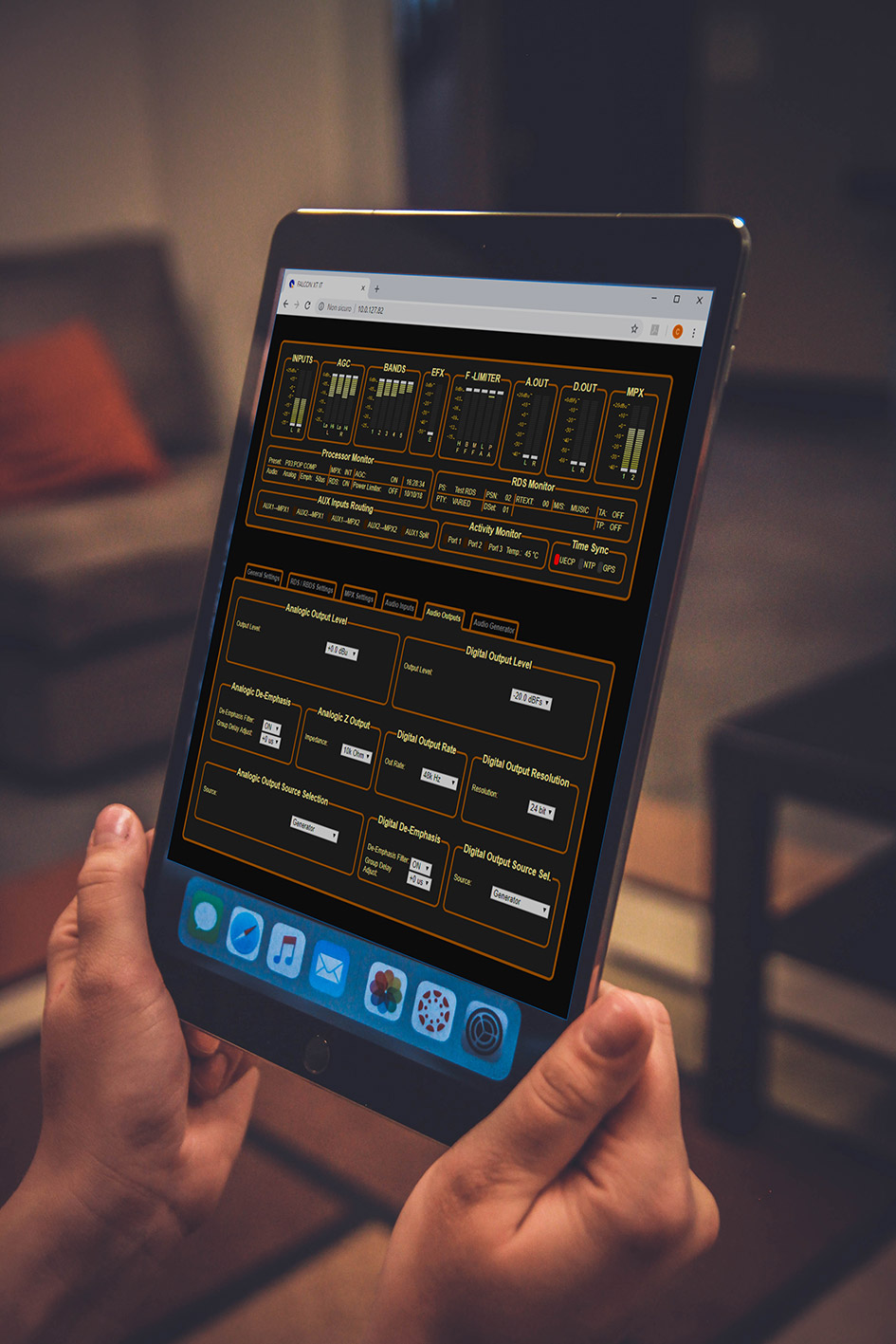
Technical Specifications
GENERAL
Dimensions 434x351x44 mm (1 rack unit)
AC Rate 230 Vac/110 Vac 50 Hz/60 Hz 30 VA
Power factor 0.9
Type of power supply Switching power supply
Processing architecture Fully digital, based on DSP 24 bit/100 Mhz. Signal processing is performed by phase linear filter
Weight ≈ 5 Kg
Operating Temperature -5°C/+50°C
Safety Standard CE, ETL, UL.
Grounding One more earth terminal is provided in Falcon XT body to connect audio earth connection
ANALOG INPUT MODULE
A/D Conversion 24bit Sigma-Delta Conversion (Crystal CS4272)
Connectors XLR, female - Electronically balanced
AD Clipping Point +24.0dBu
Operative Nominal Level From – 12.0dBu to +12.0dBu (0.1dBu Step)
Line Impedance 10 kΩ (Electronically balanced selectable) EMI–suppressed
Distortion less than 0.01% TDH+NOISE (0.0dBu 1 kHz)
AD Dynamic Range 108 dB RMS (110 dB A weighted)
Input Modes Stereo, Mono (Left), Mono (Right), Mono (Left+Right)
DIGITAL INPUT MODULE
Connectors XLR, female – Electronically balanced
Format AES3/EBU
Sample rates 32 kHz/44.1 kHz/48 kHz/64 kHz/88.2 kHz/96 kHz with src and jitter correction
Operative Nominal level From 0.0 dBFs to -24dBFs (0.1 dBu step)
Dynamic Range 125 dB (Typ), 122 dB (Min)
Distortion less than 0.01% TDH+NOISE (0.0dBu 1kHz)
Input Modes Stereo, Mono (Left), Mono (Right), Mono (Left+Right)
ANALOG OUTPUT MODULE
D/A Conversion 24bit Sigma-Delta Conversion (Crystal CS4272)
Connectors XLR, male - Electronically balanced
Output Level -6.0dBu to +20.0dBu (0.1dBu Step) – Max (+20dBu)
Impedance Source 10 Ω
Load Impedance 600 Ω or greater
THD + Noise Less than 0.01% (0.0dBu @ 1 kHz)
Signal to noise Ratio >80 dB unweighted - 100% Mod. 20 Hz – 15 kHz
L/R CrossTalk < –70 dB, 20 Hz–15 kHz
DIGITAL OUTPUT MODULE
Connectors XLR, Male – Electronically balanced
Format AES3/EBU
Sample rates 32 kHz/44.1 kHz/48 kHz/64 kHz/88.2 kHz/96 kHz with src and jitter correction
Resolution 16 bit – 20 bit – 24 bit
Operative Nominal level From 0.0 dBFs to - 25dBFs (0.1 dBu step)
Dynamic Range 125 dB (Typ), 122 dB (Min)
Distortion less than 0.01% TDH+NOISE (0.0dBu 1Khz)
Input Modes Stereo, Mono (Left), Mono (Right), Mono (Left+Right)
REMOTE INTERFACE
Digital Inputs GPIn 4x GP In optocoupled
Digital Outputs GPOut 4x GP Out Open Collector optoisolated
Serial Interface 2x RS-232 Serial protocol ports EMI filtered
USB 1x Universal Serial Bus port – B type EMI filtered
Ethernet Port and Parser ASCII protocol Ethernet (option), over RJ45 connector with web server interface.
MPX/COMPOSITE OUTPUT
Mod Power Limiter adjustable from -1.0dB to +12dB according to ITU-R BS.412
Pilot Frequency 19 kHz +/- 1Hz
Pilot Level -25.5 to -14.0dB in 0.1dB/Step - Ref 100% Mod
Pilot Stability 19 kHz, ± 1 Hz.
Pilot Phase Adjustable +/- 12 deg. 1 deg step
Pilot THD+Noise 0.03% (TDH 0.002%)
Stability +/-10 ppm (-10 to +55 °C)
Signal-to-Noise Ratio (S/N) > 85dB on a 60 kHz Bandwitdh, referenced to 100% modulation, unweighted
Distortion <= 0.01% THD - Bypass mode, de-emphasized, 20 Hz – 15 kHz bandwidth, referenced to 100% modulation, unweighted
Stereo Separation Greater than 70 dB, 30 Hz – 15 kHz
Linear Crosstalk >-80 dB - main channel to sub-channel or sub-channel to main channel referenced to 100% modulation
38 kHz Suppression >= 70 dB (referenced to 100% modulation)
Pilot Protection > 65 dB relative to 10% pilot injection, ± 500 Hz
Crosstalk M/S 70 dB
Crosstalk S/M 70 dB
MPX clipping & limiting Based on look-ahead techniques
RDS/RBDS Protection better than - 55 dB @ 56kHz, better than - 65dB@57 kHz (MPX Clipper Disabled)
Pre-emphasis 50usec, 75usec/+- 3usec adjust control
MPX Outputs 2, with independent level controls
Connector Type BNC, floating, EMI suppressed
Levels - 6.0 dBu to + 12.0dBu, 0.1 dB/step
Load Impedance 600 Ohm or greater
Source impedance 10 Ohm
Maximum Load Capacitance 5nF
MPX Modes Stereo, Mono, L+R, L.-R, Pilot only, No Pilot
MPX Clipper On/Off and adj 95% to 105 %, 1% step
SINE WAVE GENERATOR
Purpose Test
Freq 30 Hz - 100 Hz - 400 Hz - 1 kHz - 5 kHz - 10 kHz - 15 kHz
Level from 0% to 120% of modulation
Modes Left=Right, Left=-Right, Left or Right Only
Dimensions
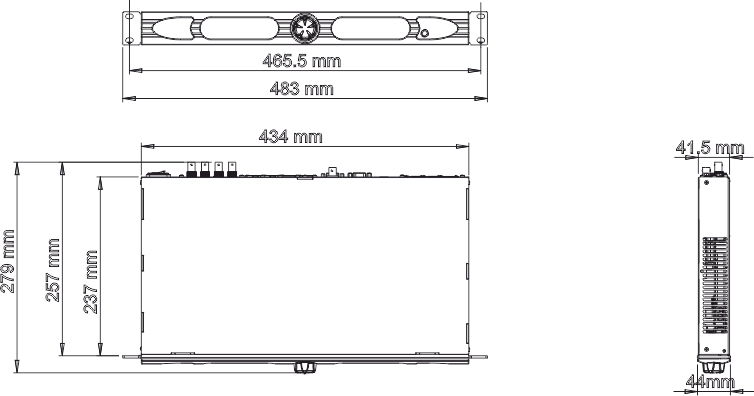
CG Live
Amazing Graphics
CG Live is a software based solution for real time character generation. CG Live features animated backgrounds, movements and effects on text, images, clocks, animated logos, dates, crawl and news tickers. CG Live works via both SDI video boards and via NDI.
The solution is ideal to display graphical contents, such as text, logos and animations, crawls, tickers and rolls with dynamic contents/metadata retrieved from external data sources, like RSS, txt, Microsoft Excel files and more. Top broadcast quality and easy of use allow CG Live to be used for News Graphic, live production in talk shows, sports and entertainment.
CG Live is very simple to use and does not need any specific training. Page compositing is also very user friendly and allows to add multiple object like texts, clocks, crawls, rolls and media (audio, bitmaps, video and animations) e and define their specific aspect in detail.

Broadcast quality
CG Live delivers top quality antialiased text, smooth interlaced crawls, tickers and rolls over SDI or NDI output. All layers are managed in 32 bits allowing precise alpha channel and transparency compositing. Text and media can be updated on the fly allowing to perform in live production environments.

Excel as an App
CG Live imports data automatically from TXT, CSV, RSS feeds and especially Excel files, so whenever data is updated, it goes straight on air. CG Live respects fonts, colors and alignment specified in the Excel files selecting from which sheet and cells to acquire the data. Hidden or unprintable cells will not air, very handy fro comments and remarks to the user inputting the data. CG Live also respects the formulas and database connections specified in the Excel files, allowing to create custom applications with macros and VBA scripting.

Social media
CG Live integrates with Social Hub (optional), which allows retrieving text, images and video clips from your favourite social media sources, such as whatsapp, facebook, instagram, skype, email, sms, openweathermap, line and rss feeds. User can select and edit messages before airing or create them from scratch. If your favourite social media is not among the supported plugins, a special Google Chrome plugin allows capturing text and images directly from the browser window and send them on air. Social Hub is a great add-on for any live program to add dynamic graphical content to the production and engage more efficiently with the audience.

Best of Both World
Included in the CG Live package is also the DLG Plus software, which share the same multimedia engine, allowing interchange of templates and projects. DLG Plus features an easy to use videomixer-like user interface so it can be used both in master control as in production environments. According to the type of interactivity which is needed for a specific production, you can choose which application to deploy.

CG LIVE Features
- HD/SD static and animated graphics and logos
- Antialiased text with gradients, borders and shadows
- Clock, countup/down, date, crawl, ticker and roll
- Template editor with multiple layers
- Preview channel over VGA and SDI/NDI
- TGA, BMP, PNG, TIF, JPG bitmap sequences
- Smooth IN/OUT transition: fade, move, zoom
- 32 Bit images processing with alpha and transparencies
- GPI on TCP/IP (or Rs-232 as option)
- Effects: shadow, blur, motion blur, smooth edge (deflicker)
- Internal key mode (video in – video out) or external key mode (Key and fill outputs)
- Audio output over SDI/NDI in external key mode
- Infinite layers on each page
- Social media integration with Social Hub (sold separately)
- Customizable shortcuts for each page
- Safe area on page composer
- Checkered background on page composer for transparancies highlight
- On the fly text and media change from user lists
- UNICODE texts with double byte language support
- Right to left language support
- Automatic text size adaptation to areas
- TTF fonts support
- Top/bottom/left/right/middle text alignment
- Text foreground, border and backrgound with 10 point color and alpha gradients with custom angle
- Custom identation for precise background alignment
- Fade in/out, move left/right/top/bottom, squeeze X/Y/XY transitions
- Shadows with color, offset and blur which follow animation alpha
- Video file animations in bitmap sequences, GIF, quicktime ANIM and Prores 4:4:4:4
- Video files import in DV, HDV, DVCPRO, MJPEG, MPEG-2, TS, MPG, VOB, H.264, H.265,
- AV1, MP4, QuickTime, PRORES, DNxHD, AVI, WMV, ASF, MXF, XDCAM, IMX, GXF, LXF, FLV, MKV, WebM, HuffYUV, VP8, VC3, JPEG2000, DPX
- Animations and video files in loop/stop at end/ stop at end and hide modes
- Automatic upscale/downscale of media as background
- Media on background outputs audio in external key mode
- Smooth crawls with area and speed selection
- Text, Crawl, roll and ticker datasource from text, CSV, RSS and excel files
- Automatic update of graphics on datasource change
- Excel file support of font, front/back color, alignment and hyperlinks to media
- Smooth tickers with number of lines, timing and transition type
- Multiple shapes with color gradients, outlines and rounded corners
- Date and clock with customizable formatting
- Object layering with priority managemen

